|
|
|
| My Favourite Planet > English > People > Demeter and Persephone |
 |
back |
Demeter and Persephone - Part 1 |
 |
Part 1 of 2 |
 |
|
| |
Demeter and Persephone
Part 1
The mother goddess Demeter (Δημήτηρ), the daughter of Cronus and Rhea and sister of Zeus and Hera, was one of the twelve Olympians, the major deities of the Greek pantheon. Her Roman equivalent was Ceres (the origin of the word cereal).
She was associated with harvests and credited with the gift of agriculture to humans. She was given the epiphets Sito (Σιτώ, She of the Grain) as the giver of corn, and Thesmophoros (Θεσμοφόρος, Law Bringer; from Θεσμός, thesmos, divine order, law, and φόρος, phoros, bringer, bearer) for her part in agricultural society in which civilization and the rule of law developed.
Along with her daughter Persephone (Περσεφόνη, she who destroys the light; to the Romans Proserpina), also known as Kore (Κόρη) and Despoina (Δέσποινα), the Maiden [1], who was abducted by Plouton (Πλούτον, also known as Pluto or Hades, ᾍδης or Ἁιδης), Demeter was associated with the underworld and the cycle of the seasons, life and death. In the Homeric Hymns she is referred to as "rich-haired Demeter, awful goddess", and "Queenly Demeter, bringer of seasons and giver of good gifts". [2]
As with other ancient Greek deities and mythological figures, the tales and traditions concerning Demeter and Persephone varied in different parts of Greece from prehistoric times, and the age, history and nature of their religious significance continue to be subjects of debate. And as ever, many theories have been developed, questioned and refuted. Even their names, attributes and roles in myths, as well their relationships to other deities, particularly Zeus, Poseidon, Plouton, Dionysus and Hekate, remain uncertain. The confusion is deepened by the deliberate secrecy which surrounded the cults of the chthonic (underworld) gods (for example at Samothraki) and the Eleusinian Mysteries.
The name Da-ma-te in Mycenaean Greek inscriptions, written in Linear B script, appears to refer to Demeter, and some scholars believe she may have even been a Great Goddess of Minoan religion. In modern times she has been seen as primarily an agricultural deity, worshipped by farmers as the goddess who taught humans the arts of crop-growing. However, the relationships of Demeter and Persephone to other deities as forces of nature above, on and beneath the earth, point to more essential, pre-agricultural questions of existence, such as the workings of nature, the cycle of the seasons and life beyond death.
The various stories, beliefs and practices from across the Greek world, with influences from other cultures, were adapted and developed over centuries or even millenia. The earliest literary mentions of Demeter and Persephone appeared from the time of Homer and Hesiod, and the Homeric and Orphic hymns, while most information is provided by writers of the Roman period, such as Pausanias.
The local stories of Demeter and Persephone differ in several details, but the generally accepted narrative of classical Greece is that Demeter was responible for seasonal growth and regeneration on the earth. Persephone was the virgin daughter of Demeter and Zeus, although in some places Poseidon was believed to be her father (see below). She was abducted by Plouton, perhaps with the collusion of Zeus, and taken to his underworld kingdom. Unaware of this, Demeter searched for her missing daughter above the earth without success, and as she grieved she neglected her duties; the progression of the seasons and the growth of plants ceased, and all life was threatened with extinction.
Eventually, Zeus intervened and sent Hermes to persuade Plouton to release Persephone. Plouton agreed, on condition that she returned to spend part of each year with him in Hades. According to some versions of the myth, Persephone ate, or was tricked into eating by Plouton, a number of pomegranate seeds on her return from the underworld, and was bound to remain there each year for one month for each seed eaten. On Persephone's return, Demeter once again allowed the seasonal growth to continue.
Thus Persephone represented the fecundity of the earth, and while she was above ground with her mother plant-life thrived, but during her period in the underworld growth ceased. Although the latter period has been thought by some to be winter, it may have been the dry summer months, when in Greece and around the Mediterranean many plants wither and die. Modern Greek farmers have to artificially water plants in summer, a luxury option unavailable to their ancient counterparts, and many of the crops which are now grown through the summer months, such as maize, tomatoes, tobacco and cotton, were not cultivated in ancient Greece.
According to other tales, while Demeter was searching for her daughter and in despair, she was offered hospitality in Eleusis by King Keleos (Κελεός) and Queen Metaneira (Μετάνειρα), in return for which the goddess taught their son Triptolemos (Τριπτόλεμος) the secrets of grain cultivation and sent him on a winged chariot with the mission of spreading the knowledge to humanity (see below and Part 2). Such stories also feature other characters included in the Eleusinian Mysteries, such as Demophon and Eubouleus (see Part 2).
Worship of Demeter and Persephone included a mystery cult, particularly popular among women, which had its most important centre at Eleusis, northwest of Athens (see below). Most of the details of the cult are unknown since initiates were sworn to secrecy. As the Greek historian Herodotus wrote of the Thesmophoria, the annual festival of secret rituals traditionally connected with fertility and marriage customs, and intially attended only by women:
"And of the mystic rites of Demeter, which the Hellenes call Thesmophoria, of these also, although I know, I shall leave unspoken all except so much as piety permits me to tell." [3]
Over 500 years later the travel writer Pausanias, when describing Eleusis, also declined to reveal details of the interior of the sanctuary or what went on there:
"My dream forbade the description of the things within the wall of the sanctuary, and the uninitiated are of course not permitted to learn that which they are prevented from seeing." [4]
The cult spread throughout the Greek world from at least the Archaic period, and sanctuaries were established as far afield as Dion, Pella (see below) and Amphipolis in Macedonia, Megara Hyblaia and Selinous, Sicily, and particularly at Gela on the south coast of Sicily (see Part 2), an important cult centre. [5]
As in the case of other Olympian gods, Demeter's cult probably assimilated the worship of more ancient local deities such as the Phrygian mother goddess Kybele at the Greek cities of Anatolia (Asia Minor).
In myth and worship, Demeter and Persephone were in many cases inseparable, and of the many extant statues, figurines, busts and reliefs associated with their cult it is often impossible to say whether the mother or daughter is depicted due to the lack of distinguishing attributes.
Demeter is often shown seated (enthroned) with Persephone attending her, standing with a long torch. However, according to variations on the myth, Hekate took the place of Persephone while the latter was in the Underworld. Some representations of this scene have been interpreted as seated Artemis attended by Hekate (for example, a votive relief dedicated by Attic Launderers, see below).
"Hail, goddess, and save this people in harmony and in prosperity, and in the fields bring us all pleasant things! Feed our kine, bring us flocks, bring us the corn-ear, bring us harvest! and nurse peace, that he who sows may also reap. Be gracious, O thrice-prayed for, great Queen of goddesses!"
Callimachus (Καλλίμαχος, circa 310–240 BC), Hymn VI To Demeter, lines 134-138, translated by Alexander William Mair. In: Callimachus, Lycophron, Aratus, pages 125-135. English translations by Alexander William Mair and Gilbert Robinson Mair. Loeb classical Library. William Heinemann, London and G. P. Putnam's Sons, New York, 1921. At the Internet Archive.
| |
References to Demeter
on My Favourite Planet |
| |
The sanctuaries of Demeter and Isis
in Dion, Macedonia, Greece:
Dion: the garden of the gods
at The Cheshire Cat Blog |
|
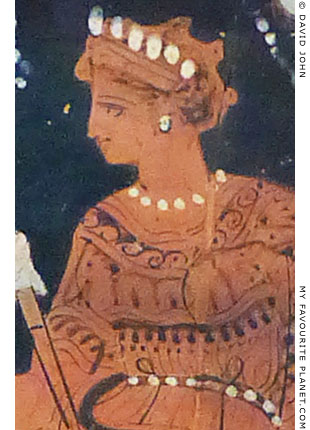
Demeter at the Eleusinian Mysteries.
Detail of the "Ninnion Tablet" from Eleusis.
See Further details below. |
| |
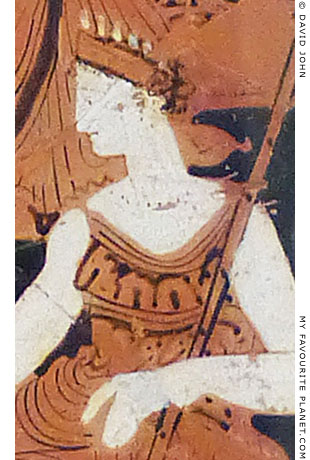
Persephone at the Eleusinian Mysteries.
Detail of the "Ninnion Tablet" from Eleusis. |
| |
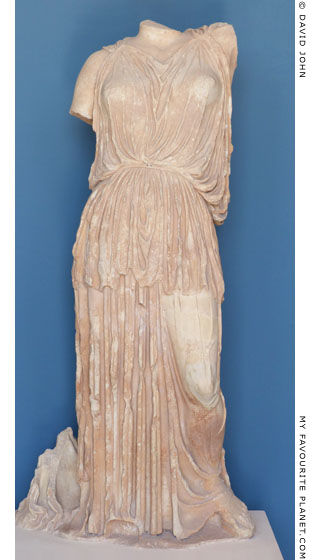
An over-lifesize marble statue of Demeter
from Eleusis. Thought to have made in
the workshop of Agorakritos of Paros,
circa 420 BC.
Pentelic marble. Height 180 cm.
The goddess wears a sleeveless Ionic
chiton and a Doric peplos, and was
probably lifting the edge of her peplos
over her left shoulder with her left
hand, as in the relief below.
Eleusis Archaeological Museum.
Inv. No. 5076. |
| |
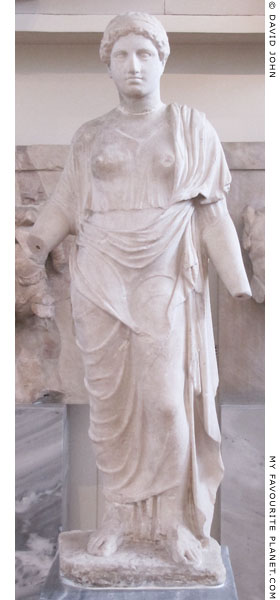
Marble statue of Persephone.
Pentelic marble. Work of the school of
Agorakritos of Paros, circa 420-410 BC.
Found on the hill of Mounychia, Piraeus.
The goddess would have originally
held a torch in each hand.
National Archaeological Museum,
Athens. Inv. No. 176.
See more depictions of Demeter,
Persephone and related deities in
Demeter, Persephone Part 2. |
| |
| |
| |
Sanctuaries of Demeter and Persephone
Eleusis |
 |
|
| |
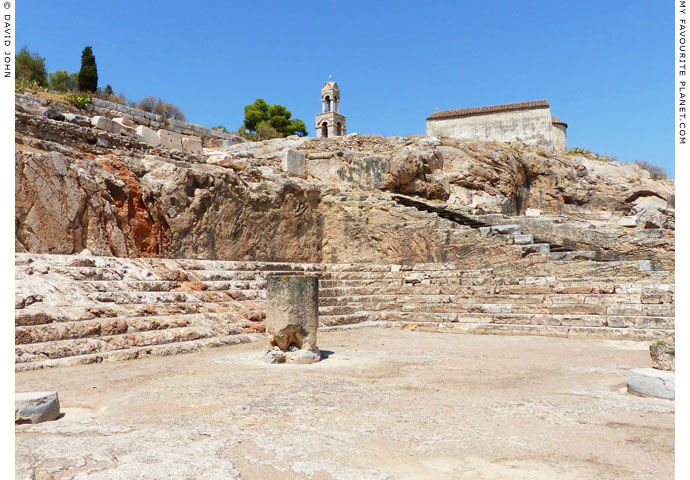
Part of the seating area of the Telesterion in the Sanctuary of Demeter and Persephone at Eleusis.
|
Eleusis (Ἐλευσίς; today Elefsina, Ελευσίνα), on the west coast of Attica, northwest of Athens, was the centre of the mystery cult of Demeter and Kore, and the main focus of the annual festival of the Greater Mysteries [6]. The Telesterion (Τελεστήριον, thank-offering for success), the temple of Demeter and Persephone, was an enormous hypostyle hall in which initiation to the Mysteries took place. According to ancient authors, the rituals of the initiation, which included the recital of sacred texts and the display of sacred objects (hiera) by the Hierophant (Ιεροφάντης, Revealer of Sacred Things), the high priest of the Eleusinian cult, produced a transcendental experience and encouraged a positive view of life after death.
"... among the many excellent and indeed divine institutions which your Athens has brought forth and contributed to human life, none, in my opinion, is better than those mysteries. For by their means we have been brought out of our barbarous and savage mode of life and educated and refined to a state of life and educated and refined to a state of civilization; and as the rites are called 'initiations', so in very truth we have learned from them the beginnings of life, and have gained the power not only to live happily, but also to die with a better hope."
Cicero (1st century BC), De legibus, 2.14.36.
The hall was gradually increased in size over centuries, and expanded around the Anaktoron, the original 7th century BC cult building. There were tiers of seating on all four sides of the hall from which initiates observed the rituals. In the photo above are the remains of the northwest corner of the building, with seats carved from the rock of the foot of the acropolis hill. The Roman architect and author Vitruvius (circa 80-70 - circa 15 BC) placed the Telesterion among four renowned temples of outstanding quality in the Graeco-Roman world, and named Iktinos (mid 5th century BC) and later Philon of Eleusis (mid-late 4th century BC) as two of the architects who enlarged the building.
"There are, in fact, four places possessing temples embellished with workmanship in marble that causes them to be mentioned in a class by themselves with the highest renown. To their great excellence and the wisdom of their conception they owe their place of esteem in the ceremonial worship of the gods ...
At Eleusis, the cella of Ceres and Proserpine, of vast size, was completed to the roof by Ictinus in the Doric style, but without exterior columns and with plenty of room for the customary sacrifices.
Afterwards, however, when Demetrius of Phalerum was master of Athens, Philo set up columns in front before the temple, and made it prostyle. Thus, by adding an entrance hall, he gave the initiates more room, and imparted the greatest dignity to the building."
Vitruvius, Ten Books on Architecture, Book 7, Introduction. At Project Gutenberg.
The final building was destroyed by fire around 170 AD and was reconstructed by Emperor Marcus Aurelius.
See also:
A plan of the Sanctuary of Demeter and Persephone at Eleusis below.
The "Ploutonion" at Eleusis in Part 2. |
|
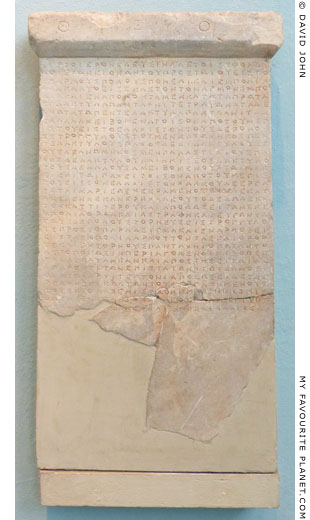
Three fragments of a stele of Eleusinian
marble with an inscription referring to
the manufacture of bronze dowels (poloi
and empolia) for the columns of the Stoa
of Philon (or Philonian Stoa).
Circa 336 BC. Found in Eleusis in 1893
by Demetrios Philios [see note 8].
Eleusis Archaeological Museum.
Inv. No. 5040.
Inscription IG II² 1675 (I.Eleusis 157). |
|
| |
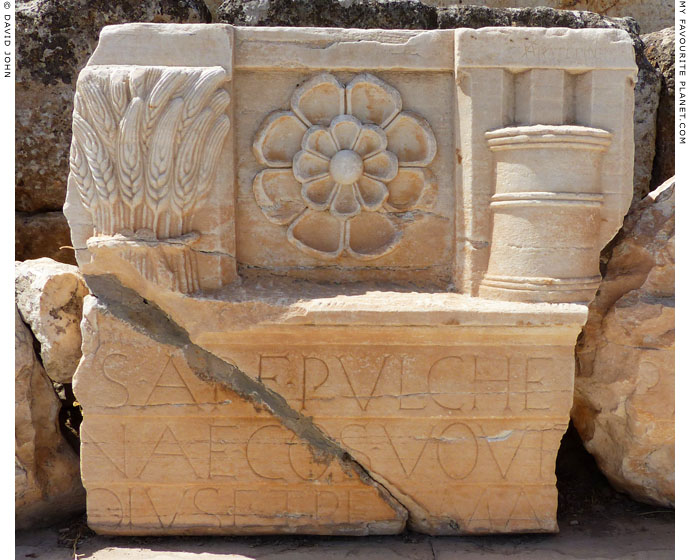
Part of the inscribed marble entablature of the outer facade of the Lesser Propylaia,
the inner gateway of the Sanctuary of Demeter and Kore at Eleusis, built circa
50-48 BC, late Roman Republican period.
Eleusis archaeological site. Inv. No. 1039. Inscription: Corpus inscriptionum latinarum I 619.
|
The Roman period Lesser Propylaia, protected by a fortification wall, replaced the Archaic north gate, the main entrance to the sanctuary, built in the 6th century BC during the Peisistratid period. The sanctuary was later extended northwards to the Greater Propylaia (an exact copy of the central section of the Propylaia of the Athenian Acropolis), built by Emperor Marcus Aurelius (reigned 169-180 AD).
The triglyphs of this fragment are decorated with a relief of a sheaf of wheat (left), a symbol of Demeter, and the sacred kiste, the container in which the sacred objects of the Mysteries were kept. The metope has a relief of a rosette, thought to be a stylized poppy, another symbol of Demeter. Unusually for Eleusis, the inscription is in Latin rather than Greek, due to the gateway's dedication by Appius Claudius Pulcher, who was Consul in Rome in 54 BC. Pulcher died before the propylaia was built, and it was completed by his nephews Claudius Pulcher and Marcius Rex.
The roof on the inner facade, on the side facing the Telesterion, was supported by two kistephoros caryatids. Each of the sculpted female figures wears crossed bands around the shoulders, supporting a Gorgoneion (head of the Gorgon Medusa) between the breasts. On each head is a cylindrical kiste decorated with reliefs of a kernos, ears of corn, poppies and rosettes.
One of the caryatids is now in the Eleusis Archaeological Museum (see photo, right). The other, not so well preserved caryatid was seen by early northern European travellers to Greece in the 17th and 18th centuries, who believed it to part of a statue of Demeter or Persephone. It was removed from Eleusis by Edward Daniel Clarke in 1801, and is now in the Fitzwilliam Museum, Cambridge, Inv. No. GR.1.1865 [7].
See the marble bust of Marcus Arelius from the pediment of the Greater Propylaia on the Medusa page. |
|
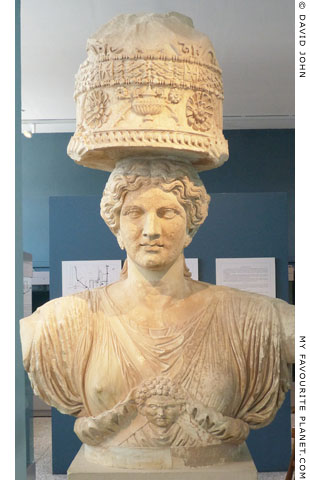
A caryatid (or kistephoros) from the
facade of the Lesser Propylaia.
Pentelic Marble. Circa 50 BC.
Height 196 cm, width 150 cm.
Eleusis Archaeological Museum.
Inv. No. 5104. |
|
| |
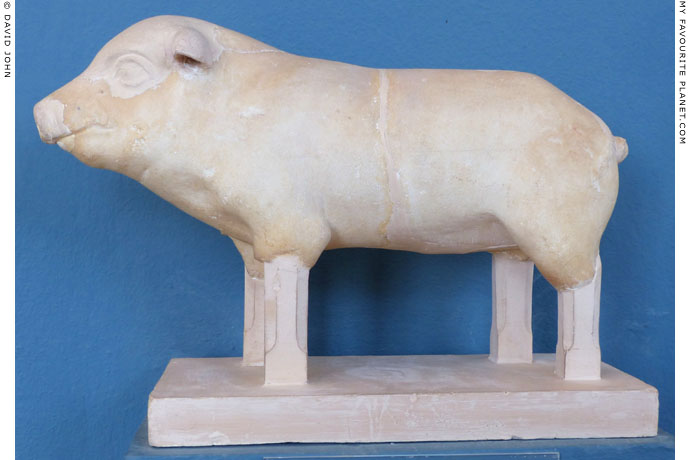
Marble votive statue of a piglet from the sanctuary at Eleusis.
Roman period. Pentelic marble. Length 40 cm.
Eleusis Archaeological Museum. Inv. No. 5053. |
| |
Each initiate to the cult of Demeter (μὐστης, mystis; plural, μὐσται, mystai) was obliged to sacrifice a small pig at the beginning of the celebration of the Greater Mysteries (Μεγάλα Ελευσίνια, Megala Elefsinia). In the early morning of the second day all participants, who were still in Athens after the celebration of the Lesser Mysteries (Μικρά Ελευσίνια, Mikra Elefsinia), would shout, "To the sea, o Mystai!" and travel to the seaside (perhaps Phaleron or Piraeus) to cleanse themselves and their pig in the sea as part of the purification process. After bathing each had to sacrifice their own pig, probably after they had returned to Athens.
See also a figurine of a pig from the Pella Thesmaphorion below.
Pausanias related a strange custom concerning piglets in the megara of the sanctuary of Demeter and Persephone at Potniae, near Thebes:
"Across the Asopus, about ten stades distant from the city, are the ruins of Potniae, in which is a grove of Demeter and the Maid. The images at the river that flows past Potniae ... they name the goddesses. At an appointed time they perform their accustomed ritual, one part of which is to let loose young pigs into what are called 'the halls' (megara). At the same time next year these pigs appear, they say, in Dodona. This story others can believe if they wish."
Pausanias, Description of Greece, Book 9, chapter 8, section 1. At Perseus Digital Library.
According to the Roman mythographer Hyginus, the first sacrifice of a pig to Demeter was made by Triptolomos, who he also credited with establishing the Thesmophoria (see part 2):
"Ceres showed how to tame oxen, and taught her foster-son Triptolemus [to sow grain]. When he had sown it, and a pig rooted up what he had planted, he seized the pig, took it to the altar of Ceres, and putting grain on its head, sacrificed it to Ceres. From this came the custom of putting salted meal on the victim."
Hyginus, Fabulae, sections 200-277, section 277, First inventions. At the Theoi Project.
For further information about Hyginus, see the note in Homer part 2. |
|
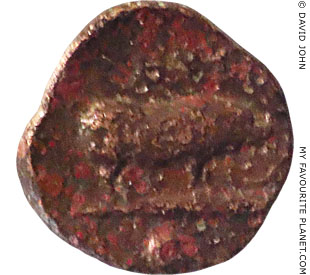
An Athenian coin with Eleusinian symbols.
On this side a pig, tghe sacred animal of
the Eleusinian Mysteries. On the other
side Triptolemos, the mythical king of
Eleusis, in his flying chariot (see part 2).
4th century BC.
Eleusis Archaeological Museum. |
|
| |
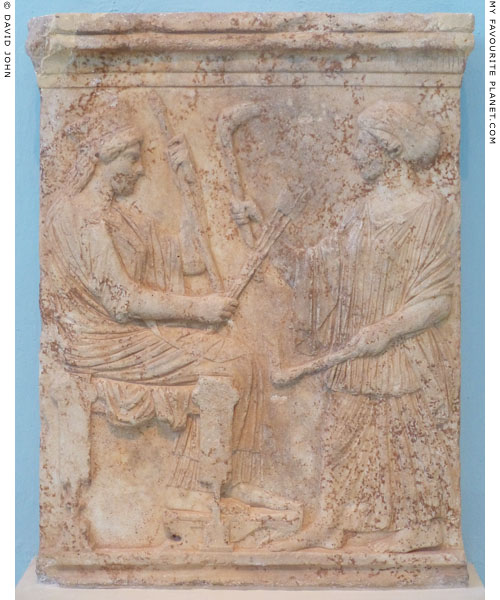
Marble votive relief depicting Demeter enthroned, and Persephone (Kore)
or Hekate standing with two torches, one raised and the other lowered.
From Eleusis. First quarter of the 5th century BC.
Height 78 cm, width 56 cm, thickness 9-12 cm.
Eleusis Archaeological Museum. Inv. No. 5085.
|
| This is the oldest surviving sculptural representation of Demeter from Eleusis. According to George Mylonas [see note 6] and others, the figure on the right may be Hekate, or even a priestess, rather than Persephone. There are several variations on the myth of Demeter and Persephone. In the Homeric Hymn to Demeter, Hekate assists Demeter in her search for Persephone who has been abducted by Hades, and later becomes Persephone's attendant in the Underworld. |
|
|
| |
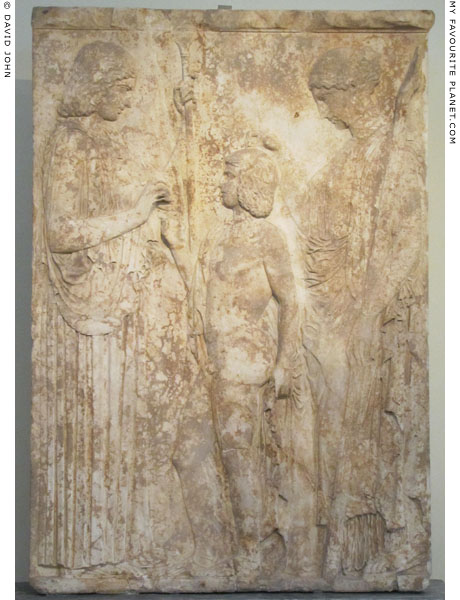
"The Great Eleusinian Relief", a marble stele from Eleusis with
a votive relief showing Demeter, Triptolemos and Persephone.
Pentelic marble, circa 440-430 BC. Found in Eleusis in 1859.
Height 218 cm, width 152 cm, depth 21.5 cm, depth of relief 3 cm.
The figures are slightly over life-size.
National Archaeological Museum, Athens. Inv. No. 126.
|
The discovery of the stele was a chance find. It had been reused as a paving stone on the floor of the Church of Saint Zacharias (Άγιος Ζαχαρίας), outside the sanctuary. [8]
This relief is thought to depict a scene central to the cult of Demeter and Persephone, the myth of how Demeter (left, holding a sceptre) gave ears of wheat to the young Triptolemos (Τριπτόλεμος, threefold warrior), son of the Eleusinian King Keleos, as the gift of agriculture to mankind (see note 11 and photos in Part 2). However, it has also been suggested that the boy may be Iakchos, Ploutos, Demophon, Eumolpos, Initiate from Hearth, Nisos or even an ordinary initiate. The wheat and the goddess's crown are not visible on the relief and were probably attachments or painting. Demeter's daughter Persephone, standing to the right with a torch, blesses the boy by placing her right hand over his head.
Pausanias wrote that there was a temple of Triptolemos at the entrance to the sanctuary at Eleusis.
"The Eleusinians have a temple of Triptolemus, of Artemis of the Portal, and of Poseidon Father, and a well called Kallichoros (Lovely dance), where first the women of the Eleusinians danced and sang in praise of the goddess. They say that the plain called Rharium was the first to be sown and the first to grow crops, and for this reason it is the custom to use sacrificial barley and to make cakes for the sacrifices from its produce. Here there is shown a threshing-floor called that of Triptolemus and an altar."
Pausanias, Description of Greece, Book 1, chapter 38, section 6. At Perseus Digital Library.
The Kallichoros well is to the left of the entrance to the sanctuary. The location of the plain of Rharium (or Rarian meadow) is unknown. For further information about the cakes used in the cult of Demeter and Persephone see Corinth and Isthmia, Pella and Delos below. |
|
|
| |
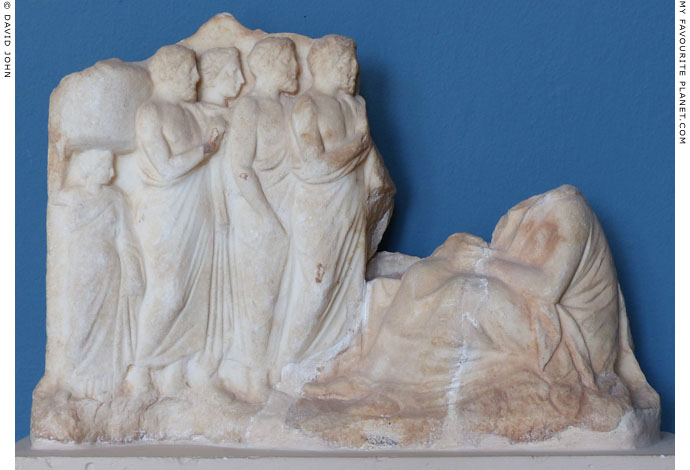
Fragment of a marble votive relief depicting Demeter disguised as an old woman, facing left,
sitting on the "Mirthless Stone" (ot "Mirthless Rock"; Αγέλαστος Πέτρα, Agelastos Petra,
literally smile-less stone or stone without laughter) on which she rested during her search
for Persephone. She is approached from the left by five worshippers, conventionally depicted as
a smaller scale: three men, a woman and a girl, perhaps a slave, carrying a basket on her head.
From Eleusis. Around 330-320 BC. Length 46 cm.
Eleusis Archaeological Museum. Inv. No. 5066. |
| |
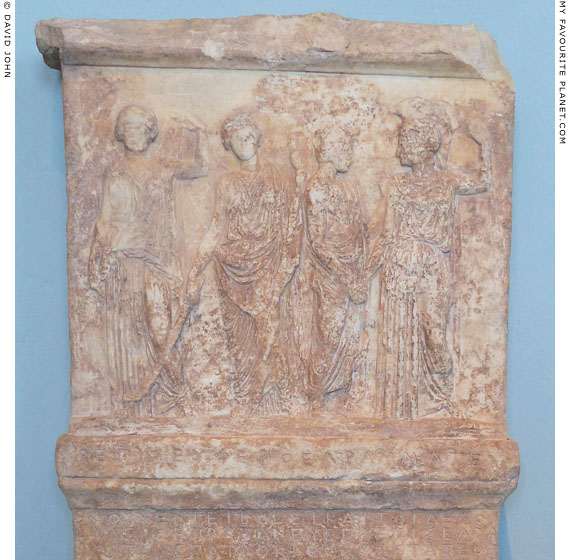
The upper part of the "Rheitoi Decree" stele, an inscribed marble stele with a decree
concerning the building of a bridge over the Rhetoi Lake (Λίμνη Ῥειτοὶ, today called
Lake Koumoundourou, Λίμνη Κουμουνδούρου), actually a lagoon next to the sea, on
the marshy Thrasian Plain near Eleusis. The 1.5 metre wide bridge was part of the
Sacred Way (Iera Odos) between Athens and Eleusis.
The relief at the top of the stele shows four female figures, from left to right:
Demeter, Persephone and the personification of the Demos of Eleusis clasping
hands with Athena, personifying Athens.
421-420 BC. Found in fortification wall near Greater Propylaia of Eleusis in 1887.
Present height of stele 90 cm, width 53 cm.
Eleusis Archaeological Museum. Inv. No. 5093. Inscription IG I³ 79.
|
| The relief depicts four figures standing side by side, three females and a male. All the female figures wear peploi. On the far right of the relief Athena, wearing a crested Attic helmet and holding a spear, is shown frontally with her head turned to the left to face a young man wrapped in a himation, depicted as slightly smaller and in profile, thought to be either the personification of the Demos of Eleusis or a local hero, perhaps Triptolemos. On the left Demeter and Persephone are shown frontally. Demeter lifts the edge of her peplos over her left shoulder (as in another relief from Eleusis, see Part 2). Persephone holds two torches, that in her left hand is raised, while the one in her right hand is lowered, mirroring the pose of the figure in the relief above. |
|
|
|
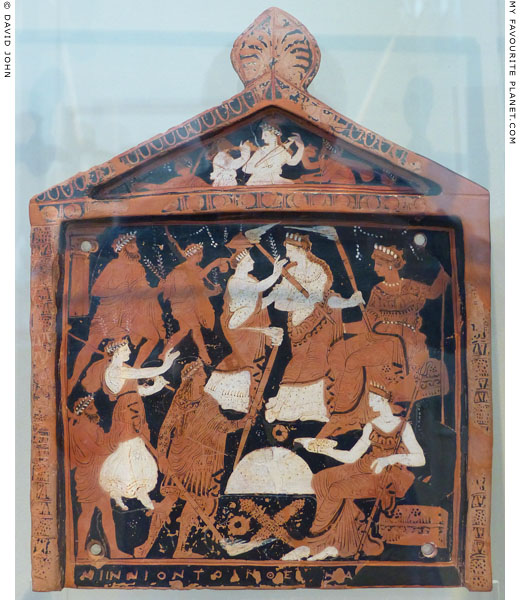
The "Ninnion Tablet", a terracotta votive pinax (painted plaque) [9], dedicated by a
woman named Ninnion to Demeter and Persephone at Eleusis. The pinax, in the form
of a naiskos (ναΐσκος, small temple), depicts the religious rites of the Eleusinian Mysteries.
Made in Attica, dated to around 370 BC. Found in Eleusis in 1895.
Height 44.5 cm, width 33 cm.
National Archaeological Museum, Athens. Inv. No. 11036.
|
The "Ninnion Tablet" was found in nine fragments, to the south of the Telesterion at Eleusis, during excavations directed by the Greek archaeologist Andreas Skias (Ανδρέας Σκιάς, 1861-1922). The four holes in the pinax indicate that it was hung on a wall, perhaps at the Telesterion itself.
The inscription on the base states that the pinax was dedicated by a woman named Ninnion to the "two goddesses": ΝΙΝΝΙΟΝ ΤΟΙΝ ΘΕ[ΟΙ]Ν Α[ΝΕΘΗΚΕN] (NINNION TOIN THEOIN ANETHIKEN). It was scratched on the ceramic surface after it had been fired, and it has been suggested that the pinax was sold ready-made and then dedicated by the purchaser.
It is generally agreed by scholars that the pinax is unique in depicting one or more rituals of the secret Eleusinian Mysteries (Ἐλευσίνια Μυστήρια). However, the very secrecy surrounding the Mysteries and the puzzling iconographies of surviving ancient artworks associated with them have so far made an entirely convincing interpretation of the persons, objects, symbols and activities painted on the plaque impossible. There have been several attempts to decipher exactly who and what is represented, whether the main scene depicts one ritual or two separate phases of the rites, or whether the action takes place at the Lesser or Greater festival. [note 6]
Below is an attempt to describe the paintings on the pinax, roughly following the museum labelling, with caveats, probablys and maybes. |
|
|
| |
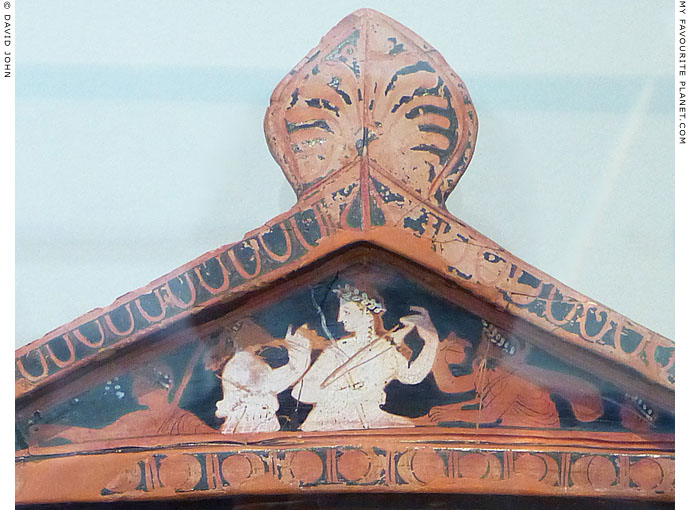
Detail of the pediment (gable) of the naiskos on the "Ninnion Tablet".
|
The pediment of the naiskos is topped by an akroterion in the form of an ancathus leaf.
The painting on the pediment may depict participants at the pannychis, the sacred all-night feast. The central figure, perhaps a deity, priestess or initiate, wearing a wreath and with a kernos (a sacred vessel) fastened to his/her head, is surrounded by four figures, also wreathed. The two outside figures are youths; the female figure left of the central figure appears to be playing pipes (the surface is too damaged to be certain); the bearded male figure to the right holds a jug or cup.
The central figure is too indistinct to make a certain identification, and the depiction of the faces of the figures in the main scene (see below) too similar to make a comparison. White has been used for all the female figures on the pinax, except Demeter, whereas all the males are completely red. The facial features, hairstyle and garment (white with a pattern of black dots) of this figure are very similar to those of the female torch-bearer in the main scene. It is, then, most likely a female (Persephone or Hekate?), although it has been suggested that it could be Dionysus, who was associated with the Mysteries. The archaeologist George E. Mylonas [note 6] was of the opinion that Dionysus does not appear on the pinax.
Below this is a row of what appear to be lunar discs and crescents in various positions. It is not known whether these have an astronomical significance, but they may be related to the myth of Demeter and Persephone or the rites and festivals. |
|
|
| |
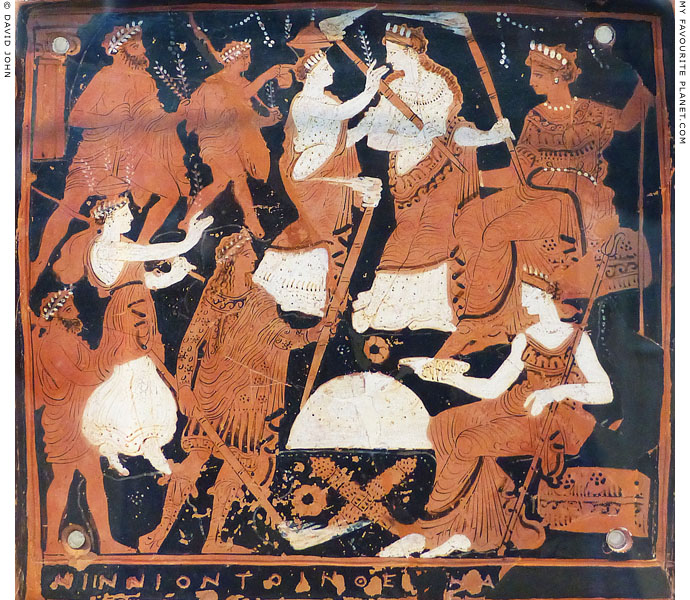
The main scene of the "Ninnion Tablet".
|
The main scene appears to depict the arrival of initiates at the sacred rites, and their meeting with Demeter and other deities.
The figures are arranged in two rows. At the top right Demeter, holding a staff in her left hand and seated on the "cista mystica", the secret chest (kiste) which contained the sacred objects of the Mysteries. According to another interpretation she is sitting on the "Mirthless Stone" (see above). Left of her stands Persephone, holding two torches, and below her Iakchos (Ἴακχος) the torch-bearer, receive a procession of men and women initiates arriving at the sanctuary, all crowned with myrtle wreaths and holding blossoming branches and staffs. Each woman has a kernos, a sacred vessel (see photos below), fastened to her head.
In the centre of the lower row are the wreathed omphalos above intersecting bakchoi (a bakchos was a mystic myrtle staff), symbols of the mystery rites. The seated female figure at the bottom right may be a deity, a priestess of Demeter or Ninnion herself.
Alternatively, The female figure with the torches to the left of Demeter may be the goddess Hekate, and the seated figure below may be Persephone. |
|
|
| |
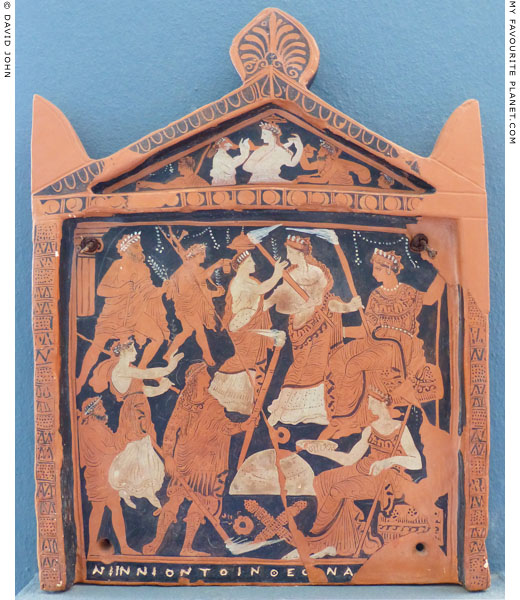
A modern copy of the "Ninnion Tablet" in the museum at Eleusis.
The replica was commissioned by the Greek Ministry of Culture,
and made in 2009 by Thomas Kotsigiannis.
Another replica of the pinax was made by the Swiss artist
Émile Gilliéron (1850–1924) shortly after its discovery.
The copy has the advantage of not being displayed behind glass,
and therefore it is easier to look at without reflections or shadows.
Eleusis Archaeological Museum. |
| |
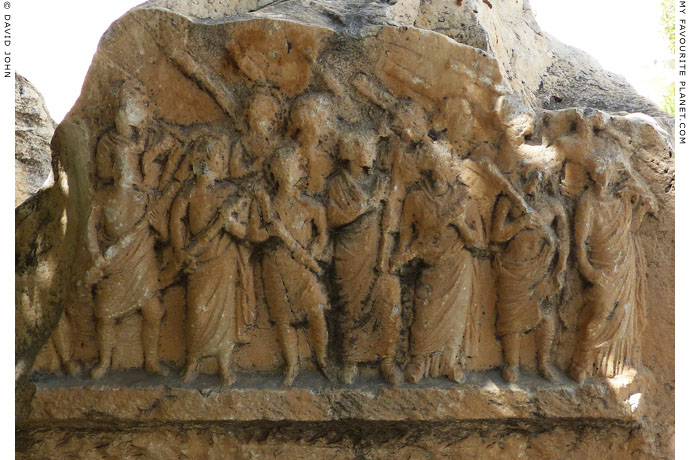
Fragment of a statue base with a relief showing Eleusinian initiates in
a procession, each carrying a bakchos (βάκχος), the mystic myrtle staff.
Pentelic marble. Roman period, around 150 AD, during the reign
of Antinonus Pius (138-161 AD). Height 124 cm, width 95 cm.
Outside the Eleusis Archaeological Museum. Inv. No. E 1143.
|
This is one of two fragments of the statue base displayed unlabelled in the courtyard of the Eleusis museum. The base is believed to have supported a now lost bronze portrait statue of Lucius Nummius Nigreinos from the Attic deme of Gargettos (Γαργηττός), who served as a sacred herald (ἱεροκῆρυξ, hierokerys) in the Eleusinian Mysteries, probably erected in the sanctuary shortly after his death.
It was decorated on three sides by similar low reliefs of male and female bakchos-bearing initiates of the Eleusinian mysteries. The reliefs may represent the Great Procession of intitiates from Athens to Eleusis led by priests and cult officials. It has also been argued that they are repetitions of a single scene rather than a continuous tableau, and that Nummius Nigreinos himself appears on all three. The best preserved relief, in the photo above, may show him in the centre of the front row.
The subject of the statue was identified by the dedicatory inscription at the top of the base, which is now broken off and lost, but which was copied by both Jacob Spon and George Wheler in 1676 (see drawing below).
Νού[μμιος] Νιγρεῖνος ἱεροκῆρυξ
Noummius Nigreinos, sacred herald
Inscription IG II² 3574 (I.Eleusis 462).
From George Wheler, A journey into Greece, pages 428-429. London, 1682.
See: Iphigeneia Leventi, The relief statue base of Nummius Nigreinos, sacred herald of the Eleusinian mysteries. The iconography of Eleusinian cult initiates and officials in Roman Imperial times. In: Cristina-Georgeta Alexandrescu (editor), Cult and votive monuments in the Roman provinces. Proceedings of the 13th International Colloquium on Roman Provincial Art, 2013, pages 63-72. Mega Publishing House, Cluj-Napoca, Romania, 2015. At academia.edu.
The illustrated article discusses the reliefs, also with reference to the "Ninnion Tablet" (see above) and the hierophant relief from the Olympieion in Athens (see below). Includes a bibliography. |
|
|
| |
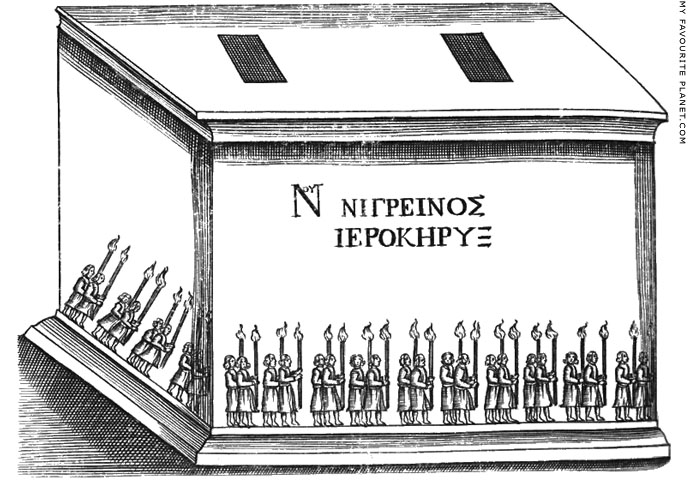
A drawing by George Wheler of what is thought to be the same statue base
in Eleusis, made in 1676, when the base was still intact and with the inscription.
|
Like other illustrations in Spon and Wheler's accounts of their journey together through Italy, Turkey and Greece, which they published separately, the drawing of the base is rough and bears little resemblance to the actual object. They believed it to be the base for the caryatid they also saw in the sanctuary, which they took for a statue of Demeter (see above).
"A little higher on the brow of the hill we found a large basis for a statue, which we judg'd to belong to that of the goddess. There was written upon it only ΝΟΥ ΝΙΓΡΕΙΝΟΣ ΙΕΡΟΚΗΡΥΞ Noumilius Nigrinos, priest; which perhaps, was the name of him that erected the statue. But that which is most remarkable about it, is a small basso-relievo, representing the Procession of Ceres, used to be made by the Athenians, in memory of her going about the world, in search of her daughter Proserpina, stollen by Pluto, after she had lighted her torches at Mount Aetna. The whole multitude carry flambeau's they call Δαδία; and to them belonged officers, whom they call'd Δαδῦχοι; being, I suppose, the chief regulators of that ceremony."
George Wheler, A journey into Greece in company of Dr Spon of Lyons, Book VI, pages 428-429, drawing on page 429. William Cademan, Robert Kettlewell, and Awnsham Churchill, London, 1682. At Googlebooks.
Another drawing of the base appeared in Spon's book (image right). Both illustrations show a relief at the bottom of the front of the base depicting pairs of people, walking to the right, each holding a lighted torch. However, Spon's base, which is taller and with the inscription in the top left corner, has seven pairs, while Wheler's has ten. The passages in both books describing the bases are almost indentical, but Spon's (in French) refers to the dedicator as "Noumenius Nigrimus" (a printing error?), "Héraut sacré des Desses" (sacred herald of the goddess).
Jacob Spon and George Wheler, Voyage d'Italie, de Dalmatie, de Grece, et du Levant, faités années 1675 et 1676, Tome II, pages 216-217, drawing on page 216. Henry & Thedore Boom, Amsterdam, 1679. At the Internet Archive. |
|
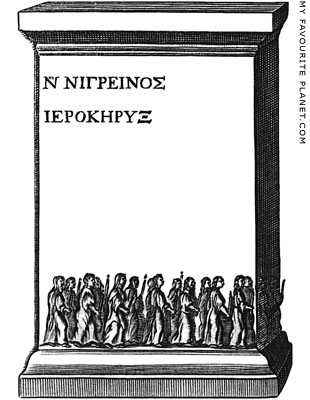
The drawing of the statue base
in Jacob Spon's book. |
|
| |
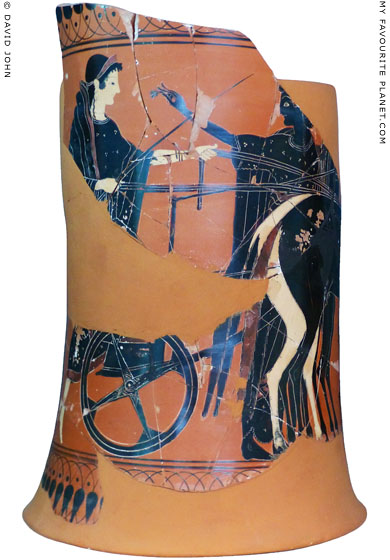
Restored fragments of a black-figure krater stand with a painting
of a goddess, perhaps Demeter, on a four-hourse chariot.
Apollo (?), holding a kithara, offers her a flower. At the front of
the horses (not visible in photo) stand Artemis (?) and Hermes.
Found in Pyre B', the Telesterion, Eleusis. Made in the workshop
of the Madrid Fountain Painter, around 520-510 BC.
The other side shows Artemis (?) and Hermes.
Eleusis Archaeological Museum. Inv. No. 468. |
| |
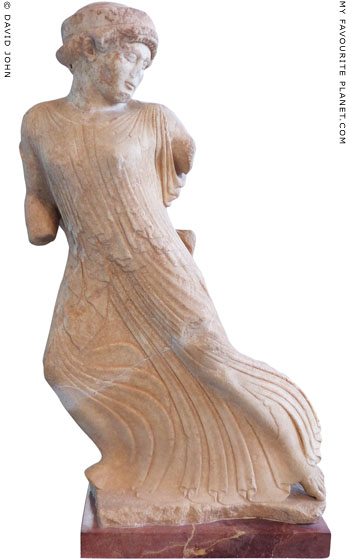
Statue of a fleeing maiden from the pediment
of the Sacred House in Eleusis. 490-480 BC.
Height 64.5 cm.
The relief on the pediment depicted the
abduction of Persephone, and this figure may
represent one of the daughters of Okeanos.
Eleusis Archaeological Museum. Inv. No. 5235. |
|
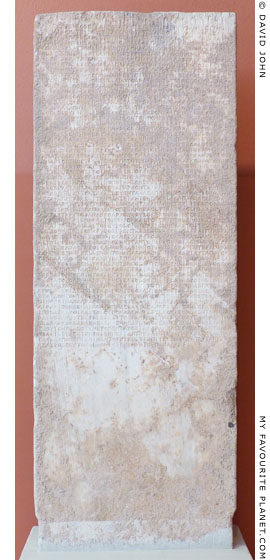
Marble stele inscribed with an Athenian
decree concerning the Eleusinian first
fruits of the harvest (ἀπαρχαί, aparchai)
for Demeter and Kore. [10]
From Eleusis. Circa 422 BC.
Height 133 cm, width 50 cm, depth 9.5 cm.
Epigraphical Museum, Athens.
Inv. No. EM 10050. Inscription IG I³ 78. |
|
| |
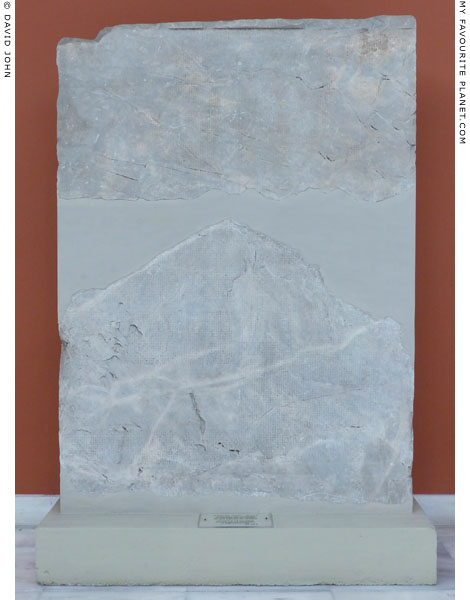
Fragmentary marble stele inscribed with the accounts of the Eleusinian
Epistatai and the treasures of Demeter and Kore. 329/328 BC.
Epigraphical Museum, Athens. Inv. Nos. EM 10048 + 10051.
Inscription IG II² 1672. |
 |
|
|
| |
| |
 |
| |
 |
| |
 |
| |
 |
| |
 |
| |
 |
| |
George Alvanos
rooms in
Kavala's historic Panagia District
Anthemiou 35,
Kavala, Greece
kavalarooms.gr
|
| |
Olive Garden Restaurant
Kastellorizo,
Greece
+30 22460 49 109
kastellorizo.de
|
| |
Papoutsis
Travel Agency
Kastellorizo,
Greece
+30 22460 49 286
greeklodgings.gr
|
| |
| |
| |
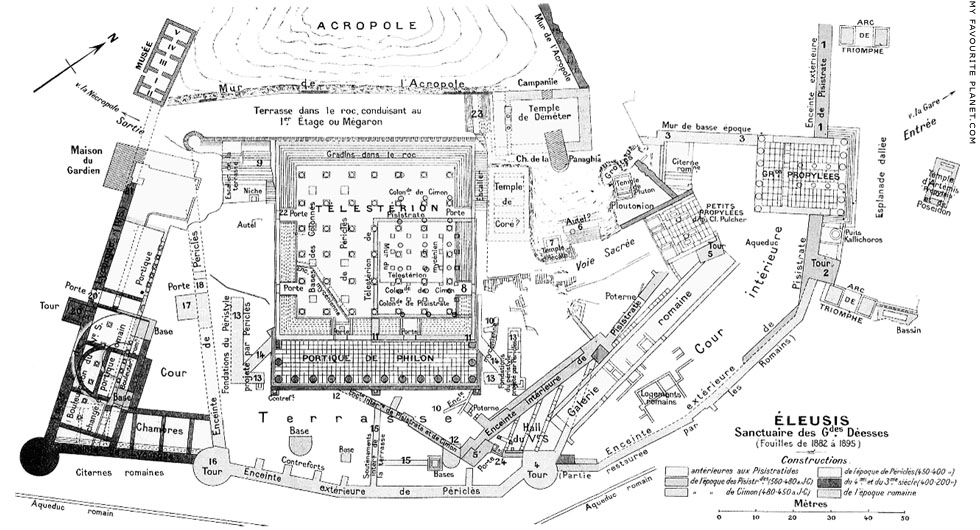
Plan of the Sanctuary of Demeter and Persephone at Eleusis.
Source: Gustave Fougères, Grèce I: Athènes et ses environs.
Guides Joanne, Libraire Hachette, Paris, 1906. |
| |
| |
Sanctuaries of Demeter and Persephone
Athens |
 |
|
| |
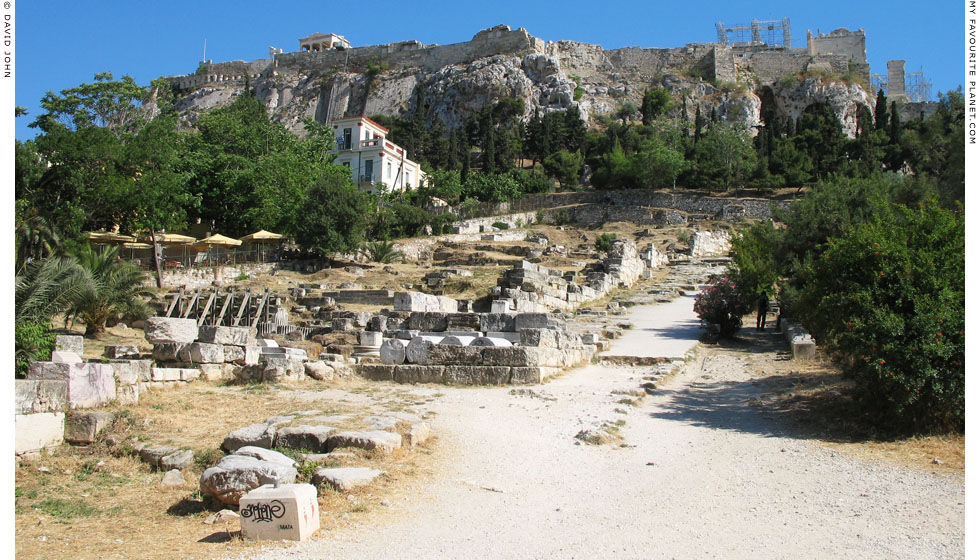
The site of the sanctuary of Demeter and Persephone in Athens,
known as the City Eleusinion (Ελευσίνιον), on the east (left) side
of the Sacred Way, between the Agora and the Acropolis. |
| |
The main sanctuary of Demeter and Persephone in Athens was known as the City Eleusinion (Ελευσίνιον), in which the sacred cult objects (ἄρρητα ἱερά, arreta hiera) were kept during the first four days of the celebration of the Greater Mysteries, before the participants made their way to Eleusis. Located to the southeast of the Athenian Agora, along the Sacred Way up to the Acropolis, the sanctuary contained a temple of Demeter and Persephone and a temple of Triptolemos. [11]
There was also a temple of Demeter near the gates to the city at Kerameikos, northwest of the Agora, which contained statues of Demeter, Persephone and Iakchos by Praxiteles [note 11]. Another sanctuary for the Eleusinian Mysteries stood near the River Ilissos, to the south of the Acropolis (see below).
An inscribed horos (boundary stone) of the 4th century BC, found in the the Athenian Agora, marked the sanctuary of Demeter Azesia (----- ΙΕΡΟΥ ΔΗΜΗΤΡΟΣ ΑΞΗΣΙΑ), who is also known from a fragment of Sophokles. The location of the sanctuary is unknown. [12]
See a statuette of Demeter sitting on the sacred kiste found in the Agora in part 2. |
|
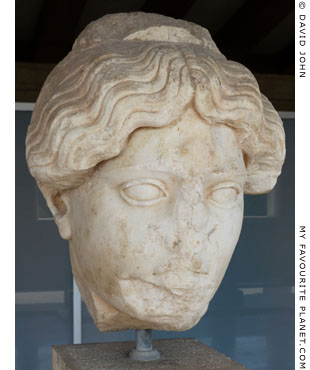
Marble head of a goddess,
probably Persephone.
From the Athens Agora. 2nd century AD,
copy of an early Classical work.
Agora Museum, Athens. Inv. No. S 547. |
|
| |
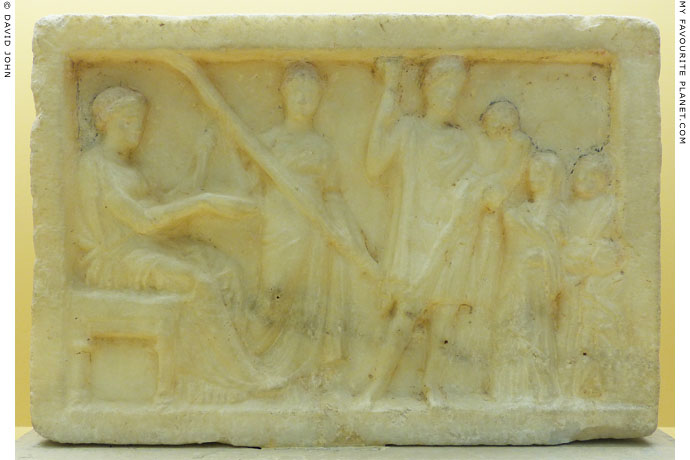
Marble votive relief of Demeter, Kore, Iakchos and worshippers, from the City Eleusinion, Athens.
Late 4th century BC. Found 11 June 1947 at the west foot of the Areopagus.
Pentelic marble. Height 21.8 cm, width 31.2 cm.
Agora Museum, Athens. Inv. No. S 1251.
|
| Demeter, enthroned left, holds out a phiale (φιάλη, libation bowl; Latin, patera) in her right hand, and a staff in her left. Right of her stand Persephone, holding a long torch diagonally, and Iakchos (Ἴακχος: Latin, Iacchus), carrying the infant Ploutos (Wealth) who holds a cornucopia. On the right are three smaller worshippers, a woman, a man and a child, probably the dedicators of the relief. The detailing of the low relief is much finer than can be seen under the flat lighting in the museum. |
|
|
| |
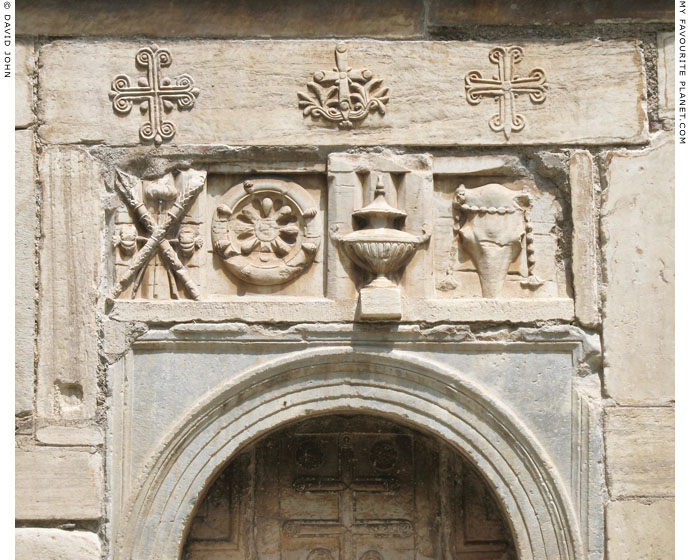
Part of an ancient frieze above the south door of the Byzantine "Little Metropolis"
church in central Athens, thought to be from the City Eleusinion.
|
The small Byzantine church of Panagia Gorgoepikoos (Παναγία Γοργοϋπήκοος, the swift-hearing Virgin), also known as the Little Metropolis (Μικρή Μητρόπολη, Mikri Mitropoli), and for a short while renamed as the church of Agios Eleutherios (Άγιος Ελευθέριος), acted as the Metropolitan Cathedral of Athens during the Turkish occupation, until the much larger modern cathedral was built next to it 1842-1862.
It is not known when the church was built, perhaps as early as the 9th century or as late as the 15th century. It was constructed using marble spolia, material from various older pagan and Christian buildings, and also contained ancient inscriptions and a Roman period sundial, which is now in the British Museum (see Athens Acropolis gallery page 36). Attempts have been made to identify the parts of ancient reliefs built into the walls of the church.
This Doric frieze, above the south door, is part an entablature, with triglyphs and metopes decorated with the following motifs in relief (left to right): two crossed myrtle torches and three poppies; a phiale (libation bowl); a plemochoe (see below); a boukranion (ox skull) with a fillet. All these symbols are also found on building decorations at the Sanctuary of Demeter and Persephone at Eleusis. It is thought that the frieze is from the City Eleusinion, south of the Athenian Agora, probably from the Hellenistic propylon (monumental gateway), built in the 2nd century BC on the west side of the sanctuary, facing the Sacred Way to the Acropolis (see photo on Athens Acropolis gallery page 1).
See:
Monica Haysom, Time and religion in Hellenistic Athens: An interpretation of the Little Metropolis frieze. PhD thesis, School of History, Classics and Archaeology, Newcastle University, 2015.
Bente Kiilerich, Making sense of the spolia in the Little Metropolis in Athens. In: Estratto dalla rivista Arte Medievale, nuova serie anno IV (2005), 2, pages 95-114.
The marble lintel above the frieze is decorated with reliefs of three elaborate crucifixes, each in a different style.
The plemochoe (πλημοχόη), a vessel also known as a little kotulos, shaped like a spinning top, was particularly associated with the Eleusinian Mysteries. According to the Greek rhetorician Athenaeus of Naucratis (Ἀθήναιος Nαυκρατίτης, 2nd - 3rd century AD), two plemochoai were used in the rituals of the Greater Mysteries at Eleusis and gave their name to the last day of the celebrations there.
"There is the plemochoe, too. This is an earthenware vessel, shaped like a top, not very steady; and some people call it the cotyliscus, as Pamphilus tells us. But they use it at Eleusis on the last day of the Mysteries, which day they call Plemochoai, from the cups. And on this day they fill two plemochoae, and place one looking towards the east, and the other looking towards the west, saying over them a mystic form of words; and the author of the Pirithous names them (whoever he was, whether Critias the tyrant, or Euripides), saying:
That with well-omen'd words we now may pour
These plemochoae into the gulf below."
Athenaeus, The Deipnosophists, Book 11, chapter 93. At Perseus Digital Library. |
|
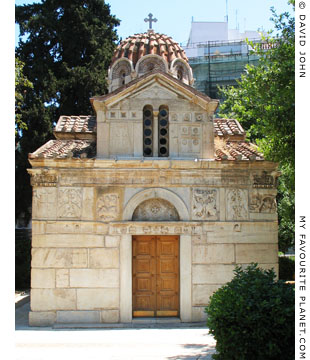
The "Little Metropolis" church,
Mitropoleos Street, Athens. |
|
|
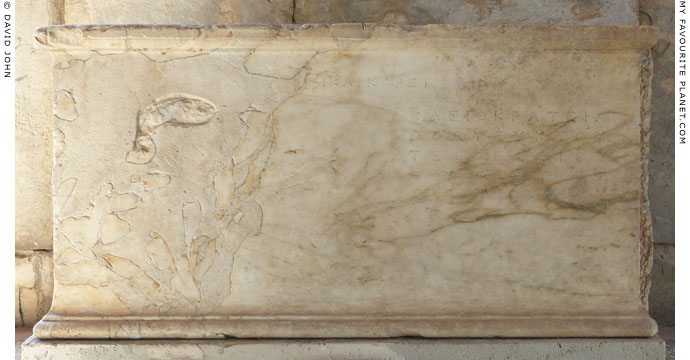
Inscribed facade of a statue base dedicated to Demeter and Kore and signed by Praxiteles.
Pentelic marble. Around 360-350 BC. Found in May 1936 in the Athenian Agora, north
of the Hephasteion. Height 67.2 cm, width 135 cm, width of left side 67.5 cm.
In the lower colonnade of the Stoa of Attalus,
Agora Museum, Athens. Inv. No. I 4165.
|
Two statues stood on the base: the first, by Praxiteles, depicted Kleiokrateia, daughter of Polyeuktos of Teithras (a deme of east Attica); the second portrayed her husband Spoudias of Aphidnai. The signature of the sculptor of the second statue, "(..)usicles" is incomplete. The Praxiteles signature is written in letters much smaller than the rest of the inscription, and not so deeply cut, so that it is difficult see except when lit from the side (mid-late afternoon).
[Δή]μη[τ]ρι καὶ Κόρει
[Σπο]υ[δίας]
— — — —
[Ἀφι]δ[ναῖος].
vacat
—υ̣σ[ι]κλ̣[ῆς ἐποίησεν].
vacat
Κλειοκράτεια
Πολυεύκτου
Τειθρασίου
θυγάτηρ
Σπουδίου γυνή.
Πραξιτέλης ἐποίησεν.
Inscription SEG 17:83.
It is thought that the statues were originally set up in the City Eleusinion. The base probably had a poros limestone core faced with marble slabs, parts of which were found reused in a 1st century BC wall, between the Hephaisteion and the Stoa of Zeus Eleutherius, and on a wall of a modern canal.
In the late 360s Demosthenes wrote an oration (Oration No. 41) against Spoudias, who was in dispute with Kleiokrateia's family over the repayment of a loan. It has been suggested that the couple were at this time in financial difficulties, and thus may have commissioned the statues at an earlier date when they had been better off. [13] |
|
| |
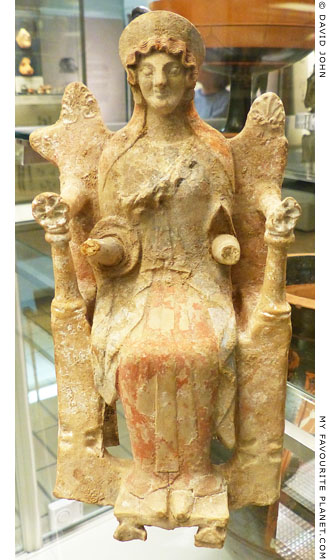
Terracotta figurine of an enthroned
goddess, possibly Demeter or Hera.
Made in Athens, around 500 BC.
British Museum.
Inv. No. GR 1966.3-28.19. |
|
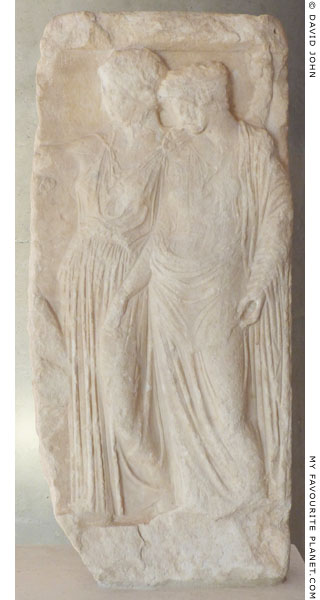
Part of a marble relief of Demeter
and Persephone from the Athenian
Acropolis. Late 5th century BC.
Acropolis Museum, Athens.
Inv. No. Acr. 1348. |
|
| |

Marble votive relief dedicated by an association of Attic launderers,
men and women who washed clothes at the Ilissos river, Athens.
Around 350-340 BC. Found in 1759 at the Panathenaic Stadium, Athens.
Pentelic marble. Height 40.5 cm, width 44 cm, depth 9 cm.
Altes Museum, Berlin. Inv. No. Sk 709.
Acquired by Gustav Friedrich Waagen in 1841 from the Museum Nani, Venice. |
| |
The findspot of the Panathenaic Stadium suggests that the relief came from a sanctuary on the nearby Ilissos river, where there was a sanctuary of Pan, Hermes and the Nymphs, a sanctuary for the Eleusinian Mysteries, and the Temple of Artemis Agrotera (Artemis of the Fields).
The front of the marble slab is divided vertically into three areas, with a relief above and below the dedicatory inscription. The relief was dedicated to "the nymphs and all gods" by twelve male and female launderers (10 washermen and 2 washerwomen) whose names are thought to be those of slaves.
οἱ πλυνῆς Νύμφαις εὐξάμενοι ἀνέθεσαν καὶ θεοῖς πᾶσιν
Ζωαγόρας [Ζ]ωκύπρου, Ζώκυπρος Ζωαγόρου, Θάλλος, Λεύκη
Σωκράτης Πολυκράτους, Ἀπολλοφάνης Εὐπορίωνος, Σωσίστρατος,
Μάνης, Μυρρίνη, Σωσίας, Σωσιγένης, Μίδας.
Inscription IG II² 2934.
The scene above the inscription is set in a cave and shows Hermes leading a procession of three Nymphs towards a mask of the river god Acheloos on the far left. On the right Pan sits cross-legged playing his syrinx (pan pipes).
On the right of the lower scene a seated goddess, either Demeter or Artemis, is attended by a standing deity, either Persephone (Kore) or Hekate, holding a long torch. On the left a bearded male figure, depicted at the same scale as the goddesses, stands before an altar with a horse. He is perhaps a local hero or patron of the launderers. It has been suggested that he may be Demophon (Δημοφῶν), son of King Keleos and Queen Metaneira of Eleusis. He wears a short chiton (tunic) and a chlamys (short riding cloak) and holds in his right hand an object which is now broken and unidentifiable. |
|
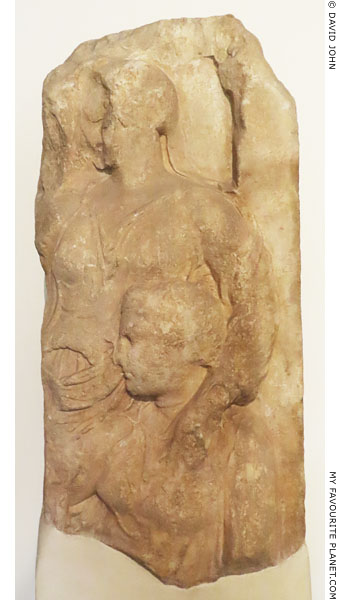
Part of a marble votive relief found in
the area of Byronos-Pangrati, Athens,
to the south of the Ilissos River. Demeter
stands behind seated Persephone. Part
of an inscription with Demeter's name is
preserved on the anta of the relief.
Around 420 BC.
National Archaeological Museum,
Athens. Inv. No. 3572. |
|
| |
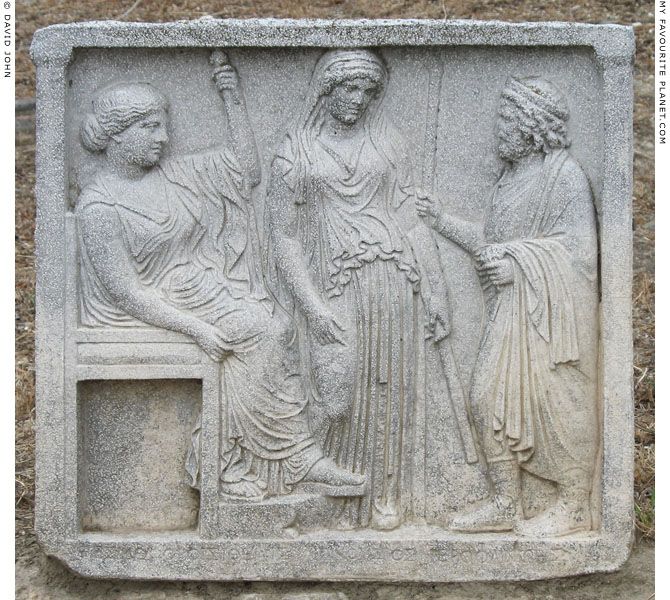
Cast of an Athenian marble votive relief of Demeter, Persephone and a hierophant
(ἱεροφάντης, revealer of sacred things), a high priest of their cult from the Attic
deme of Hagnous, southeast of Athens. According to the inscription on the lower
edge of the frame, the hierophant, referred to only as "Hagnousios", dedicated
the relief to the goddesses of the Thesmophoria festival.
Classicizing work of the Roman Imperial period, 2nd century AD.
Found in 1959 during excavations by John Travlos north of the
Olympieion, Athens. Height 63 cm, width 67.5 cm.
In situ at the findspot, in the archaeological site of the Olympieion and Ilissos Shrines, Athens.
The original is in storage in the Agora Museum, Athens.
Third Ephorate of Antiquities, Athens Collection. Inv. No. L 13114. |
| |
| |
Sanctuaries of Demeter and Persephone
Corinth and Isthmia |
 |
|
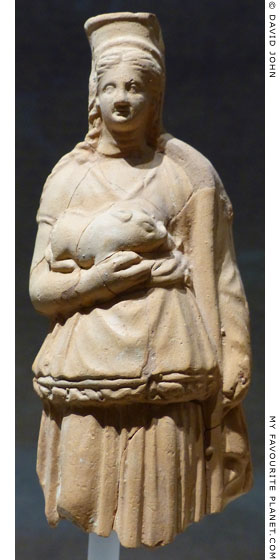 |
|
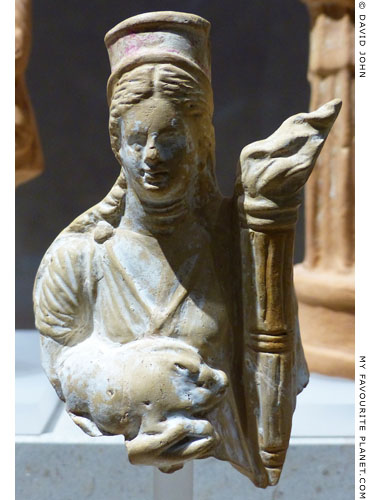 |
| |
Terracotta figurines of females, each wearing a polos and holding a piglet in her
right hand. The figure on the right also holds a conical torch in her left hand.
From the Sanctuary of Demeter and Kore at Ancient Corinth. Around 320-200 BC.
Corinth Archaeological Museum.
Left: Inv. No. MF-70-26 (cat. H401 *). Height 15.8 cm.
Right: Inv. No. MF-10325 (cat. H395 *). Height 10.9 cm.
|
|
The remains of the large Sanctuary of Demeter and Kore at Corinth (Κόρινθος) are on the north side of the steep road up from the ancient city to Acrocorinth. It was once one of the most important sanctuaries, perhaps the most important, in Corinth, and one of the largest in the Greek world. Until the late Classical period the sanctuary consisted only of a small Archaic temple (oikos, from οἶκος, a house, a dwelling), an elevated terrace with a sacrificial altar and around forty rooms for ritual dining.
In the 4th century BC a new temple was built as well as a Doric propylon (monumental gateway) and a small theatre, carved out of the rock of the slope, which seated around a hundred people. The Archaic temple was replaced by a stoa. The sanctuary was not used after the destruction of Corinth by the Roman consul Lucius Mummius Achaicus in 146 BC, but was revived in the late 1st century BC. In the 1st century AD it was redesigned and three small Ionic temples were built. One of the ritual dining areas near the propylon was converted into a Roman cult building where katadesmoi (curses, from κατάδεσμος, katadesmos, curse) were dedicated.
The sanctuary was briefly mentioned in the 2nd century AD by the Greek travel writer Pausanias, who merely noted:
"The temple of the Fates and that of Demeter and the Maid have images that are not exposed to view."
Description of Greece , Book 2, chapter 4, section 7.
It was abandoned towards the end of the 4th century AD, and from the 6th century part of the area was used as a cemetery.
As at other sanctuaries of Demeter and Persephone, thousands of votive offerings have been unearthed here, including ceramic statues, figurines, vessels and inscribed plaques, as well as terracotta models of likna (λίκνα, winnowing trays) containing cakes and breadstuffs (see photo below). The small (but fine) Corinth Archaeological Museum has space only for a few of these finds, and as at other museums, researchers have been unable to discover whether the ceramic female figures depict Demeter, Persephone, some other deity, priestesses or worshippers.
Today the area of the sanctuary is overgrown, there is not much to see there and it is not even signposted, nor is it mentioned in the glossy guidebooks to Ancient Corinth.
* Catalogue numbers of the figurines from:
Gloria S. Merker, Corinth, Volume 18, No. 4, The Sanctuary of Demeter and Kore: Terracotta figurines of the Classical, Hellenistic, and Roman periods. The American School of Classical Studies at Athens (ASCSA), 2000. At jstor.org.
A terracotta mask of Dionysus and two inscribed ceramic plaques dedicated to Dionysus were also found in the sanctuary.
See other artefacts from Corinth related to Demeter
and Persephone in Part 2: here, here and here. |
|

Terracotta female figure with
a piglet from the Sanctuary of
Demeter and Kore, Corinth.
Corinth Archaeological Museum.
Inv. No. MF-11785 (cat. H10 *).
See photos of other
piglet-offering figures
associated with Demeter
and Persephone in part 2. |
|
| |
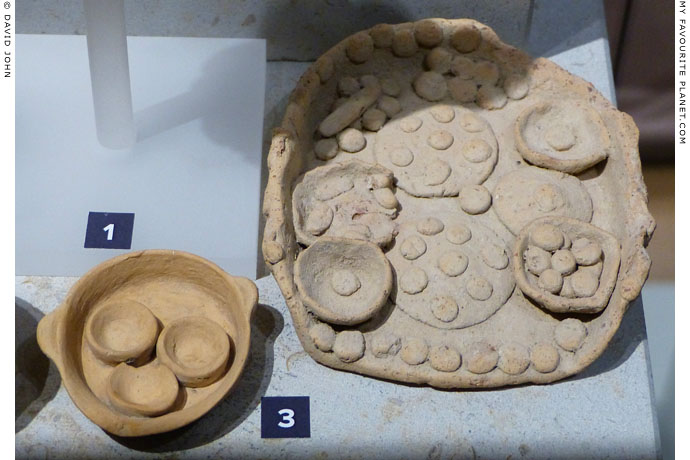
Terracotta votive offerings from the Sanctuary of Demeter and Kore at Corinth.
Two model likna (λίκνα), winnowing baskets or trays used to separate the grain
from the husks after harvesting, filled with cakes and breadstuffs. Hundreds of
such votive likna were excavated at the sanctuary, where they had been
dedicated from at least the early 6th century until the 2nd century BC.
Archaic period, 6th century BC.
Corinth Archaeological Museum.
See: Allaire Brumfield, Cakes in the Liknon: Votives from the Sanctuary of Demeter and
Kore on Acrocorinth. Hesperia, Volume 66, No. 1 (January - March 1997), pages 147-172.
The American School of Classical Studies at Athens (ASCSA). At jstor.org.
See also terracotta figurines of a goddess holding a liknon in part 2. |
| |
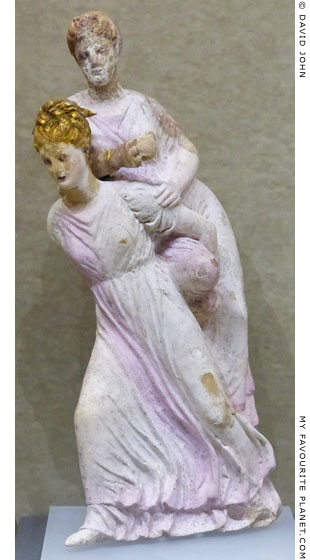
A ceramic figurine of two girls playing
ephedrismos, a piggyback game. [14]
From Ancient Corinth.
Corinth Archaeological Museum.
Inv. No. MK 8250. |
|
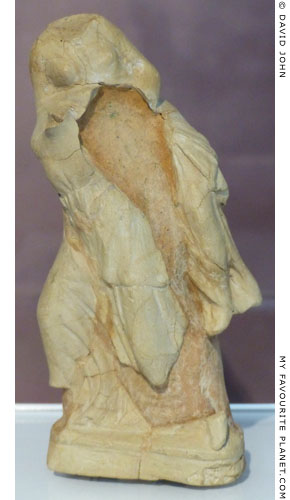
A fragmentary terracotta ephedrismos
figurine from the Rachi, Isthmia.
350-300 BC. Found among a large quantity
of ceramics in a well in the Early Hellenistic
settlement on the Rachi ridge, Isthmia,
during excavations in 1955-1956. [15]
Height 11.5 cm.
Isthmia Archaeological Museum.
Inv. No. IM 955. |
|
| |
The ephedrismos (ἐφεδρισμός) figurine in the Corinth Archaeological Museum is displayed in a group of various artefacts themed "Beloved toys, favorite games" with no specific information about the individual objects or where they were found. It appears that it was either found at or associated with the Sanctuary of Demeter and Kore at Corinth.
The fragments of a similar figurine were found in the area of the Sanctuary of Demeter and Kore at Rachi in nearby Isthmia (see below), where the Isthmia Archaeological Museum's labelling points out that such finds were "associated with the worship of female divinities" and "similar to offerings that have been found at the Sanctuary of Demeter and Kore on Acrocorinth". |
|
| |
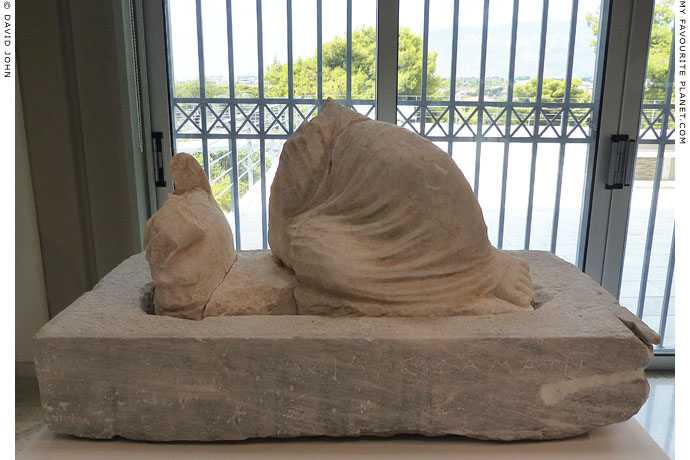
Fragments of a marble statue of a seated child (Kleo) with
a goose on a plinth inscribed with a dedication to Demeter.
ΚΛΕΩ:ΘΑΣΙΔΟΣ:ΔΑΜΑΤΡΙ
"Kleo, daughter of Thasis, to Demeter"
A chance find in 1956 from the area of the Sanctuary of
Demeter and Kore at the Sacred Glen, Isthmia. 350-325 BC.
Isthmia Archaeological Museum. Inv. No. IS 254. Inscription ΙΣ 316.
|
At Isthmia (Ισθμία), 16 kilometres east of Ancient Corinth there was another sanctuary of Demeter and Kore which is thought to have been in use from the 6th to the 4th century BC. Temples of Demeter and Kore, Dionysus and Artemis were located in the Sacred Glen (Ιερά Νάπη, Iera Nape), near the ridge known as the Rachi (Ράχη, at the modern village of Kyras Vrysi), 300 metres southwest of the Temple of Poseidon, the patron deity of Isthmia (see Niobe).
An inscribed limestone stele of the 2nd century AD lists the benefactions of P. Licinius Priscus Iuventianus, archiereus (ἀρχιερεύς, high priest for life) of the imperial cult in the Achaean League, who built and refurbished several temples and sanctuaries at Isthmia. According to the inscription, he built a peribolos (περίβολος, enclosed court, in this case a temenos or sanctuary area) with a temple of Demeter and temples of Dionysus and Artemis in the Sacred Glen (also referred to as Sacred Grove). He also provided the statues and ornaments for the temples and restored the Plutoneion (or Ploutonion). The exact dating of the stele is uncertain, but arguments have been made both for before and after the reign of Hadrian (117-138 AD). In 1676 the travellers Jacob Spon and George Wheler were at Isthmia and recorded the inscription which is now in the Museo Lapidario Maffeiano in Verona (inscription IG IV 203). [16]
The Sacred Glen was identified by the Swedish American archaeologist Oscar Broneer (1894-1992), who directed excavations at Isthmia 1959-1967 for the University of Chicago, and who discovered the Temple of Poseidon there in 1952. No remains of temple structures have yet been discovered in the glen, which may be at least partly due to the fact that the area around the Rachi had been used a quarry, and the stones of ancient buildings and monuments were reused elsewhere. However, large quantities of votive ceramics and metal objects found in the area indicate religious practice there.
The remains at the Sacred Glen site are scant, and the archaeological finds from the area of the sanctuaries, although typical of votive offerings to these deities, are not particularly exciting or enlightening, particularly compared with the treasures in the Corinth museum. However, the location, overlooking the southern end of the Corinth Canal, is evocative and the area and museum are well worth visiting. From here it is a 10 minute walk to the canal, where there are good tavernas with terraces on either side, each with a good view of the wonderful submersible road bridge and the passing ships and boats. Immediately to the south of the bridge the canal meets the Saronic Gulf with some small islands visible in the distance. To the north a pleasant footpath leads along the west side of the canal towards the motorway (over which is a footbridge), the older road bridge and the Isthmia bus station. |
|
| |
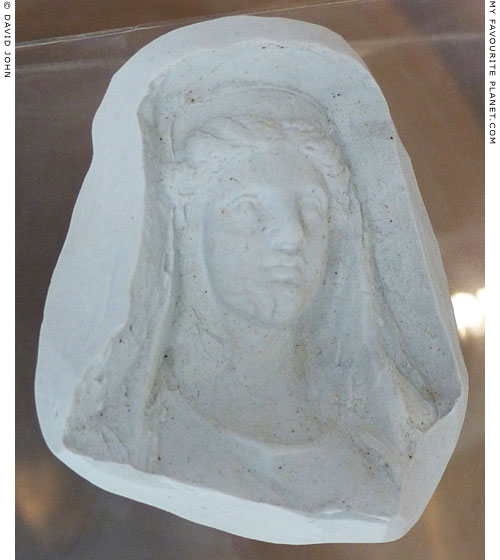
The bust of a veiled female wearing a polos, perhaps Demeter. A modern
plaster cast made from a Hellenistic mould for producing terracotta figurines.
From the area of the Sanctuary of Demeter and Kore at Isthmia. 375-270 BC.
Isthmia Archaeological Museum. Mould, Inv. No. IM 1026. |
| |
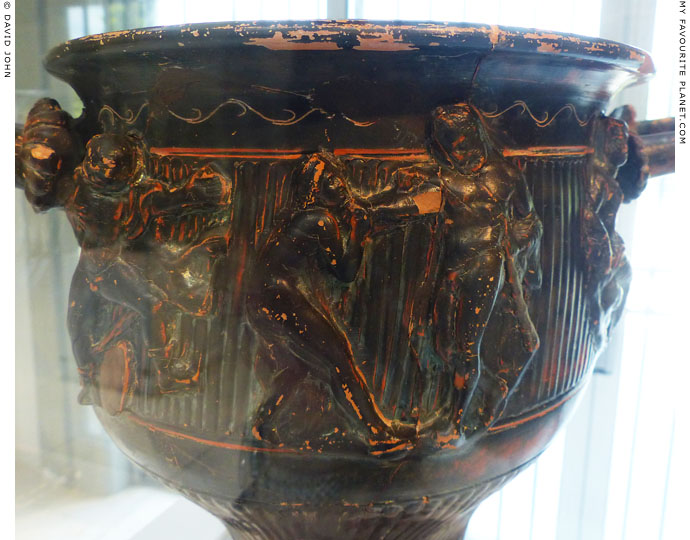
Detail of a skyphoid krater (for mixing wine and water) with reliefs depicting a Dionysiac
scene and drunken Herakles. Inside the rim is a scratched dedicatory inscription in Doric
dialect, from Sofa to Demeter: ΣΟΦΑ ΔΑΜΑΤΡΙ (see photo below).
350-325 BC. Found in an ancient well at the Sanctuary of Demeter and Kore,
in the "Sacred Glen", Rachi, Isthmia. Late 4th - early 3rd century BC.
Isthmia Archaeological Museum. Inv. No. IP 384. |
| |
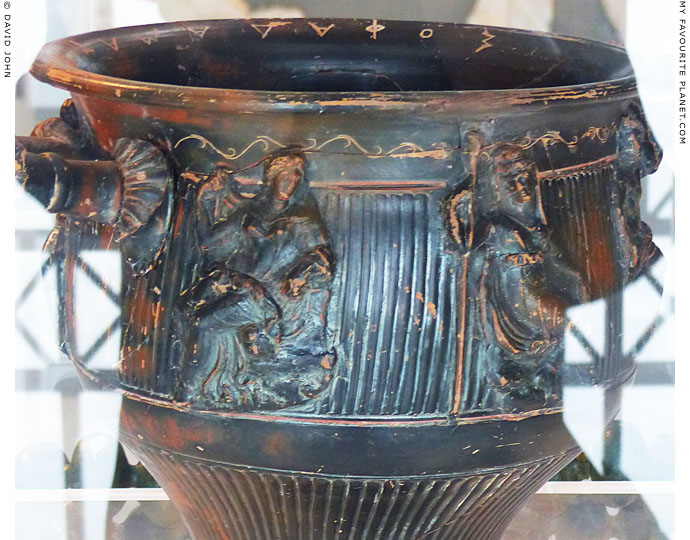
The other side of the skyphoid krater from Isthmia, with two seated females (Demeter and
Persephone?) depicted in relief. The dedication to Demeter by Sofa can be seen (upside down)
inside the rim. Unfortunately, the krater is exhibited in a glass case next to a window, so that
strong multiple reflections make it difficult to see the details of the dark vessel. |
| |
| |
Sanctuaries of Demeter and Persephone
Olympia, Elis, west Peloponnese |
 |
|
| |
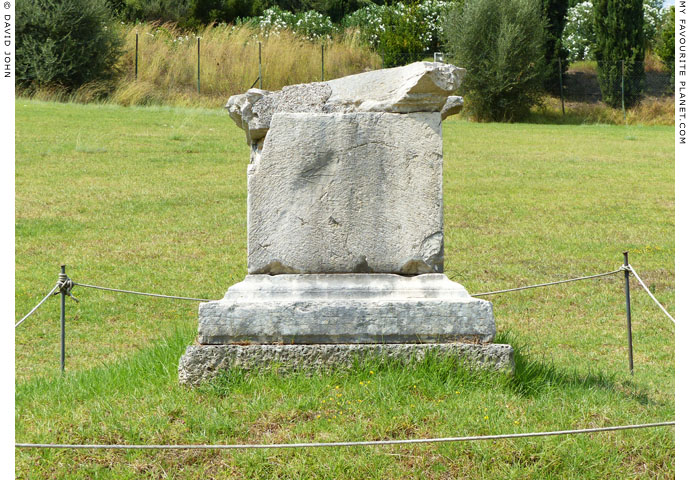
The altar of Demeter Chamyne on the low hill north of the stadium of Olympia. 2nd century AD.
|
According to Pausanias, the epiphet of Demeter in the ancient Peloponnesian district of Elis (Ἦλις) was Chamyne (Χαμύνη), and there was a sanctuary of the goddess on the low hill north of the Olympic stadium (race track). At the time of his visit to Olympia, around 155 AD, new Pentelic marble statues of Demeter and Persephone (the Maid) in the sanctuary had been donated by the wealthy Athenian Herodes Atticus.
In 2006 the remains of what are thought to be the sanctuary of Demeter Chamyne were discovered by chance during the digging of a water supply project, around 150 metres northeast of the stadium. They include a large building, dubbed Building A, built of local limestone, oriented east-west and divided into four rooms. Dated to the early 5th century BC, it is thought to have served a cult function, and in one of the rooms was a stone feature, perhaps an altar, surrounded by votive objects.
Objects discovered during the ensuing archaeological excavations of 2007 and 2008 include 34 bronze coins of the 5th - 4th century BC, several terracotta figures, most depicting human female subjects, but also animals, particularly bovines and goats, as well as silens and masks. A number of unusual terracotta figures of Cerberus (Κέρβερος, Kerberos) of various sizes found at the site, dated to the 6th - 5th centuries BC, depict the hound of Hades with two heads on very long necks. One of the larger examples is inscribed with a dedication to Kore, Demeter (see photo right), while a smaller one depicts Kerberos with sacrificial cakes in each of its mouths (see photo below right). Part of a Roman period baths was also discovered on the site. A small selection of the finds is currently exhibited in the nearby Pyrgos Archaeological Museum. [17]
The office of cult priestess of Demeter Chamyne, appointed or "bestowed" (awarded) by the Elians "from time to time", which indicates that it was an honorary and temporary position for the duration of an Olympiad. She was the only woman allowed to attend the Olympic Games, and watched the competitions while seated on the altar of Demeter Chamyne, halfway along the length of the race course, directly opposite the stand of the competition judges (hellanodikai). "Maidens" (παρθένοι, parthenoi, virgins), girls or unmarried young women, were admitted to Olympia, and there were also games for girls, a series of foot-races known as the Heraia (Ἡραῖα, in honour of Hera; Pausanias, Description of Greece, Book 5, chapter 16, sections 2-8).
Built of white stone blocks reused from an equestrian monument, the altar has been dated to the 2nd century AD. It has been suggested that it may have been set up for or even by financed by Aspasia Annia Regilla, the wife of Herodes Atticus, who was the priestess of Demeter Chamyne at Olympia, probably during the 233rd Olympiad in 153 AD. The couple are thought to have financed the building of the Nymphaeum of Herodes Atticus in the Sanctuary of Zeus at Olympia and the connecting aqueduct around this time.
"Now the stadium is an embankment of earth, and on it is a seat for the presidents of the games. Opposite the umpires is an altar of white marble. Seated on this altar a woman looks on at the Olympic games, the priestess of Demeter Chamyne, which office the Eleans bestow from time to time on different women. Maidens are not debarred from looking on at the games."
Pausanias, Description of Greece, Book 6, chapter 20, sections 8-9.
"The other side of the course is not a bank of earth but a low hill. At the foot of the hill has been built a sanctuary to Demeter surnamed Chamyne. Some are of the opinion that the name is old, signifying that here the earth gaped for the chariot of Hades and then closed up once more. Others say that Chamynus was a man of Pisa who opposed Pantaleon, the son of Omphalion and despot at Pisa, when he plotted to revolt from Elis; Pantaleon, they say, put him to death, and from his property was built the sanctuary to Demeter.
In place of the old images of the Maid and of Demeter new ones of Pentelic marble were dedicated by Herodes the Athenian."
Pausanias, Description of Greece, Book 6, chapter 21, sections 1-2.
Pausanias also reported on statues of Demeter, Persephone and Plouton in the Heraion (Sanctuary of Hera) at Olympia: chryselephantine (gold and ivory) statues of Demeter and Persephone sitting opposite each other (Book 5, chapter 17, section 3); and figures or a relief of Plouton, Dionysus, Persephone and Nymphs, one of them carrying a ball. "As to the key (Pluto holds a key), they say that what is called Hades has been locked up by Pluto, and that nobody will return back again therefrom." (Book 5, chapter 20, section 3) Another statue of Persephone, one of many dedications at Olympia of Mikythos, the 5th century BC tyrant of Rhegion (see the note in Homer part 1), stood at the side of the Temple of Zeus (Book 5, chapter 26, section 2). |
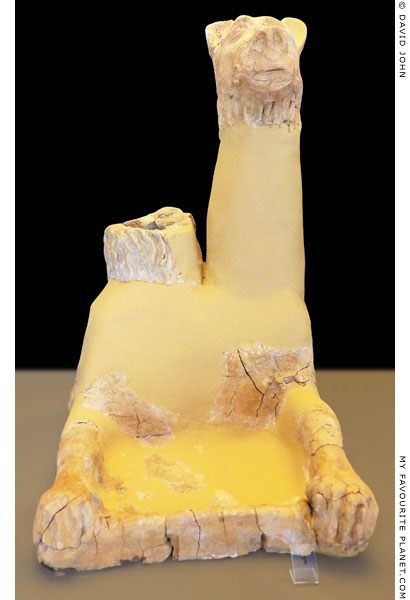
Restored fragments of a votive ceramic figurine of
two-headed Cerberus, the hound of Hades, from
the Sanctuary of Demeter Chamyne at Olympia.
On the chest are parts of an incised inscription
which is thought to have stated:
Κόρ[αι], [Δά]ματρι, [Βα]σιλεῖ
(Dedicated to) Kore (Persephone), Demeter
and Basileos (King; Plouton, king of Hades).
Late 6th century BC.
Pyrgos Archaeological Museum. |
| |
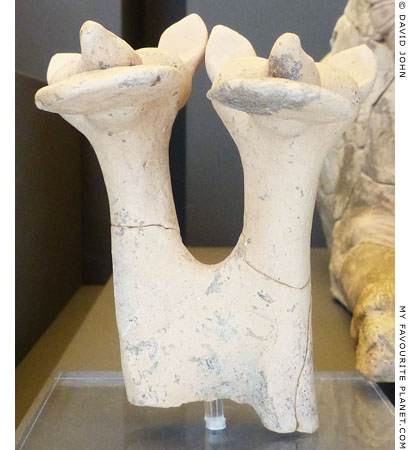
Part of a votive ceramic figurine of two-headed
Cerberus with sacrificial cakes in each of its mouths.
5th century BC. From the Sanctuary
of Demeter Chamyne at Olympia.
Pyrgos Archaeological Museum. |
| |
| |
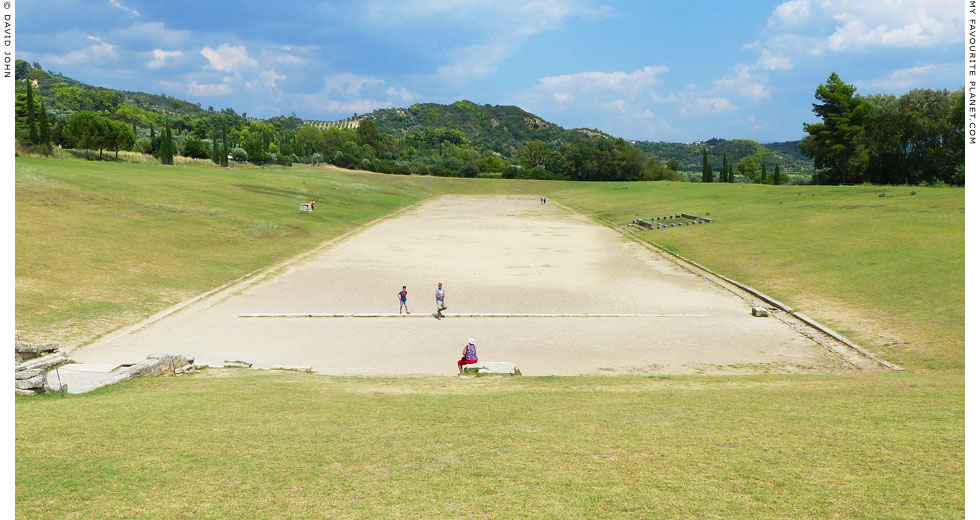
The altar of Demeter Chamyne on the northern embankment (left) of the stadium
of Olympia, around halfway along the racetrack and directly opposite the stand on
which the hellanodikai (Ἑλλανοδίκαι, competition judges) sat. Nearer the foreground
two visitors walk over the row of stones that mark the starting line of the racetrack. |
| |
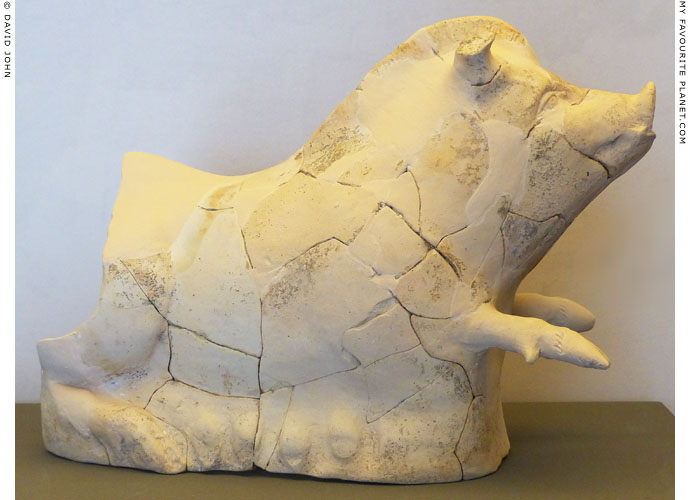
A large ceramic votive figurine of a sow from
the Sanctuary of Demeter Chamyne at Olympia.
4th century BC.
Pyrgos Archaeological Museum. |
| |
| |
Sanctuaries of Demeter and Persephone
Macedonia and Thrace |
 |
|
| |
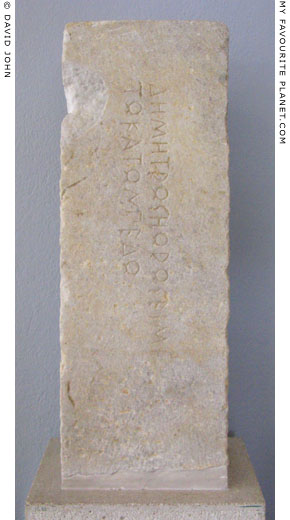 |
|
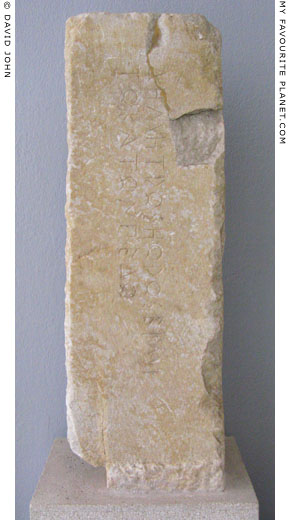 |
Two inscribed marble steles set up as horoi (boundary markers) of the sanctuary
and temple of Demeter Hekatompedos (100 feet long) in ancient Galepsos
(Γαληψός), Thrace (today Macedonia, Greece), a colony of the Thasian-Parians.
The inscriptions are written in the Parian alphabet. Around 510-490 century BC.
Δήμητρως ℎώρως εἰμὶ
τὠ κατωνπέδω
Inscription SEG 43 400.
Kavala Archaeological Museum. Invoice numbers Λ1202 and Λ1203.
|
|
Around 680 BC Greeks from Paros founded a colony on the island of Thasos, formerly a Phoenician colony. From Thasos the Parians founded or took control of several settlements on the Thracian mainland, and the new colonies became collectively known as the Thasian Peraia (ἢπειρος).
The cities included Neapolis (Kavala), Galepsos, Oisyme, Apollonia, Stryme and Krenides (later renamed Philippi), as well as smaller trading posts (ἐμπόριον, emporion; plural ἐμπορία, emporia) such as Antisara, Akontisma and Pistyros.
Pausanias reported the legend that the cult of Demeter as practiced by the Thasians was brought from Paros by a woman named Kleoboia (Κλεόβοια). She was shown as a maiden holding the cista mystica (see above) in a painting by Polygnotos of Thasos (5th century BC) that was exhibited in the Knidian Lesche, a building dedicated by the people of Knidos, at Delphi. Pausanias described the painting as depicting the mythical Underworld ferryman Charon steering his deceased passengers down the river Archeron to Hades.
"Those on board the boat are not altogether distinguished. Tellis appears as a youth in years, and Cleoboea as still a maiden, holding on her knees a chest such as they are wont to make for Demeter. All I heard about Tellis was that Archilochus the poet was his grandson, while as for Cleoboea, they say that she was the first to bring the orgies of Demeter to Thasos from Paros." [18]
Pausanias, Description of Greece, Book 10, chapter 28, section 3.
This description has been used to support the hypothesis that the Parian lyric poet Archilochos (Ἀρχίλοχος, circa 680-645 BC), who was involved in the colonization in Thrace and whose father Telesicles led the Parians to Thasos, may have belonged to a family of priests of Demeter. He was one of the first poets to use the term iamboi (as in iambic poetry), which is associated with the worship of Demeter. |
|
| |
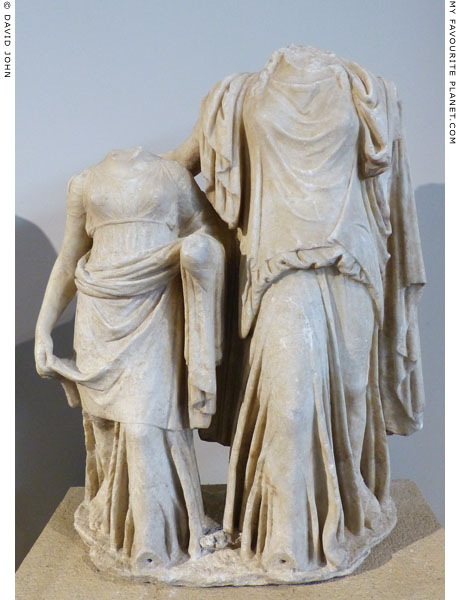
A marble statue group of Persephone (left) and Demeter.
From the sanctuary of Demeter at Derveni, the area of the ancient
Mygdonian city of Lete (Λητή), near Thessaloniki, Central Macedonia,
Greece. Late 4th - early 3rd century BC. Height 60 cm.
Thessaloniki Archaeological Museum. Inv. No. 1070.
|
The two figures face the front and are stepping forward, Demeter, the larger figure on the right, leads with the right foot, and Persephone with the left. Both are now headless and missing their feet which were made separately. Demeter wears a peplos folded in a kolpo at the waist, and a himation (cloak) draped over her shoulders. Her left arm is missing, her right hand rests on Persephone's right shoulder. The daughter wears a himation over a long chiton (tunic). Part of the himation is draped around her left arm, and lifts anothe part of it with her right hand.
Demeter was worshipped at the shrine in her two aspects, as a mother and a virgin. Artemis, the daughter of Leto, after whom the city was named, was worshipped at the same shrine.
See also a statue thought to be from the sanctuary of Demeter at Derveni in Part 2. |
|
| |
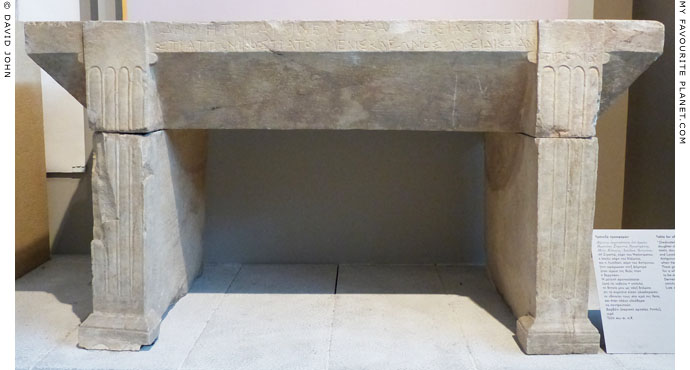
Inscribed offering table dedicated to Demeter by "Stratto, daughter of Nikostratos, Melis,
daughter of Kleon, and Lysidike, daughter of Antigonos, at the time when Berenikas was
her priestess." The young girls, having served the goddess, were now free to marry.
From the sanctuary of Demeter, Derveni, area of ancient Lete, Macedonia. Late 4th century BC.
Thessaloniki Archaeological Museum. Inv. No. 1753. |
| |
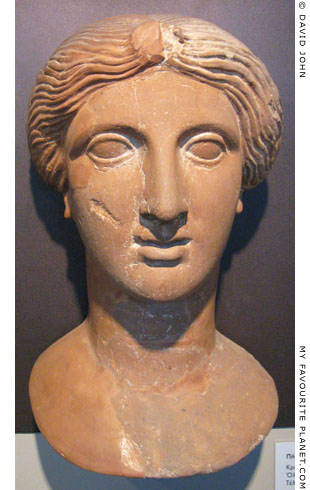
Terracotta bust of a goddess,
probably Demeter, from Olynthos,
Halkidiki, Macedonia, Greece.
End of the 5th century BC. It was
hung on a wall in a private house.
Thessaloniki Archaeological Museum. |
|
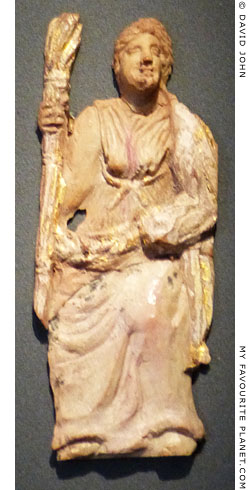
A gilt bone plaque with a relief of
Demeter, Persephone or Hekate
seated, with a torch in her right hand.
Part of the decoration of a wooden
couch. From Tomb C, a cist grave at
Sedes, Macedonia, Greece. 320-300 BC.
Thessaloniki Archaeological Museum.
Inv. No. MΘ 19678. |
|
| |
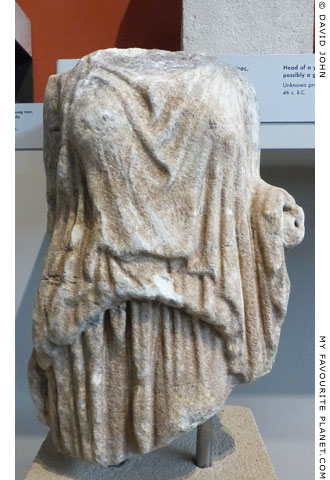
Fragment of a marble statuette of a female
figure wearing a peplos, possibly Demeter.
Early 4th century BC. From Agia Kyriaki,
Sochos (Σοχός), Macedonia, Greece.
The ancient settlement of Sochos was near the
modern town of Lagada, east of Thessaloniki
and north of Lake Volvi (the ancient Thracian
area of Bisaltia). Not much is known about its
history. It may have had a sanctuary of Hermes
and have been a centre of pottery production.
Thessaloniki Archaeological Museum. |
|
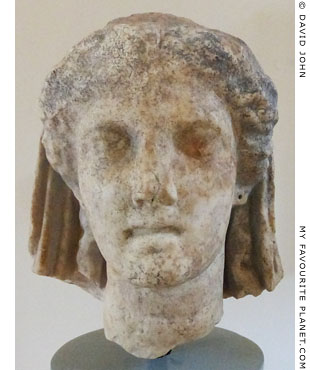
Marble head of Demeter, discovered
in 1973 in the sanctuary of Demeter,
Dion, Macedonia. 4th century BC.
Dion Archaeological Museum.
Inv. No. 200.
The sanctuary of Demeter in Dion is one
of the oldest places of worship of the
goddess in northern Greece, and temples
for her were built here from at least the
Archaic period. The sanctuary included
smaller buildings and altars for the worship
of other deities associated with fertility and
the underworld. From the 4th century BC
Demeter was worshipped there as
the syncretic deity Isis-Demeter.
For further information about the sanctuaries
of Demeter and Isis at Dion, see:
Dion: the garden of the gods
at The Cheshire Cat Blog.
See also a marble relief of Isis-Demeter
from Dion in Part 2. |
|
| |
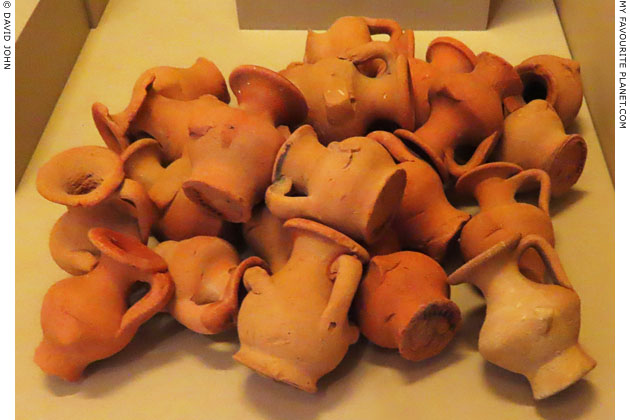
Small terracotta jugs left as votive offerings at the sanctuary of Demeter and Kore,
Abdera, Thrace, northeastern Greece.
Abdera Archaeological Museum. |
|
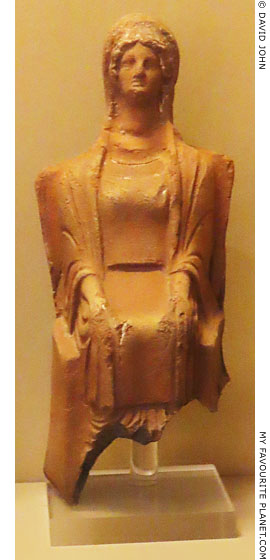
Terracotta statuette of an enthroned
goddess, probably Demeter, from the
sanctuary of Demeter and Kore, Abdera.
4th century BC.
Abdera Archaeological Museum. |
|
| |
| |
Sanctuaries of Demeter and Persephone
Thesmophorion, Pella, Macedonia |
 |
|
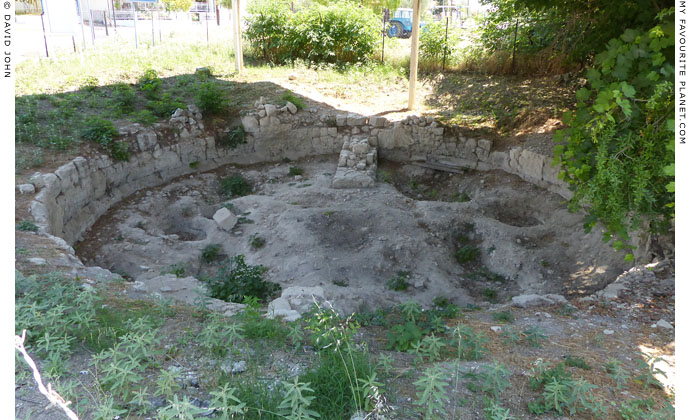
The remains of the Thesmophorion of Pella, Macedonia.
|
The Thesmophorion (Θεσμοφορίων), on the northeast edge of the modern village of Pella, is a circular enclosure with a diameter of 10.2 metres, built with cut rectangular blocks. It was entered by two sloping ramps leading down from either side, one of which can be seen in the centre of the photo above. In the middle stood an altar, constructed of alternate layers of crushed stone and clay, around which were found a large number of vases and ceramic votive figurines, including figures of deities such as Plouton, Artemis, Dionysus and Pan. Circular and rectangular pits in the ground acted symbolically as the underground chambers (μέγαρον, megaron, dwelling place; plural, μέγαρα, megara) of Demeter, in which the bones of young pigs and goats were found.
The site was excavated 1980-1981 by the Greek archaeologist Dr. Maria Lilimpaki-Akamati who published the results of her investigations in 1996. [19] Materials and finds include 59 coins, the oldest being bronze coins of Philip II (ruled 359-336 BC), and the majority are bronze coins of Cassander (316-297 BC) and Demetrios II (239-229 BC). This suggests that the rural sanctuary was in use from the second half of the 4th century BC, and reached the peak of its activity during the 3rd century, but was gradually abandoned following the Roman conquest of 168 BC. Due to uncertainty concerning the course of the city wall around this part of ancient Pella, it is not known whether the sanctuary stood in or outside the city's boundaries.
The three day festival of the Thesmophoria (Θεσμοφόρια) was celebrated every autumn, just before sowing time, when the women of the community took part in rituals and sacrifices, mostly dedicated to Demeter, to ensure the annual regeneration of nature, divine protection of their crops and a successful harvest. The sacrificed animals, as well as pine shoots and bread-dough cakes shaped like snakes and phalluses, were buried in the megara to decompose and mix with the fertilizing forces of nature. The remains were later removed from the pits by women known as "bailers" (ἀντλήτριαι, antletriai) and placed on the altar, where they were mixed with other fertility-related offerings and the grain seeds for sowing before being scattered over the fields. [20] |
|
| |
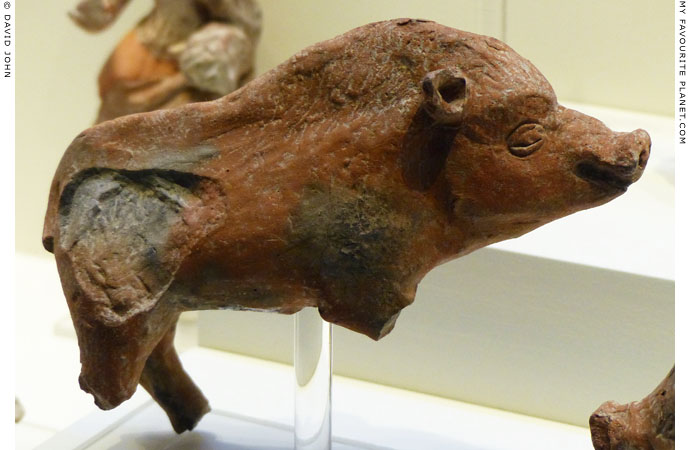
Terracotta votive figurine of a pig from the area
of the Thesmophorion, Pella, Macedonia.
This Macedonian pig looks wilder and hairer than the chubby,
naked, domesticated animal from Eleusis (see above).
Pella Archaeological Museum. |
| |
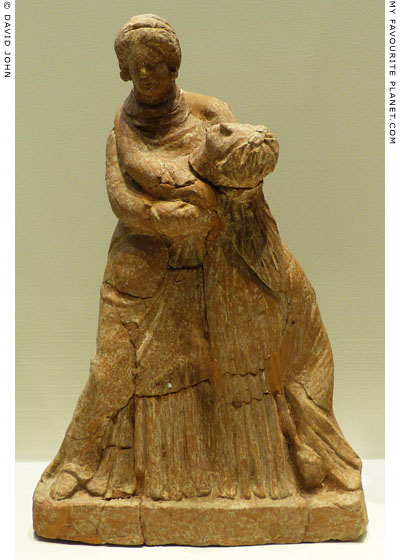
Terracotta votive figurine of Demeter and Persephone
from the Sanctuary of the Mother of the Gods and
Aphrodite in Pella, Macedonia. 4th - 1st century BC.
Pella Archaeological Museum. |
| |
| |
Sanctuaries of Demeter and Persephone
Malophoros, Selinous, Sicily |
 |
|
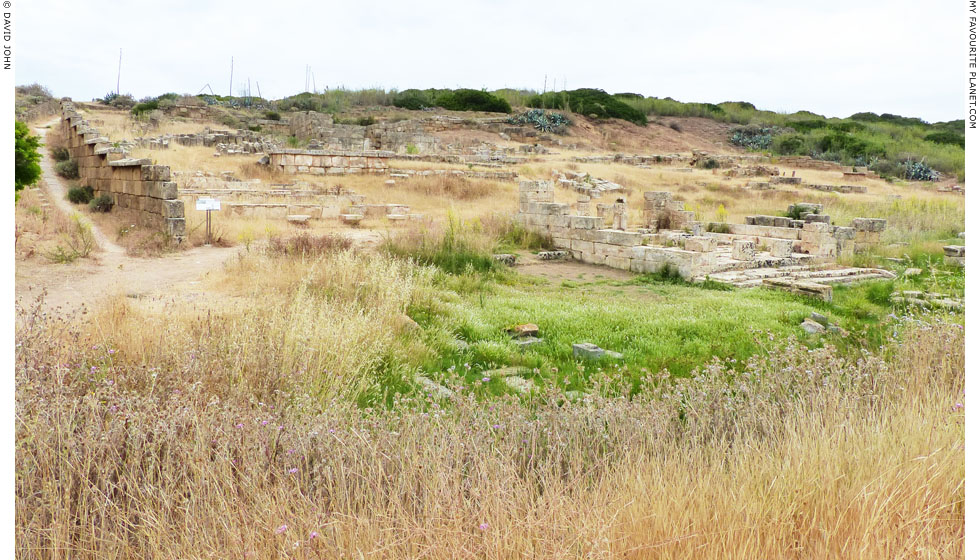
The Sanctuary of Demeter Malophoros, Selinous (Selinunte), Sicily. |
| |
The ancient Greek colony of Selinous (Σελινοῦς; Latin, Selinus; today, Selinunte), on the southwestern coast of Sicily, was founded around 650-628 BC by Greeks from Megara, on the Isthmus of Corinth, who had founded the Sicilian city of Megara Hyblaia (Μέγαρα Ὑβλαία) about a hundred years earlier. The centre of the city and its acropolis were on a plateau over 30 metres above the shore, between the rivers Selinos (today the Modione) to the west and the Calici (Gorgo di Cotone) to the east, at the mouths of which were the city's two harbours (see map below).
It has been suggested that the small Hellenistic temple on the acropolis known as Temple B, previously thought to be a heroon for the philosopher Empedocles, was a temple of Demeter or Asklepios-Eshmun.
On another plateau, known as the East Hill, to the east of the deep valley of the Gorgo di Cotone river, and near the entrance to the archaeological site, are the remains of three large Doric temples (Temples E, F and G), built between 560 BC and 409 BC when the Archaic city was destroyed by the Carthaginian general Hannibal Mago, son of Gisco (not to be confused with the later, more famous Hannibal Barca who crossed the Alps with elephants to invade Rome). Temple E, built around 490-450 BC (opinions differ on exact dates) and probably dedicated to Hera, was restored in 1958 and has become the trademark of the Selinunte Archaeological Park, which claims to be the largest archaeological site in Europe.
The area known as Contrada Gaggera, the hill on the west side of the Selinos (Modione) valley, around 1 kilometre west of the acropolis, marked the western limit of the city. Along the east side of the hill facing the river were a number of smaller temples and sanctuaries, including the Sanctuary of Malophoros (see photo and description below).
Malophoros (Μαλοφόρος) as an epiphet of Demeter is known from a mention by Pausanias of the sanctuary of Demeter Malophoros in Megara, the metropolis (mother city) of Megara Hyblaia. The name has been translated as Sheep-bearer, Apple-bearer or Pomegranate-bearer, due to similarites of the words for sheep and apple in ancient Greek.
"When you have gone down to the port [of Megara], which to the present day is called Nisaea, you see a sanctuary of Demeter Malophorus (Sheep-bearer or Apple-bearer). One of the accounts given of the surname is that those who first reared sheep in the land named Demeter Malophorus." [21]
The translation of malo as apple is based on the idea that the goddess was seen as the bringer not just of cereal agriculture to mankind but also the cultivation of fruits such as the apple. The pomegranate is known to have been associated with the myth of Persephone, and another epiphet for Demeter, known from Greek inscriptions at several locations (Athens, Tegea, Ephesus, Pessinus, Aigeai, Pergamon, Sardis), was Karpophoros (Καρποφορος; also Karpotrophos, Καρποτροφος), Fruit-Bringer.
Many of the architectural members, sculptures and other finds from the temples are now in the Palermo Archaeological Museum (see the metopes below), the site's own small museum and the even smaller (one room) Museo Civico in the nearby town Castelvetrano (12 km northwest of Selinunte). |
|
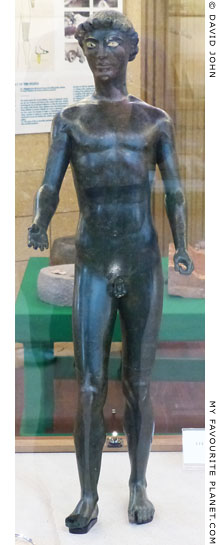
The Ephebe of Selinunte, a
bronze statue of a youth,
found in the area of Ponte
Galera, Selinunte in 1882.
According to a recent theory,
the figure may represent
Dionysus-Iakchos, associated
with the Eleusinian Mysteries.
480-460 BC. Height 84.7 cm.
Museo Civico, Castelvetrano,
Sicily. Inv. No. C/v 938. |
|
| |
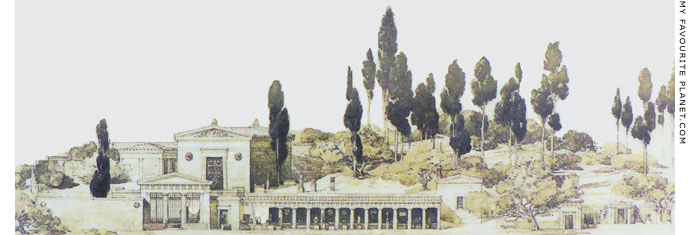
An idealized reconstruction of the Sanctuary of Malophoros, Selinous by Jean Hulot, 1910. [22] |
| |
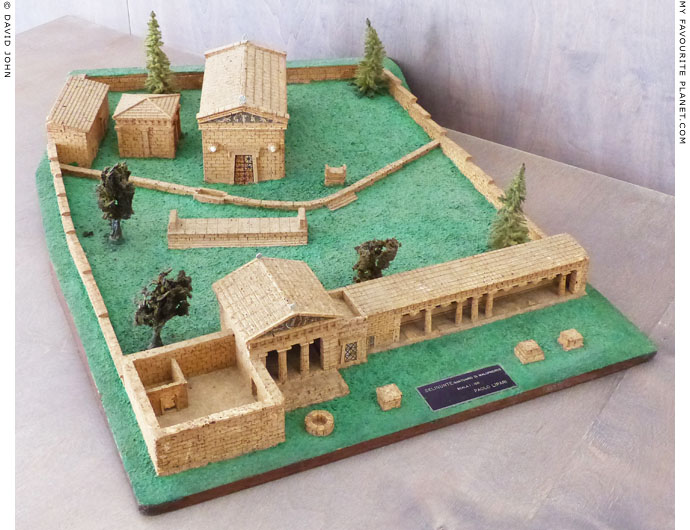
Scale model of the Sanctuary of Malophoros, Selinous, viewed from the east side.
Cork model by Paolo Lipari. Scale 1:100.
Baglio Florio Museum, Selinunte Archaeological Park, Sicily.
See also the plan of the sanctuary below.
|
The Sanctuary of Malophoros, a rectangular area of around 50 x 60 metres, was originally an open-air sanctuary without buildings. The earliest finds are from the 7th century BC, suggesting it was founded soon after the Greek colonists arrived.
Discovered in 1871, the site was excavated by Francesco Saverio Cavallari in 1874, Giuseppe Patricolo in 1888, Antonino Salinas in 1894 and by Ettore Gabrici 1915-1926. Since then archaeological investigations have been intermittent, including "Mission Malophoros" 1983-1985, and more recently the partial restoration of the propylon in 2015, during which the remains were surveyed with a 3D laser scanner as well as by more conventional techniques.
The sanctuary was identified by two inscriptions dedicated to Malophoros and Hekate (see photos below), as well as the enormous number of votive offerings of types known from other sanctuaries of Demeter in Sicily, including bronze statuettes, incense burners, lamps, ceramic vessels, jewellery, iron tools, various objects of bone, ivory and faience, along with around twelve thousand terracotta figurines, dating from the 7th to the 5th century BC, most depicting a female figure holding an apple or pomegranate.
As with the other buildings and areas of Selinous, little is known of the history or usage of the sanctuary from ancient authors or inscriptions, and many of the conclusions of archaeologists remain subjects of debate.
The history of the site is further complicated by the fact that Selinous was the westernmost Greek colony in Sicily, in an area surrounded by Carthaginian (Punic) and Elymian (indigenous Sicilian) populations. The area around the Gaggera spring may have been sacred to the Carthaginian and/or natives before, and even during and after the period of Greek occupation. Some of the finds, such as the Punic steles with the heads of deities (perhaps Zeus Meilichios and Pasikrateia, see photos below), are anhellenic (non-Greek), and also include objects from the Byzantine period.
The earliest buildings have been dated to the third quarter of the 6th century BC. The sanctuary was enclosed on three sides (north, west and south) by walls, over 2 metres high. The tops of the north and south walls were stepped due to the gradient of the hill. The east side was enclosed by a row of buildings (from north to south): a stoa (roofed colonnade) open to the outside of the sanctuary, with seats; a Doric propylon (monumental gateway) dated to the mid-late 5th century BC, with two columns in antis at either end; and an almost square building identified as a sanctuary of Hekate, perhaps Hekate Propylaia (Hekate of the Gateway). In front of the propylon is a circular stone structure, thought to be the remains of either a well or an altar.
At the back (western end) of the enclosure, the highest part of the sanctuary, were three buildings, the largest of which is thought to have been the temple of Demeter, or Megaron (μέγαρον, see photo below), a simple structure, 20.41 metres long and 9.52 metres wide, divided into three rooms: the pronaos, at the north of which was a smaller room, perhaps used for storage; the cella which includes the original megaron; and the adyton with a vaulted niche at the rear. The functions of the two smaller two-room buildings to left (south) of the temple are unknown.
Along the front of these buildings a raised stone water channel ran along the width of the sanctuary, north to south, carrying water from the nearby Gaggera spring, a few hundred metres north of the sanctuary. The channel widens into a small reservoir in front to the temple. This may be a later construction built to carry water down to the port at the mouth of the Selinos river. The channel is no longer connected to the spring, whose waters are contained by a large rectangular stone tank which overflows down the footpath in spring.
Almost in the centre of the sanctuary is a large, well-preserved altar of ashlar masonry, 16.3 metres long and 3.15 metres wide, dated to around 540 BC. A smaller altar stands just to the north of the temple and another near the propylon.
It is thought that the sanctuary was a stopping-off point for funeral processions between the city and the necropolis at Macinalunga to the north.
Immediately to the north of the Sanctuary of Malophoros is another enclosed sanctuary dedicated to Zeus Meilichios (Honey-sweet Zeus) and Pasikrateia (Persephone?). The square enclosure, 17 x 17 metres, contains the remains of Archaic structures apparently rebuilt during the Hellenistic period, in the 4th - 3rd century BC, including two porticos and a propylon leading to a small temple and an altar.
Several steles, dating from the second quarter of the 6th to the mid 5th century BC, have been discovered at this sanctuary. Some of these, including a herm, are inscribed with dedications to Zeus Meilichios, while others are topped by heads of a divine couple, thought to be either Zeus and Demeter or Plouton (Hades) and Persephone (see photos below).
See also:
A relief of the Gorgon Medusa on an altar from the Sanctuary of Malophoros, Selinunte
A relief of Perseus, Medusa and Athena on a metope from Temple C, Selinunte
Mistress of Animals on an oinochoe from Selinunte |
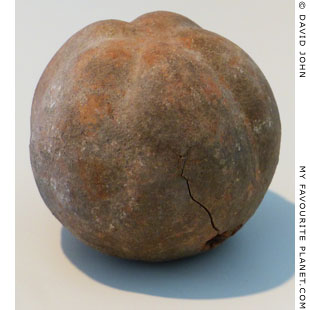
A terracotta apple from the
Sanctuary of Malophoros.
Made in East Greece (western
Anatolia and eastern Aegean islands),
late 6th - early 5th century BC.
Baglio Florio Museum,
Selinunte Archaeological Park,
Sicily. Inv. No. SL 19693. |
| |
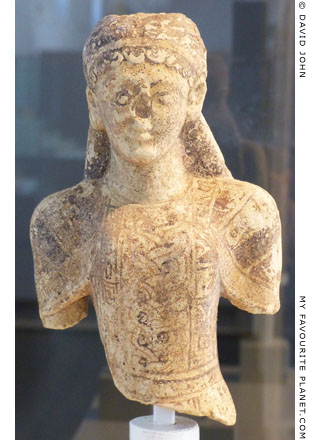
Part of a terracotta kore statuette
from the Sanctuary of Malophoros.
Made in Corinth,
first half of the 6th century BC.
Baglio Florio Museum,
Selinunte Archaeological Park,
Sicily. Inv. No. SL 36705. |
| |
| |
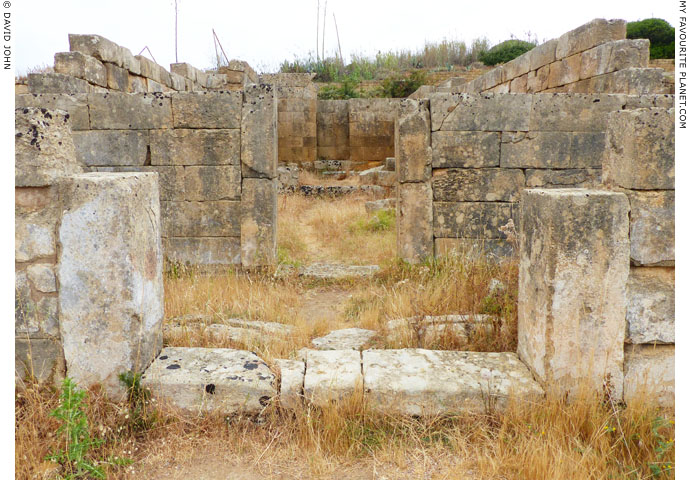
The remains of the Megaron in the Sanctuary of Malophoros, Selinous, as seen from
outside the doorway of the pronaos (front porch) at the east end of the building. |
| |
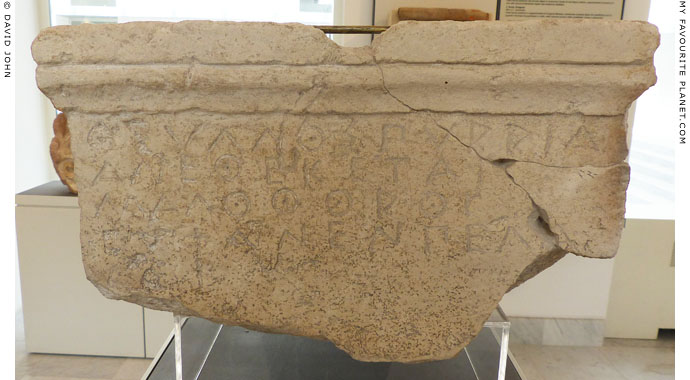
A base with a votive inscription dedicated to the Malophoros,
from the Sanctuary of Malophoros, Selinous.
"Theullos son of Pyrrias made [this]
dedication to the Malophoros ... (?) at sea"
Calcernite. 475-450 BC.
Antonino Salinas Regional Archaeological Museum, Palermo, Sicily. |
| |
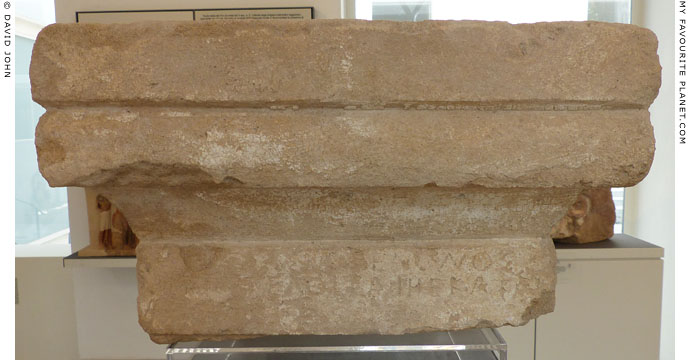
A statue base with a votive inscription dedicated to Hekate,
from the Sanctuary of Malophoros, Selinous.
"Alexias son of Xenon made [this] dedication
to the Angelos (Messenger) and to Hekate"
Calcernite. Circa 450 BC.
Antonino Salinas Regional Archaeological Museum, Palermo, Sicily.
|
The precinct in the southeast corner of the Sanctuary of Malophoros was identified as the sanctuary of Hekate on the evidence of this inscription. Statues or small sanctuaries of Hekate Propylaia (Hekate of the Gateway) were placed at the entrances of sanctuaries of major deities as a protection against evil. Pausanias reported that a statue of Hekate by Alkamenes stood in front of the entrance to the Athenian Acropolis (see the Alkamenes page).
"The Angelos" (messenger) probably refers to Triptolemos (see above) who, as Demeter's emissary, spread the cultivation of crops to humans. |
|
| |

A stone block with a votive inscription dedicated to Zeus and other gods,
including Malophoros and Pasikrateia, from the cella of "Temple G", Selinous.
Calcernite. Mid 5th century BC. Found in the temple in 1871.
Antonino Salinas Regional Archaeological Museum, Palermo, Sicily.
|
The fragmentary inscription has been reconstructed as:
"Through these gods the Selinuntines are victorious. We are victorious through Zeus and through Phobos, through Herakles and through Apollo and through Poseidon and through the sons of Tyndareus [the Dioskouroi] and through Athena and through Malophoros and Pasikrateia and through the other gods, but especially through Zeus. Since peace has been concluded, after having moulded in gold (?) and engraved these names, you shall make a dedication in the temple of Apollo and write Zeus' name first. The gold shall weigh sixty [silver] talents."
The enormous Doric limestone "Temple G" on the northern part of the East Hill of Selinous may have been dedicated to Zeus, and was built around the same time as the colossal temples of Zeus Olympios in Athens and Akragas (Agrigento). Construction commenced with the eastern end around 520 BC, but it remained uncompleted at the time of the Carthaginian conquest in 409 BC.
The enemies over which Selinous was victorious are not named, which has led scholars to believe that the text may refer to the city's miltary and political supremacy in general rather than a specific victory, or that the peace (philia) was concluded following a reconciliation at the end of a civil war. It has also been suggested that the form of the dedication and the specific deities credited with the victory may be due to an oracle from the Pythia at Delphi. |
|
| |
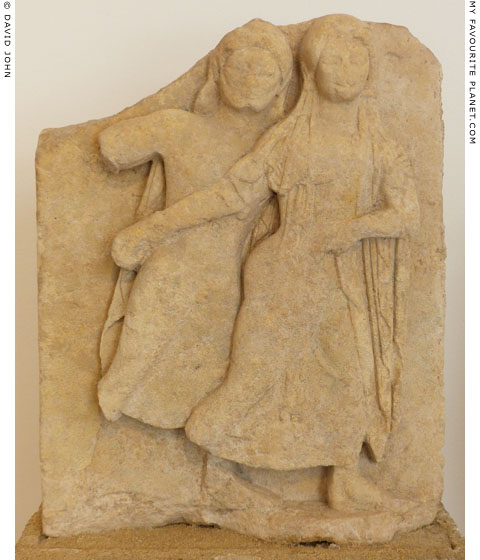
A limestone votive relief of thought to depict Plouton (Hades)
abducting Persephone. From the Temenos, west of the Propylon
of the Sanctuary of Malophoros, Selinous (Selinunte), Sicily.
End of the 6th century BC.
Antonino Salinas Regional Archaeological Museum, Palermo, Sicily. |
| |
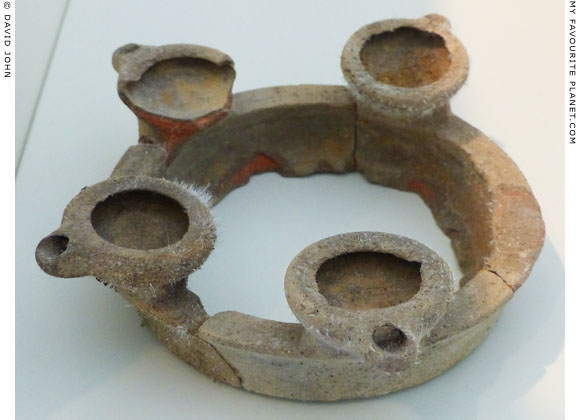
A small terracotta kernos (multiple lamp) from the Sanctuary of Malophoros, Selinous.
One of a number of kernoi from the sanctuary on display in the Selinunte museum.
6th - 4th century BC.
Baglio Florio Museum, Selinunte Archaeological Park, Sicily. Inv. No. SL 20317. |
| |
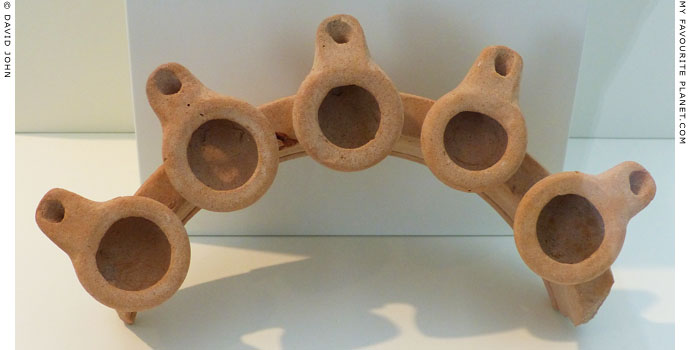
Part of a larger terracotta kernos from the Sanctuary of Malophoros, Selinous. 6th - 4th century BC.
Baglio Florio Museum, Selinunte Archaeological Park, Sicily. Inv. No. SL 20318. |
| |
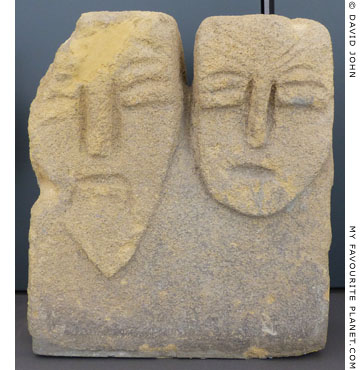 |
|
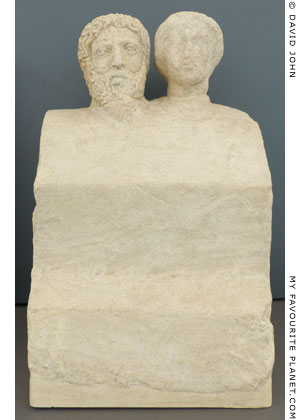 |
Two stone steles found at the Sanctuary of Zeus Meilichios (Ζευς Μειλίχιος,
Honey-sweet Zeus; the Friendly or the Kindly, Gracious, Merciful) and
Pasikrateia (Persephone?), north of the Sanctuary of Malophoros at Selinous.
Among several steles of the 6th - 5th century BC with heads of a male and a
female deity on top, found inside the peribolos wall. The divine couple is
thought to be either Zeus and Demeter or Plouton (Hades) and Persephone.
Antonino Salinas Regional Archaeological Museum, Palermo, Sicily. |
|
| |
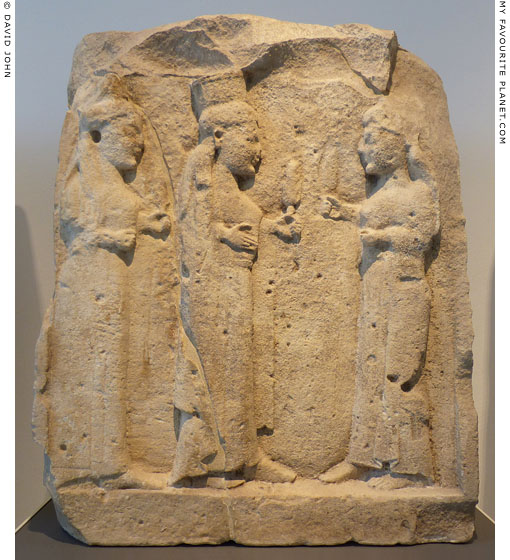
Metope Y7 from "Temple Y" on the acropolis of Selinunte, also known
as the "Temple of the Small Metopes", with a low relief of three female
figures, perhaps depicting Demeter, Persephone and Hekate.
560-550 BC. Local limestone from Menfi, northeast of Selinute. Height 84 cm.
Antonino Salinas Regional Archaeological Museum, Palermo, Sicily.
|
Each of the three female figures, shown in profile, wears a polos and a peplos. The central figure may also be wearing a cloak. They have been variously identified as: Demeter, Persephone and Hekate; the Horai (the three Seasons); the Moroi (the three Fates); the Charites (the Three Graces); or Persephone with two companions, either the Okeanides (sea nymphs) or Athena and Artemis, collecting flowers just before her abduction by Plouton (see the sarcophagus relief in Part 2). The objects held by the figures have been seen as flowers, ears of wheat, spindles or torches, and it has also been suggested that the scene is a ritual of the Eleusinian Mysteries.
The relief has been compared to that on a ceramic altar from Gela (see Part 2), Sicily, also thought to depict Demeter, Persephone and Hekate or Aphrodite.
The six surviving small metopes and a dozen fragments of others associated with "Temple Y" had been reused in the Hellenistic fortifications of the city of the 4th - 3rd century BC, known as Hermocrates’ wall. Archaeologists have divided them into two groups according to the forms of the frames around the blocks. Four of the metopes, including the one above, belong to the first group, while the relief in the photo below is from the second group. It is thought that the latter may have been made later, and either placed on the opposite side of "Temple Y" to the first group, or to have come from another, unidentified building, perhaps the hypothetical "Temple X". |
|
| |
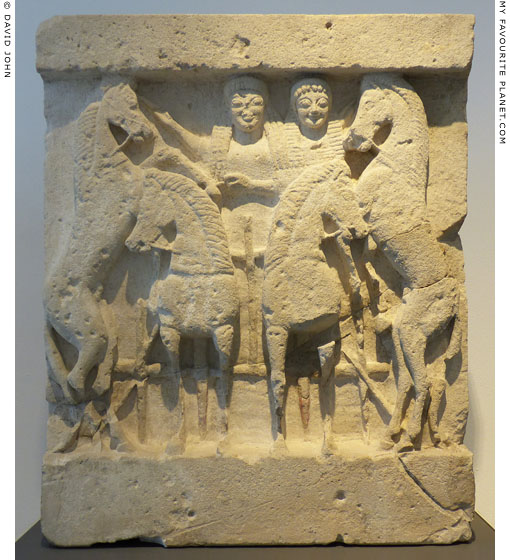
A metope from "Temple Y", Selinunte, with a relief of two deities on a
chariot, identified as either Demeter and Persephone, or Hera and Athena.
Other deities, including Helios, Apollo and Selene, have also been suggested.
560-550 BC. Local limestone from Menfi. Height 84 cm.
Antonino Salinas Regional Archaeological Museum, Palermo, Sicily.
|
The chariot is sometimes described as a quadriga (four-horse chariot), however the two rearing horses on either side are clearly not harnessed to the chariot, although they wear bridles. They stand on their rear legs, with perhaps one fore-hoof resting on the chariot, and appear to be greeting or saluting the two figures.
Demeter and Persephone were associated with horses through their connection in myths with Poseidon as Hippios (Ἵππιος, Horse God), a chthonic (underworld) deity of the River Styx. Chased by her brother Poseidon, Demeter transformed herself into a mare and hid among the horses of King Onkios in western Arcadia. But Poseidon, in the form of a stallion, discovered her and mated with her. She subsequently gave birth to Despoina and the immortal horse Areion (Αρειων). It has also been suggested that Mycenaean inscriptions from Pylos in the southwest Peloponnese with dedications "to the two queens and the king" refer to Demeter, Persephone and Poseidon [23].
Pausanias mentioned a bronze statue by Onatas of Aegina, modelled on an even more ancient xoanon (cult statue) of Demeter at her cave sanctuary on Mount Elaion (Ἐλάιον), near Phigalia (Φιγαλία) in Arcadia [24], western Peloponnese, which had a horse's head and held a dolphin, a symbol of Poseidon. He also related a local version of the Demeter myth, including the intervention of Pan and the Fates, and wrote that when the Phigalians neglected the goddess they suffered from famine until they followed the Delphic oracle to honour her again.
"The second mountain, Mount Elaius, is some thirty stades away from Phigalia, and has a cave sacred to Demeter surnamed Melaine [Μέλαινη, the Black One]. The Phigalians accept the account of the people of Thelpusa about the mating of Poseidon and Demeter, but they assert that Demeter gave birth, not to a horse, but to the Mistress [Despoina], as the Arcadians call her.
Afterwards, they say, angry with Poseidon and grieved at the rape of Persephone, she put on black apparel and shut herself up in this cavern for a long time. But when all the fruits of the earth were perishing, and the human race dying yet more through famine, no god, it seemed, knew where Demeter was in hiding, until Pan, they say, visited Arcadia. Roaming from mountain to mountain as he hunted, he came at last to Mount Elaius and spied Demeter, the state she was in and the clothes she wore. So Zeus learnt this from Pan, and sent the Fates to Demeter, who listened to the Fates and laid aside her wrath, moderating her grief as well. For these reasons, the Phigalians say, they concluded that this cavern was sacred to Demeter and set up in it a wooden image.
The image, they say, was made after this fashion. It was seated on a rock, like to a woman in all respects save the head. She had the head and hair of a horse, and there grew out of her head images of serpents and other beasts. Her tunic reached right to her feet; on one of her hands was a dolphin, on the other a dove. Now why they had the image made after this fashion is plain to any intelligent man who is learned in traditions. They say that they named her Black because the goddess had black apparel.
They cannot relate either who made this wooden image or how it caught fire. But the old image was destroyed, and the Phigalians gave the goddess no fresh image, while they neglected for the most part her festivals and sacrifices, until the barrenness fell on the land. Then they went as suppliants to the Pythian priestess and received this response:
'Azanian Arcadians, acorn-eaters, who dwell
In Phigaleia, the cave that hid Deo, who bare a horse,
You have come to learn a cure for grievous famine,
Who alone have twice been nomads, alone have twice lived on wild fruits.
It was Deo who made you cease from pasturing, Deo who made you pasture again
After being binders of corn and eaters of cakes,
Because she was deprived of privileges and ancient honours given by men of former times.
And soon will she make you eat each other and feed on your children,
Unless you appease her anger with libations offered by all your people,
And adorn with divine honours the nook of the cave.'
When the Phigalians heard the oracle that was brought back, they held Demeter in greater honour than before, and particularly they persuaded Onatas of Aegina, son of Micon, to make them an image of Demeter at a price. The Pergamenes have a bronze Apollo made by this Onatas, a most wonderful marvel both for its size and workmanship. This man then, about two generations after the Persian invasion of Greece [480 BC], made the Phigalians an image of bronze, guided partly by a picture or copy of the ancient wooden image which he discovered, but mostly (so goes the story) by a vision that he saw in dreams."
Pausanias, Description of Greece, Book 8, chapter 42, sections 1-7. At Perseus Digital Library.
Later in the same chapter, Pausanias reported that the statue no longer existed, and described the nature of the rites and sacrifices at the cave sanctuary of Demeter Melaine on Mount Elaion.
"It was mainly to see this Demeter that I came to Phigalia. I offered no burnt sacrifice to the goddess, that being a custom of the natives. But the rule for sacrifice by private persons, and at the annual sacrifice by the community of Phigalia, is to offer grapes and other cultivated fruits, with honeycombs and raw wool still full of its grease. These they place on the altar built before the cave, afterwards pouring oil over them.
They have a priestess who performs the rites, and with her is the youngest of their 'sacrificers', as they are called, who are citizens, three in number. There is a grove of oaks around the cave, and a cold spring rises from the earth.
The image made by Onatas no longer existed in my time, and most of the Phigalians were ignorant that it had ever existed at all. The oldest, however, of the inhabitants I met said that three generations before his time some stones had fallen on the image out of the roof; these crushed the image, destroying it utterly. Indeed, in the roof I could still discern plainly where the stones had broken away."
Book 8, chapter 42, sections 11-13.
The tale of Poseidon as a horse mating with Demeter to give birth to two children, one in the form of a horse, is similar to the story of Medusa and her children Pegasus and Chrysaor by Poseidon. Pausanias' description of the xoanon in Phigalia having snakes growing out the head also echoes images of Medusa.
See reliefs of Poseidon and Demeter from Smyrna (Izmir) in Part 2. |
|
| |
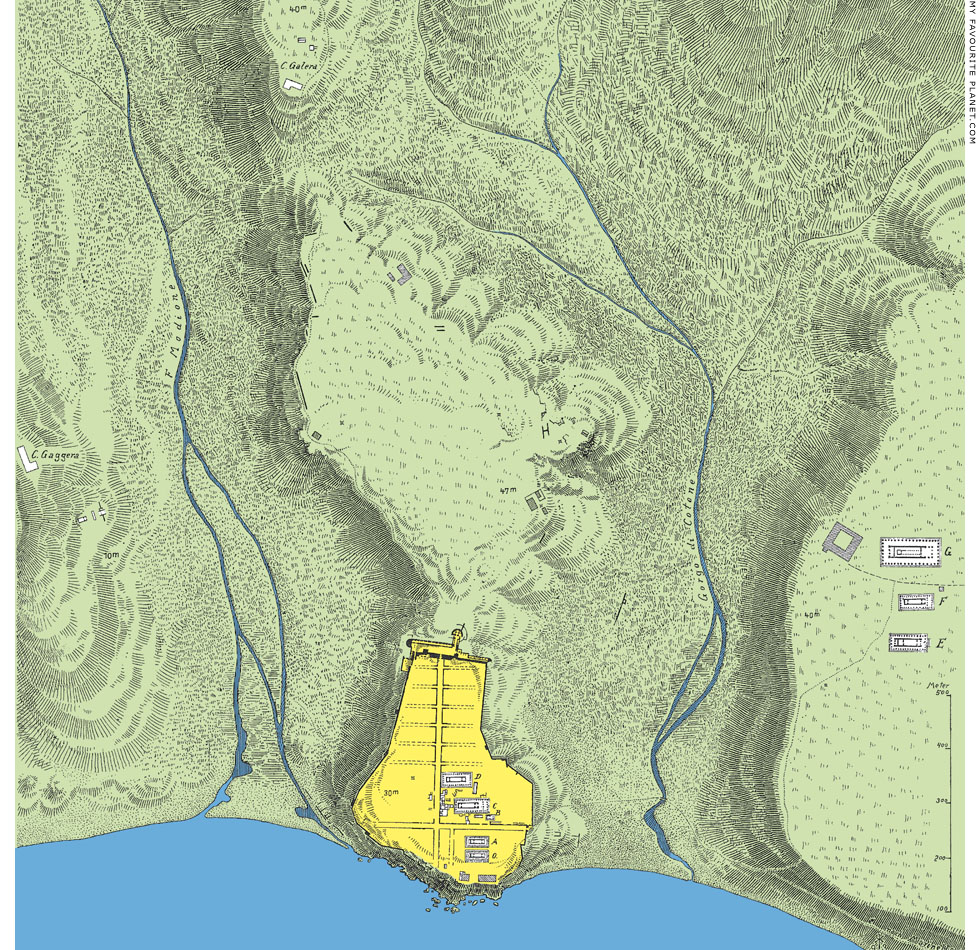
Map of the archaeological site of Selinous (Selinunte), on the south coast of Sicily.
Map after: Robert Koldewey and Otto Puchstein, Die griechischen Tempel in Unteritalien und Sicilien,
Band 2, Tafel 29. A. Ascher & Co., Berlin, 1899. At Heidelberg University Digital Library.
|
Marked in yellow in the centre is the city's acropolis, including temples A, B, C,and D and a grid of streets. The highest point of the city (marked 47 metres on this map) was on the hill immediately to the north, where the remains of ancient necropoli (cemeteries) have been discovered.
To the east (right), on the other side of the valley of the Calici river (Gorgo di Cotone), Temples G, F and E stand on another, larger and higher plateau. To the west (left) is the valley of Selinos river (today the Modione), on the west bank of which is the area known as Contrada Gaggera where there were a number of smaller temples and sanctuaries, including the Sanctuary of Malophoros.
Selinunte claims to be the largest archaeological site in Europe. Most of it is covered in this map, and a lot more of the ancient city has been uncovered since it was drawn in 1893. The map still provides a good topographical overview of the site, but naturally does not include more recent discoveries or modern facilities, such as the site entrance, the museum, toilets or the footpaths and bridges. |
|
| |
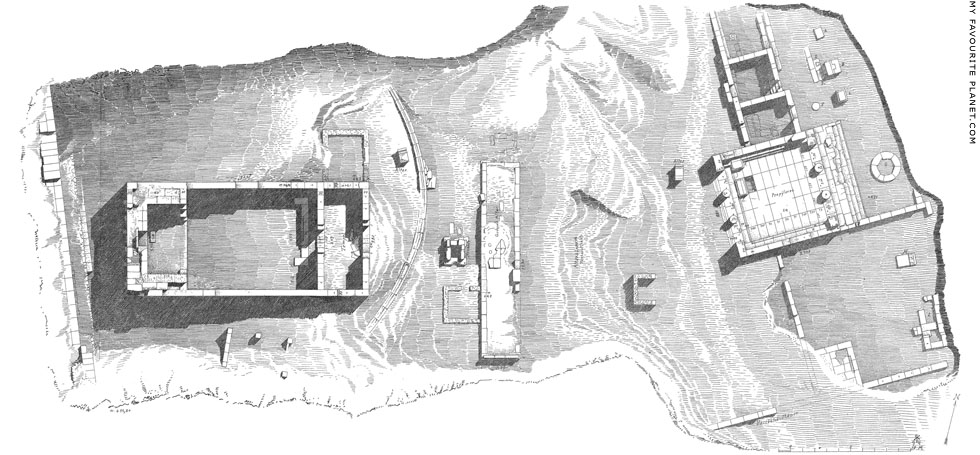
Plan of the Sanctuary of Malophoros, Selinous, Sicily.
The walled sanctuary was entered through the propylon, the monumental gateway at the east side
(right). The largest building on the west side (left), on the highest level of the sanctuary, is the temple
of Demeter or Megaron, in front of which (centre) are the remains of the 16.3 metre long altar.
The quality and detail of this plan are excellent and it can still be used today as a guide to the site,
which has not changed much since it was drawn. Not many tourists venture this far west of the
archaeological site, the main focus areas for most visitors being the acropolis and the temples in the
east. The buildings of the Malophoros sanctuary are freely accessible, and walking around the quieter
Gaggera sanctuaries and the green Selinos (Modione) valley is very enjoyable, especially in spring.
Source: Robert Koldewey and Otto Puchstein, Die griechischen Tempel in Unteritalien und Sicilien,
Band 2, Tafel 11. A. Ascher & Co., Berlin, 1899. At Heidelberg University Digital Library. |
| |
| |
Sanctuaries of Demeter and Persephone
Achradine, Syracuse, Sicily |
 |
|
| |
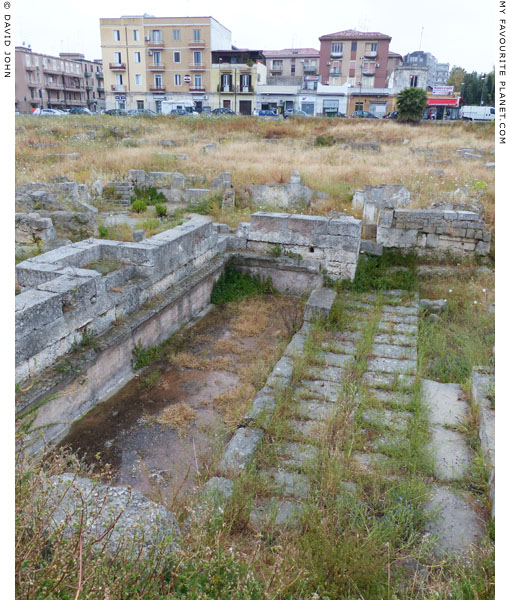
The remains of the 5th century BC rectangular fountain basin
to the east of the temple believed to be the temple of Demeter,
in the Piazza della Vittoria Archaeological Zone, Syracuse.
|
| The raised construction along the south (left) side of the fountain is what remains of a 3rd century BC monument with a central niche for statues of a god or gods. A portico stood on the north (right) side. The foundations of the temple lie hidden in the grass to the west of (behind) the fountain, on the other side of a later street which runs north to south. |
|
| |
Syracuse (Συράκουσαι; Italian, Siracusa), near the south end of the east coast of Sicily, was founded in 734 or 733 BC by Greek colonists from Corinth and Tenea (Τενέα) in Corinthia, led by the oecist (colonizer) Archias (Strabo, Geography, Book 8, chapter 6, section 22). The original settlement was on the easily defensible island of Ortygia (Ὀρτυγία), at the south of the mainland area onto which the city later expanded (see map below). The main sanctuaries on the island were those of Artemis, Apollo, Athena, Zeus Olympios and the nymph Arethousa. Artemis was the principal goddess until 5th century BC when Athena became the main deity. Arethousa was represented as the symbol of the city on its coins (see examples on the Nike page).
The Sicilian historian Diodorus Siculus (Διόδωρος Σικελιώτης, 1st century BC) reported that the temples of Demeter and Kore in the Syracusan suburb Achradine (Ἀχραδίνη, wild pear trees), north of Ortygia, were plundered by the Carthaginian general Himilco (in Greek Ἱμίλκων, Himilkon), during his unsuccessful siege of the city in 396 BC [see note in part 2]. They were built outside the walls of the borough by the tyrant Gelon (Γέλων) in thanks to the goddesses for the Greek defeat of the Carthaginian invasion at Himera in 480 BC, a gesture in the same spirit as Theron's building of the temple of Demeter and Persephone at Akragas (see part 2).
Archaeological excavations during the 1960s - 1980s revealed the foundations of only one temple, of the 5th century BC, in the Piazza della Vittoria, in the area thought to be the location of ancient Achradine. To the north of the temple a large deposit of votive offerings was discovered, including hundreds of terracotta statuettes of Demeter with her usual attributes such as torches and piglets. Debate continues as to whether this was the temple desecrated by Himilco.
The "Well of Artemis" ("Pozzo di Artemide") [25], 7 metres deep and 90 cm wide, was discovered in 1968, and named by Professor G. Voza after a Greek dedication to Artemis Pheraia inscribed on a large black-painted krater, dated to the late 4th century BC, found among a large deposit of objects in the well, including the "Artemis Well bust" (see below). It has been suggested that the sanctuary area may have been shared by Demeter, Persephone and Artemis.
The sanctuary was established next to an Archaic necropolis, and much of the area was built over with houses and streets from the Hellenistic period as the city expanded. A large part of what is thought to be the site of the sanctuary is now occupied by the enormous modern Santuario Madonna delle Lacrime (see photo below), a church built 1966-1994, over the road from the Paolo Orsi Regional Archaeological Museum and 1.5 km north of Ortygia. The remains of a building believed to be connected with the sanctuary can be seen inside the church itself.
Behind (south of) the church is a large fenced area, known as the Zona Archeologica di Piazza della Vittoria (see photo above), containing the foundations of the temple (18 x 10 metres) with the remains of an altar and a rectangular fountain basin, as well as several houses of the Hellenistic and Roman periods. Around the area of the sanctuary are also the remains of the Archaic necropolis.
Cicero, writing in the 1st century BC, mentioned "two temples of great beauty, one of Ceres, the other of Libera" that he had seen when he was in Syracuse, but near the Greek theatre in the Neapolis (Νέαπόλις) district, to the north of Achradine. These temples were presumably built later to replace those desecrated by Himilco. He usually referred to Persephone as "Libera", the Roman wine and fertility goddess and female counterpart of Liber Pater (Father Liber, the Roman equivalent of Dionysus), She was officially identified with Proserpina following the institution of the Demeter/Ceres cult in Rome (see below). He also described Liber and Libera as children of Ceres. The Roman mythographer Hyginus referred to Liber as the son of Jove (Zeus) and Proserpine (Persephone). [26]
See: Marcus Tullius Cicero (106-43 BC), Against Verres, Actio 2, Book 4, chapter 53 (lines 118-119). At Perseus Digital Library.
An Attic black-figure calyx-krater, made in Athens around 510 BC, found in the Archaic necropolis, is decorated with paintings attributed to an artist related to the Antimenes Painter. On Side A Herakles and Athena in a chariot surrounded by other deities, and on Side B Dionysus with Satyrs and Maenads (see Dionysus).
Achradine also had an agora (market place) and a sanctuary of Asklepios, which was first excavated in 1804 (see Asklepios). |
|
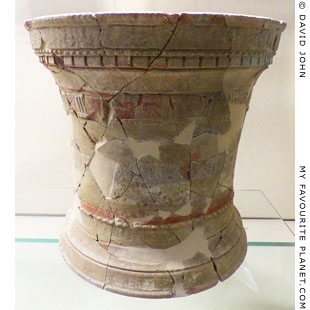
Small portable terracotta altar from the
Piazza della Vittoria Archaeological Zone,
Syracuse, Sicily. 4th century BC.
Paolo Orsi Regional Archaeological
Museum, Syracuse. Inv. No. 96565. |
|
| |
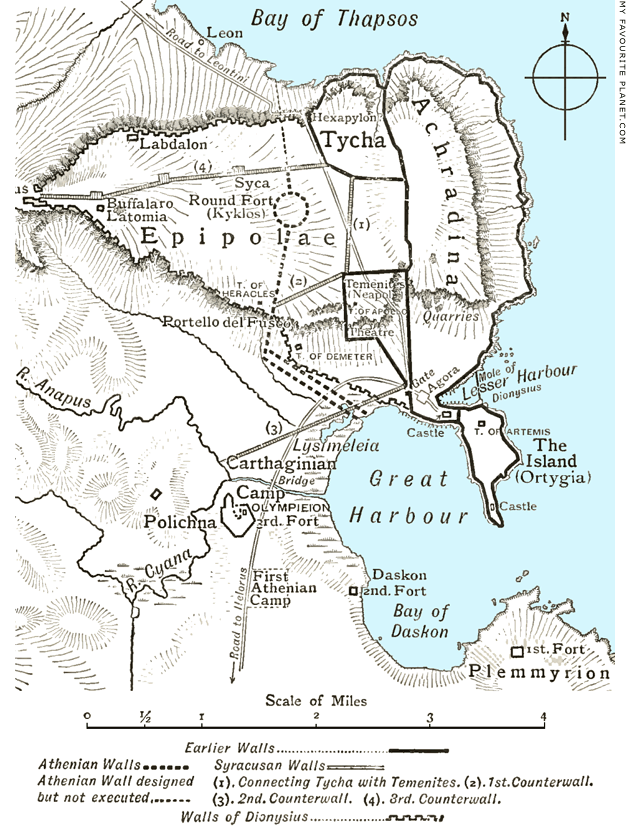
A map of ancient Syracuse.
Source: George Francis Hill, Illustrations of school classics, No. 512, "Syracuse: Map illustrating the
Athenian and Carthaginian sieges", page 416. Macmillan, London, 1903. At the Internet Archive. |
| |
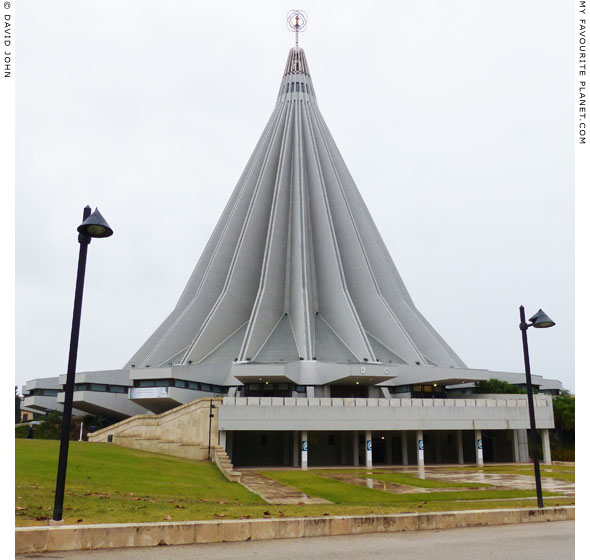
The Santuario Madonna delle Lacrime (Shrine of Madonna of Tears), Syracuse.
Consecrated on 6th November 1994 by Pope John Paul II.
|
| On 29th August 1953 a plaster statuette of the Virgin Mary in the house of the Syracusan family Iannuso began weeping, and the miraculous tears soon began attracting pilgrims. The enormous "sanctuary", the largest pilgrimage church in Sicily, was built between 1966 and 1994, during which time archaeologists attempted to rescue what was possible from around the ancient site. The modern temple to the divine mother of Christianity now stands over the sanctuary of the Greek mother goddess. |
|
| |
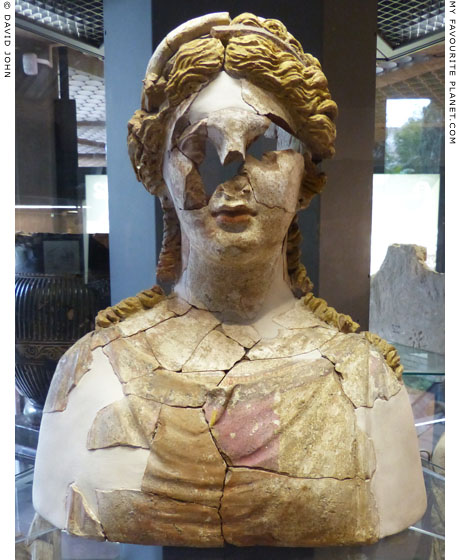
The "Artemis Well bust", restored fragments of a larger than life-size
polychrome painted ceramic bust of the type belonging to the cult
of Demeter and Kore. Early 4th century BC.
Found in 1968 in the "Well of Artemis", in the area of the temple
of Demeter, Piazza della Vittoria, Syracuse, Sicily. Height 50.5 cm.
Paolo Orsi Regional Archaeological Museum, Syracuse. Inv. No. 66951.
|
One of the finest surviving terracottas of the type found in Syracuse and other sanctuaries of Demeter and Persephone in Sicily. The bright colours, reds and yellows, are well preserved.
The flesh of the figure is white, the lips deep red and the hair gold. A section of the upper part of her chiton (tunic) is violet, and traces have survived of a frieze of animals, perhaps griffins, in dark red.
For a discussion of the dating of this bust see:
Mario Cottonaro, A female clay bust in the "Artemis Well" in Syracuse: New chronological proposal, in: Pietro Maria Militello and Hakan Öniz (editors), SOMA 2011, Proceedings of the 15th Symposium on Mediterranean Archaeology, held at the University of Catania 3-5 March 2011, Volume I, pages 557-561. Archaeopress, Oxford, 2015. At academia.edu.
See other terracotta busts and statuettes of this type
from Sicily in Demeter and Persephone part 2.
A great number of figurative ceramics from the ancient Greek world, particularly from Sicily, have been identified by scholars as relating to the cult of Demeter and Persephone. More recently, however, some of these identifications are being questioned and reassessed in the light of modern research into religious iconography and the nature of the mass production and marketing of ceramics for religious use.
See: Jaimee P. Uhlenbrock, Research perspectives in Greek coroplastic studies: The Demeter paradigm and the goddess bias. In: Les Carnets de l’ACoSt, the journal of the Association for Coroplastic Studies, No. 14, Summer 2016. At OpenEdition Journals. |
|
| |
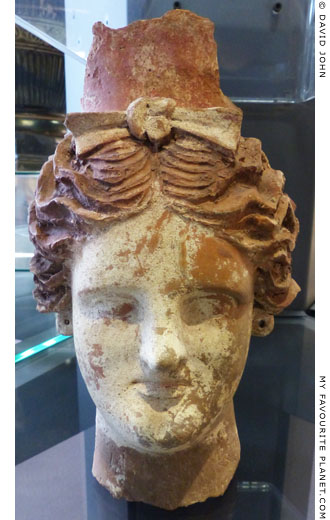
Terracotta head of a bust as a votive offering to Demeter and Kore.
3rd century BC. From Piazza della Vittoria, Syracuse, Sicily.
The paint on the head is badly worn and the top of the polos
is broken off, but the headband tied at the front with a Herakles
knot has survived. This is a feature of several similar terracotta
busts and statuettes from Sicily (see part 2).
Paolo Orsi Regional Archaeological Museum, Syracuse. Inv. No. 668968. |
| |
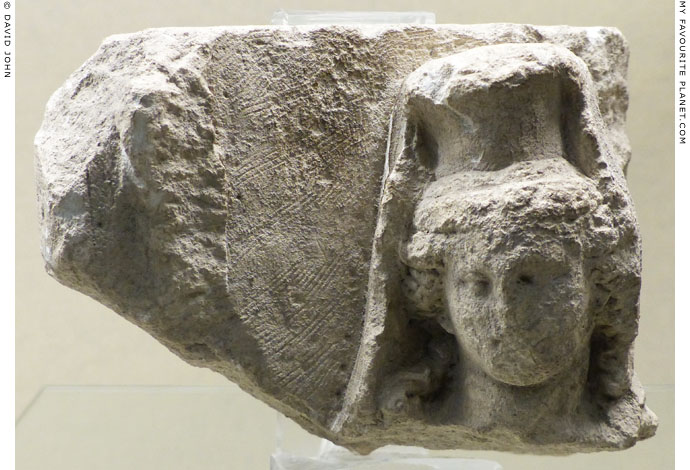
Fragment of a limestone relief showing the head of a goddess, perhaps Demeter.
The figure wears a polos covered with a veil, probably part of her himation (cloak).
4th century BC. From the sanctuary of Demeter, Piazza della Vittoria, Syracuse, Sicily.
Paolo Orsi Regional Archaeological Museum, Syracuse. Inv. No. 96564. |
| |
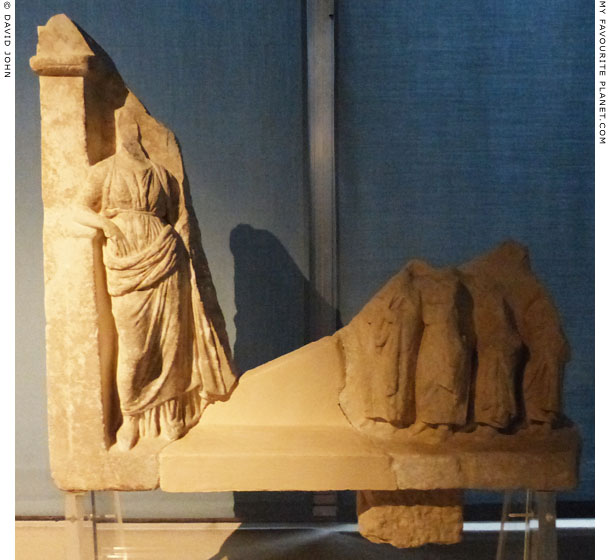
Fragments of a marble votive relief of a goddess, perhaps Demeter,
and a group of four worshippers in a naiskos (small temple).
2nd half of the 4th century BC. From Syracuse, Sicily. Pentelic marble.
Paolo Orsi Regional Archaeological Museum, Syracuse. Inv. No. 50687. |
| |
| |
Sanctuaries of Demeter and Persephone
The Sacred Ship of Demeter and Persephone |
 |
|
| |
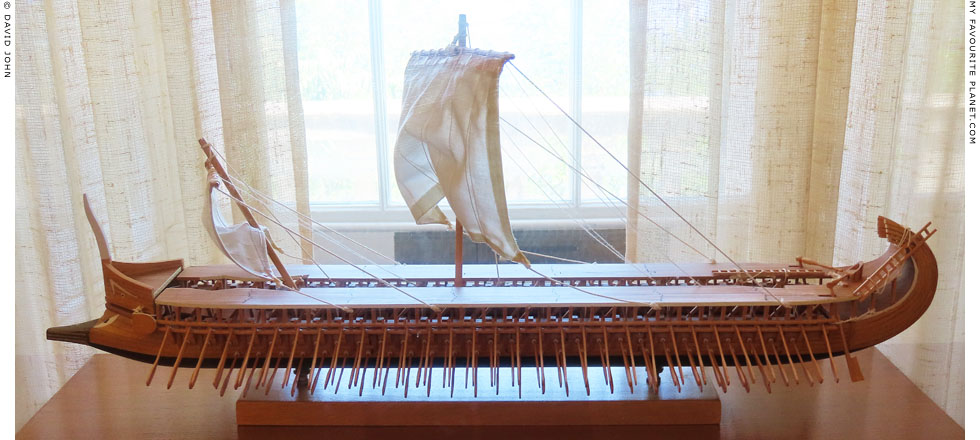
A model of a trireme in Mon Repos Museum, Corfu.
The first Greek triremes were built about 650-610 BC in Corinth or Samos. They were powered
by as many as 179 oarsmen sitting in three rows, a large square sail on a mast around the centre
of the ship and a smaller sail near the prow. Athenian triremes, considered to be the best, were
37 metres long, 5.2 metres wide, and could reach a speed of around 12 knots.
|
In the mid fourth century BC much of the Greek part of Sicily (mainly the east and south of the island) was dominated by competing tyrants. The Syracusan general Hiketas (Ἱκέτας) became tyrant of Leontinoi, raised a large army, and with the help of a Carthaginian fleet waged war against the unpopular Dionysios II of Syracuse. [27] A group of Sicilians opposed to the tyrants sent an embassy to Corinth to appeal for help. By 344 BC Hiketas had taken the greater part of Syracuse and was besieging the island citadel of Ortygia (see above) in which Dionysios had taken refuge.
In the same year the Corinthian general Timoleon (Τιμολέων, circa 411-337 BC) set sail for Sicily with a relatively small expeditionary force. Despite being hugely outnumbered, he was unexpectedly and spectacularly victorious, and managed to rid the island's Greek cities of tyrants and the threat of Carthaginian invasion.
According to ancient sources, just before Timoleon's fleet left for Sicily, the priestesses of Demeter and Persephone at Corinth claimed the goddesses appeared in a dream and announced that they would accompany him to Sicily, "their sacred island". Taking this as a sign of divine support, the Corinthians pronounced one of their triremes sacred and named it "The Sacred Ship of Demeter and Persephone". As a further sign, it was said that a bright light blazed in the sky, resembling the fire of the torches used in the Mysteries, guiding the ships on their night crossing of the Ionian Sea from Leukas (Λευκάς, today Lefkada) and Korkyra (Κόρκυρα, today Corfu) to Italy.
Although the sources of these stories have disappeared, they were retold by the Sicilian historian Diodorus Siculus (Διόδωρος Σικελιώτης, Diodoros Sikeliotes) in the first century BC.
"When Eubulus was archon at Athens [July 345 - June 344 BC], the Romans elected as consuls Marcus Fabius and Servius Sulpicius [345 BC]. In this year Timoleon the Corinthian, who had been chosen by his fellow citizens to command in Syracuse, made ready for his expedition to Sicily. He enrolled seven hundred mercenaries and, putting his men aboard four triremes and three fast-sailing ships, set sail from Corinth. As he coasted along he picked up three additional ships from the Leucadians and the Corcyraeans, and so with ten ships he crossed the Ionian Gulf.
During this voyage, a peculiar and strange event happened to Timoleon. Heaven came to the support of his venture and foretold his coming fame and the glory of his achievements, for all through the night he was preceded by a torch blazing in the sky up to the moment when the squadron made harbour in Italy. Now Timoleon had heard already in Corinth from the priestesses of Demeter and Persephone that, while they slept, the goddesses had told them that they would accompany Timoleon on his voyage to their sacred island. He and his companions were, in consequence, delighted, recognizing that the goddesses were in fact giving them their support. He dedicated his best ship to them, calling it 'The Sacred Ship of Demeter and Persephone'."
Diodorus Siculus, The Library of History, Book 16, chapter 66. From Volume 8 of the Loeb Classical Library edition, 1963. At Bill Thayer's LacusCurtius website, University of Chicago.
Around a century later Plutarch (Πλούταρχος, Plutarchos, circa 46-120 AD) recounted much the same tales, probably using the same sources as Diodorus. The Boeotian biographer was also a priest of the oracle of Apollo at Delphi, and was fond of including supernatural signs such as omens, prophecies and visions in his narratives.
"When the fleet was ready, and the soldiers provided with what they needed, the priestesses of Persephone fancied they saw in their dream that goddess and her mother making ready for a journey, and heard them say that they were going to sail with Timoleon to Sicily. Therefore the Corinthians equipped a sacred trireme besides, and named it after the two goddesses.
Furthermore, Timoleon himself journeyed to Delphi and sacrificed to the god, and as he descended into the place of the oracle, he received the following sign. From the votive offerings suspended there a fillet which had crowns and figures of Victory embroidered upon it slipped away and fell directly upon the head of Timoleon, so that it appeared as if he were being crowned by the god and thus sent forth upon his undertaking.
And now, with seven Corinthian ships, and two from Corcyra, and a tenth which the Leucadians furnished, he set sail. And at night, after he had entered the open sea and was enjoying a favouring wind, the heavens seemed to burst open on a sudden above his ship, and to pour forth an abundant and conspicuous fire. From this a torch lifted itself on high, like those which the mystics bear, and running along with them on their course, darted down upon precisely that part of Italy towards which the pilots were steering. The soothsayers declared that the apparition bore witness to the dreams of the priestesses, and that the goddesses were taking part in the expedition and showing forth the light from heaven; for Sicily, they said, was sacred to Persephone, since mythology makes it the scene of her rape; and the island was given to her as a wedding present.
Such, then, were the signs from Heaven which encouraged the expedition; and making haste, since they were crossing the open sea, they skirted the coast of Italy."
Plutarch, The Parallel Lives, The Life of Timoleon, chapter 8, sections 1-5. From Volume 9 of the Loeb Classical Library edition, 1920. At Bill Thayer's LacusCurtius website, University of Chicago.
Modern scholars have attempted to provide a rational explanation for the mysterious "torch", for instance in a natural phenomenon, either astronomical, such as a comet, or meteorological, such as Saint Elmo's Fire. [28]
Since Corinth had founded or co-founded cities in Magna Graecia (southern Italy) and Sicily, including Syracuse (see above), it may have claimed to be acting from a sense of responsibility and solidarity as a metropolis (mother city) in its miltary intervention to save the Sicilian Greeks from the tyrants, but more especially from the two enormous invasion fleets sent by the Carthaginians. But its motives were probably not entirely selfless. Had Sicily fallen to Carthage, Greece would have probably been denied vital grain supplies and other trading advantages. Demeter and Persephone were perhaps ideal as the symbolic heavenly supporters of the campaign, since they were such important deities to both Corinthians and Sicilians, and were deemed divine guarantors of food security. |
|
| |
| |
Sanctuaries of Demeter and Persephone
Delos |
 |
|
| |
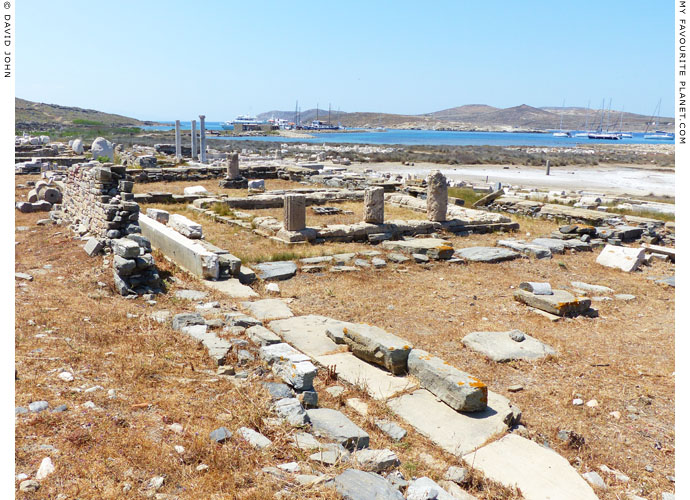
The so-called "Thesmophorion" or "Temple of Demeter" in Delos, Greece.
|
Delos was believed to be the place where Leto gave birth to Apollo and his twin sister Artemis, and the ancient Sanctuary of Apollo was the most important location on the small Cycladic island. A number of residential and commercial areas grew around the sanctuary, and with the increasing population came shrines and sanctuaries dedicated to other deities. The dates of the introduction of older cults are not known, although the establishment of later deities, such as Asklepios, Serapis and Isis, can be more reliably estimated.
From ancient inscriptions and literature it is known that the Thesmophoria festival was celebrated on the island, and that Demeter, Persephone and Eubouleus were worshipped here as elsewhere in the Cyclades. The Greek rhetorician Athenaeus of Naucratis (Ἀθήναιος Nαυκρατίτης, 2nd - 3rd century AD) cited the Delias, a lost history Delos by Semos, who mentioned achaenae (ἀχαΐνη), loaves or cakes, probably of barley, made in the shape of animals such as goats for the Megalartia festival in honour of Demeter (who Athenaeus elsewhere refers to as "our Lady of the Grain and of Abundance") and Persephone:
"Achaenae loaves. This bread is mentioned by Semos in the eighth book of the Delias. He says that it is made in honour of Demeter and Kore. They are large loaves and a festival called Megalartia is celebrated by persons who contribute it, reciting the words, 'a goat full of lard for our Lady of Sorrows.'"
Athenaeus, The Deipnosophistae, Book 3, chapter 109. At Bill Thayer's LacusCurtius website, University of Chicago.
However, much of Delos has not been thoroughly excavated and the location of the cult centre has not been discovered. Until recently the long rectangular building at the northwest corner of the Sanctuary of Apollo, dated to around 480 BC, was believed to be the Thesmophorion or Temple of Demeter, and a marble plaque at its remains (as well as some older plans of the site) still announce it as the "Temple of Demeter" (see photo, above right). This theory has been refuted, and the building, now simply referred to as "building with the colonnaded court", is currently thought to have been a restaurant, although no other possible site for the Thesmophorion been discovered. Certainly there appear to be no artefacts from this building in the Delos Archaeological Museum which can be definitely associated with Demeter and Persephone. As at other Greek cities, one would expect to find the Thesmophorion away from the main settlement, but many of the areas around the island, some of which are strewn with scant remains, have yet to be investigated.
The building, 37.65 metres long and 14.75 metres wide, lying on a north-south axis along the shore of the Sacred Harbour, was built of gneiss and marble. It consists of three sections. At the both north and south ends is a room in which the roof was supported by four Ionic columns, arranged in a square. These two rooms were previously believed to be cellas of the temple, dedicated to Demeter and Persephone. Between the rooms was a central open courtyard (in the centre of the photo above) surrounded by a Doric peristyle, with a column at each corner and four columns along each side. A well can still be seen in the centre of the south end of the court, and the entrance doorway to the building was on its west side (the photo was taken from the northeast corner, looking southwest towards the harbour). Around the building now lie broken stone remains from various periods, including early Christian fragments.
See: Fotini Zaphiropoulou, Delos, monuments and museum, page 28 (plan number 41). Krene Editions, Athens, 2016.
Although dated in the organization of the textual information and rather academic (several archaeological terms are used without explanation), this well illustrated book, with a plan of the main sites, remains the best guide to Delos, and the only guide book solely dedicated to the island currently available. Excellent value at €9.50. Older editions, which are still sold on Delos and Mykonos, refer to the building as the Thesmophorion (e.g. the 1983 edition, page 24, plan No. 42). |
|
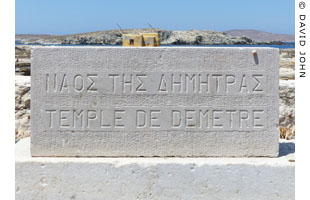
Marble plaque at the "Temple of Demeter"
on Delos, in Greek and French. |
|
| |
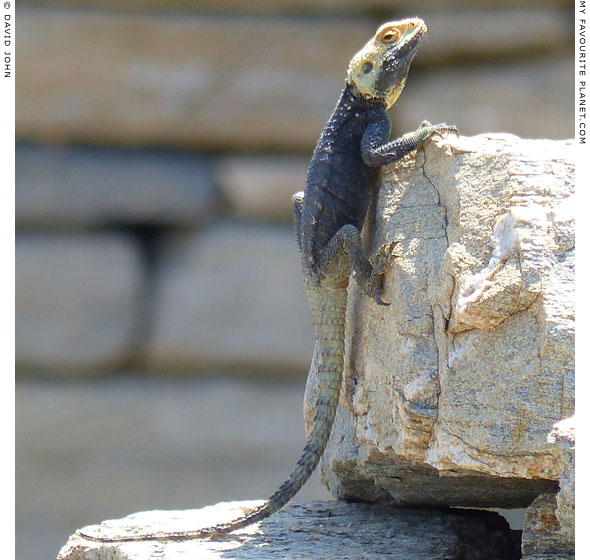
A starred agama lizard (Laudakia stellio) in Delos, Greece.
|
Although few traces of the Demeter cult have yet been found on Delos, reminders of the goddess are everywhere to be seen on this arid, rocky island in the form of this type of small lizard, also known as the stellion, star lizard, hardim, hardun and painted dragon. Thousands of them sit among the ruins and rocks, watching the tourists stumble by in the midday heat, or scurry around at high speed and disappear into dark cracks to avoid the visitors' enormous feet.
The Roman poet Ovid (Publius Ovidius Naso, 43 BC - 17/18 AD) tells us that during her long search for her missing daughter Proserpine (Persephone), Ceres (Demeter) travelled around Sicily, where, offended by the taunts of a snotty youth, she transformed him into a stellion:
"'Meanwhile the mother, fearing, searches in vain for the maid, through all the earth and sea. Neither the coming of dewy-haired Aurora, nor Hesperus, finds her resting. Lighting pine torches with both hands at Etna’s fires, she wanders, unquiet, through the bitter darkness, and when the kindly light has dimmed the stars, she still seeks her child, from the rising of the sun till the setting of the sun.
She found herself thirsty and weary from her efforts, and had not moistened her lips at any of the springs, when by chance she saw a hut with a roof of straw, and she knocked on its humble door. At that sound, an old woman emerged, and saw the goddess, and, when she asked for water, gave her something sweet made with malted barley.
While she drank what she had been given a rash, foul-mouthed boy stood watching, and taunted her, and called her greedy. The goddess was offended, and threw the liquid she had not yet drunk, mixed with the grains of barley, in his face. His skin, absorbing it, became spotted, and where he had once had arms, he now had legs. A tail was added to his altered limbs, and he shrank to a little shape, so that he has no great power to harm. He is like a lesser lizard, a newt, of tiny size. The old woman wondered and wept, and, trying to touch the creature, it ran from her and searched out a place to hide. It has a name fitting for its offence, stellio, its body starred with various spots.'"
Ovid, Metamorphoses, Book V, lines 425-486, "Calliope sings: Ceres searches for Proserpine". Prose translation by Anthony S. Kline. At The Ovid Collection, University of Virginia Electronic Text Center.
See more photos and information about starred agama lizards in
Ionian Spring Part 3 - Tooth and claw at The Cheshire Cat Blog. |
|
| |
| |
Sanctuaries of Demeter and Persephone
Pergamon |
 |
|
| |
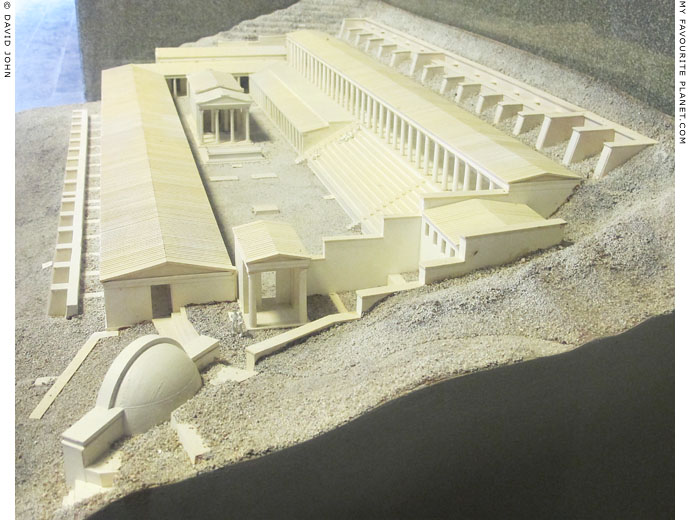
Model of the sanctuary of Demeter, on the Demeter terrace
on the south slope of the Pergamon acropolis.
Reconstruction by Dr. C. H. Bohtz, 1977.
Bergama Archaeological Museum.
|
The remains of the sanctuary of Demeter in Pergamon stand on the south slope of the acropolis, to the east of the theatre and west of the Upper Gymnasium and the sanctuary of Hera.
Little is known about life and religion at Pergamon during the two centuries of Persian rule, before Alexander the Great conquered northwestern Anatolia in 334 BC. Since it was hardly mentioned by writers during this period, it seems to have been an unimportant place controlled by a local Persian-appointed governor who presumably lived in a fortified area on the acropolis.
After the death in 281 BC of King Lysimachus, one of Alexander's successors, his treasurer (gazophylax) Philetaerus effectively became the ruler of Pergamon and the founder of the Attalid dynasty which was to rule until 133 BC (see History of Pergamon). He continued the work begun by his former master to transform Pergamon into a Greek city which was to become one of the most powerful and splendid in the Hellenistic world. Using the great wealth of Lysimachus' war booty, Philetaerus built a palace, new defensive walls, the Temple of Athena Nikephoros, the city's patron goddess, and the temple of Demeter.
Following tradition, the sanctuary of Demeter was built outside the city walls, below the citadel, around an almost level area on the steep south slope of the acropolis. At the time this area was relatively isolated, but later the city expanded down the hill and the sanctuary became surrounded by other buildings. An earlier sanctuary is thought to have existed on the site previously, but later building has destroyed traces of any possible structures, and it is not known which deity may have been worshipped there.
As became the usual construction method on the Pergamon acropolis, a large artificial stone platform, now referred to as the Demeter Terrace, 57 metres long and 21 metres wide, formed a level basis for the temenos (sanctuary) and its buildings (see elevation drawing below). The same principle was employed for the sanctuary of Athena Nikephoros, and in the second century AD in a grander and more sophisticated way for the terrace of the Temple of Trajan.
Construction of the terrace appears to have begun before Philetaerus gained control, but it was during his rule that it was enlarged, its orientation altered by two degrees and its supporting walls strengthened. As well as the temple, he added an altar, a 43 metre long stepped seating area with nine or ten rows of seats built into the hillside along the north side of the terrace, immediately to the west of which was the 41.5 metre long Doric or Aeolic stoa, known as the Lower North Stoa.
The altar (Altar A) from the front of the temple has survived and bears an inscription dedicated by Philetaerus and his brother Eumenes to Demeter, in memory of their mother Boa: "Philetaerus and Eumenes, to Demeter, for their mother Boa." It is thought that the inscription on the temple's andesite architrave, of which only fragments have been found, was identical.
The temple itself stood in the middle of the open sanctuary courtyard, near the west end, oriented like the terrace on an east-west axis, with the entrance (as was usual) at the east end. In style it was Ionic, distyle-in-antis, that is with the side walls continuing along the entire length of the building and forming the antis supporting the sides of the front porch (pronaos) which was also supported at the front by two Ionic columns. At 14.1 x 7.95 metres, it was modest in size, usual for temples on the Pergamon acropolis, but quite small compared to those at other important Greek cities in Anatolia, particularly the enormous temples of Ephesus, Didyma, Priene and Sardis.
Like most early Attalid buildings in Pergamon, the Demeter sanctuary and temple were constructed mostly of local stone, primarily andesite. Pergamon did not have local marble quarries, and despite their wealth, for either financial or political reasons, Philetaerus and his successor Eumenes I used imported marble sparingly, for decorative elements and sculpture. The Pergamene kings later owned the nearby island of Proconnesos (today Marmara, Turkey) and its marble quarries, and made lavish use of the brilliant Proconnesian marble.
Over the following centuries several renovations and additions were made to the sanctuary, including an extended marble Corinthian porch added to the front of the temple during renovations in the Roman period. According to an inscription from the architrave, the renovation was carried out in the second half of the second century AD by the prytanis (πρύτανις, local administrative executive, similar to a mayor) Claudius Silianus Aesimus.
The model in the photo above shows the sanctuary as it would have appeared during the Roman period, by which time it had gained a number of extra features, reflecting the need to accommodate increasing numbers of cult intitiates:
A propylon (monumental gateway) at the entrance at the east side, below which was a cistern, perhaps used for ritual ablutions; the Upper North Stoa along the entire length of the sanctuary, above the seating area and Lower North Stoa; the equally long but much wider South Stoa; and a shorter West Stoa, behind the temple.
Outside the entrance to the sacred area was a forecourt on two levels connected by stairs, around which was an offering area with a 50 cm deep square bothros (sacrificial pit) and a fountain, which was replaced by a large nymphaion (a monumental fountain; the round construction in the bottom left of the photo above) in the 1st century BC, during the Roman period.
At the north of the forecourt, abutting the wall at the northwest corner of the temenos wall, was a building containing several rooms, identified by an inscription from the architrave of the propylon dedicated by Queen Apollonis (Ἀπoλλωνίς, wife of Attalus I, mother of Eumenes II and Attalus II) as oikoi (small shrines or cult spaces; from οἶκος, oikos, a house, a dwelling), although their functions are not known. The inscription also states that Apollonis built the oikoi and stoas as a gift-offering to Demeter and Kore.
The sanctuary was first excavated by the German archaeologist Wilhelm Dörpfeld 1908-1911 and has since been investigated a number of times. Surviving sculptures and architectural elements (see photos below) have helped archaeologists identify the various buildings of the sanctuary, and inscriptions provide proof that it was dedicated to Demeter. However, not much evidence has been found to reveal the nature of the cult practices or which festivals were celebrated, although there are indications that the Thesmophoria and other chthonic cult rituals may have taken place there.
Perhaps surprisingly, there is very little ancient literary evidence concerning the worship of Demeter and other deities in a city which was a dominant political, economic and cultural force in the eastern Mediterranean during the Hellenistic period. |
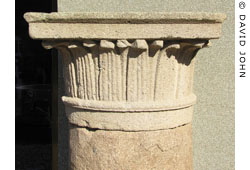
A Pergamene column capital
from the sanctuary of Demeter
in Pergamon. Hellenistic period.
Bergama Archaeological Museum. |
| |
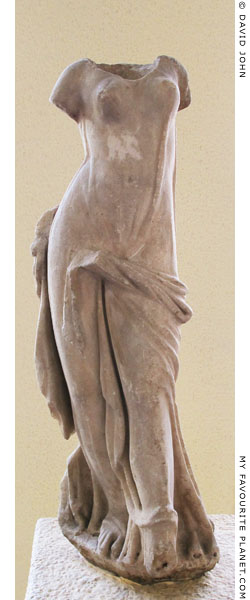
Marble statuette of a dancing
female from the Demeter Terrace,
Pergamon.
Late Hellenistic period,
150-30 BC. Height 65 cm.
Izmir Archaeological Museum.
Inv. No. 608.
Other sculptures found by
archaeologists at the Demeter
terrace, though not necessarily
related to Demeter, include:
Marble portrait head of Augustus
Pergamon gallery 2, page 6
Marble head of Emperor Tiberius
Pergamon gallery 2, page 7
Marble portrait head
of Agrippina the Elder
Pergamon gallery 2, page 8
Marble portrait head of a child
Pergamon gallery 2, page 9
Marble portrait head Hermes
Pergamon gallery 2, page 16 |
| |
| |
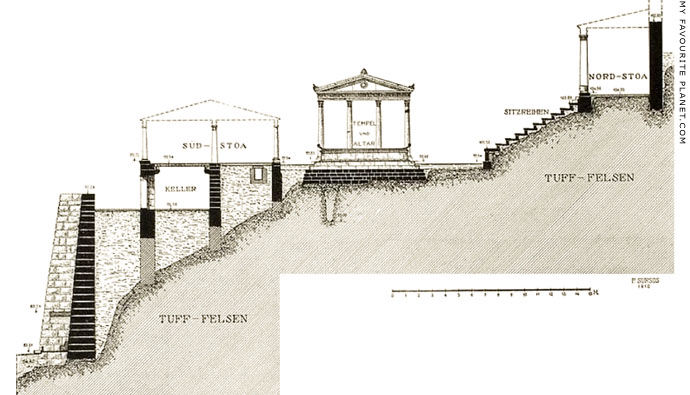
Elevation drawing of the Demeter Terrace on the Pergamon acropolis.
Drawn and signed by the architect Pan. Sursos, 1910.
Image source: Alexander Conze et al, Altertümer von Pergamon, Band I,
Text 2: Stadt und Landschaft, fig. 56, page 221. Georg Reimer, Berlin, 1913.
At University of Heidelberg Digital Library. |
| |
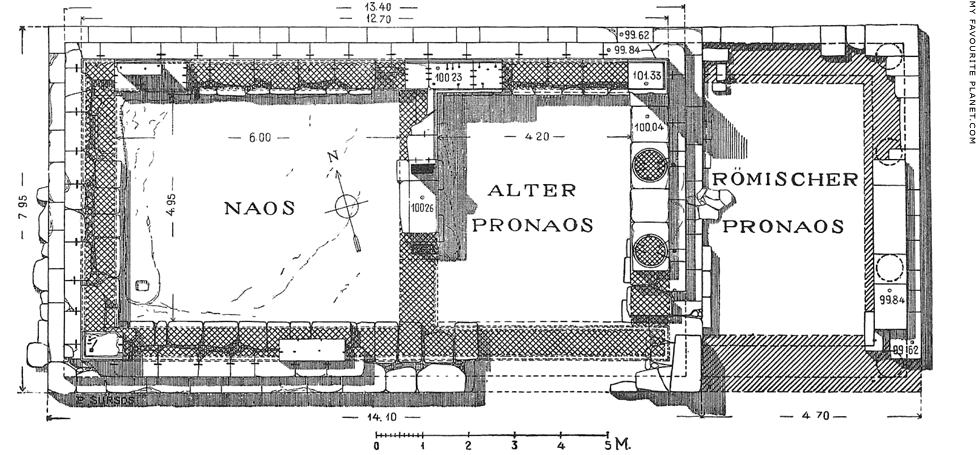
Plan of the remains of the temple of Demeter on the Pergamon acropolis.
Drawn and signed by the architect Pan. Sursos.
Wilhelm Dörpfeld, Die Arbeiten zu Pergamon 1908-1909, Abbildung 8, page 380.
In: Mitteilungen des kaiserlich Deutschen Archäologischen Instituts, Athenische Abteilung,
Band 35 (1910), pages 345-526. Eleutherudakis und Barth, Athens, 1910. |
| |
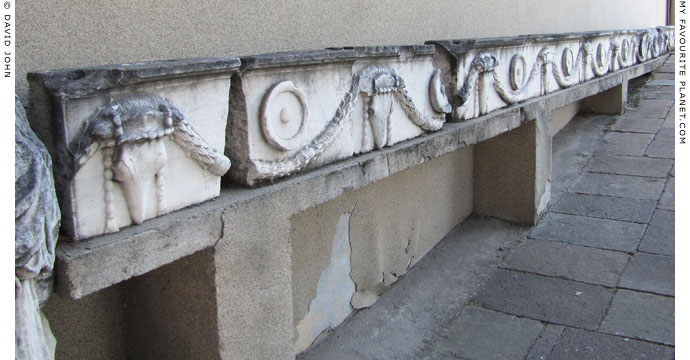
Reassembled fragments of the marble architrave from the temple of Demeter, Pergamon.
2nd third of the 3rd century BC. Height 37 cm.
Bergama Archaeological Museum. |
| |

Section of the marble architrave from the temple of Demeter, Pergamon.
2nd third of the 3rd century BC. Height 37 cm.
Bergama Archaeological Museum.
|
The nine fragments of the 9.43 metre long architrave found at the site of the temple are now exhibited in the garden of the Bergama Archaeological Museum. The low relief consists of a row of boukrania (ox skulls) joined by garlands of laurel leaves. Each boukranion has a knotted fillet across the forehead, looped around the horns, with the ends hanging on either side of head. Between each boukranion is a phiale (libation bowl) with a central boss. The carving of the boukrania and other details vary in style and are thought to have been made by a number of sculptors.
The reassembled fragments have been set up on the outer wall of the museum, along the sloped ramp up to the entrance. The outer railing of the ramp makes viewing and photographing the entire architrave from the front impossible. Like many of the objects displayed in the garden, the architrave is not labelled. |
|
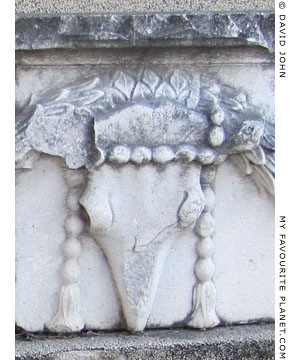
A boukranion on the architrave from
the temple of Demeter, Pergamon. |
|
| |
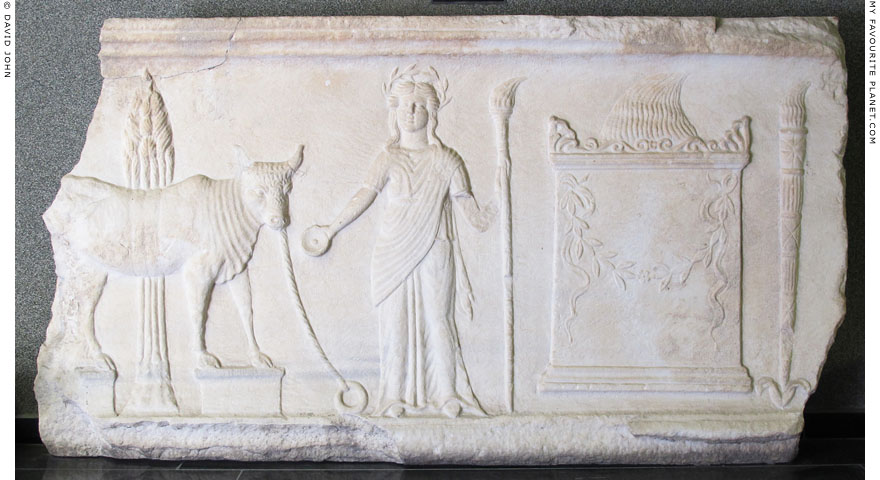
"Demeter relief" from the Demeter Terrace of the Pergamon acropolis.
Roman period. Height 89 cm, width 172.5 cm, depth 19 cm.
Bergama Archaeological Museum. Inv. No. 276.
|
| Found during excavations by Wilhelm Dörpfeld and Hugo Hepding in 1908-1909. In the centre stands a female figure, depicting either Demeter, Persephone or a priestess, wearing a wreath and holding a long torch and a phiale (libation bowl). On the left, a sacrificial bull, standing on two blocks, is tethered by the nose to a ring fixed in the ground. The tree-like object behind it was thought by Hepding to be a cypress. On the right, a large, flaming altar, decorated with akroteria and a garland, next to another long torch standing on a plant-form. [29] |
|
| |
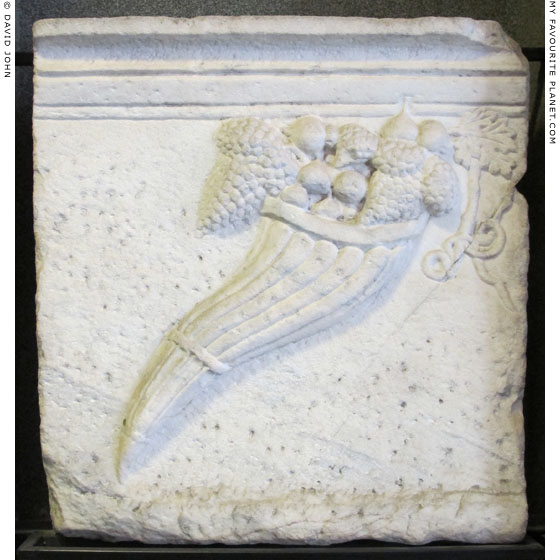
Relief of a cornucopia on a marble slabe of a marble
parapet from the Demeter Terrace, Pergamon.
Roman period.
Bergama Archaeological Museum. |
|
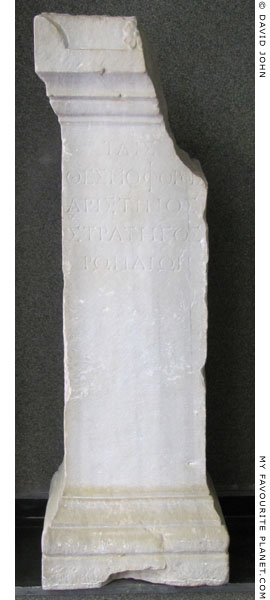
A marble base with a votive inscription
from the sanctuary of Demeter, Pergamon.
ΤΑΙΣ
ΘΕΣΦΜΟΦΟΡΟΙΣ
ΑΡΙΣΤΙΝΟΣ
ΣΤΡΑΤΗΓΟΣ
ΡΩΜΑΙΩΝ
Roman period.
Bergama Archaeological Museum. |
|
| |
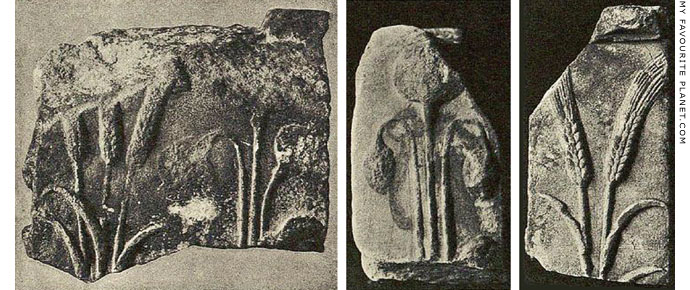
Fragments of marble reliefs of wheat and poppies, found in 1903 on the terrace of the
Middle Gymnasium of Pergamon, probably fallen from the sanctuary of Demeter above.
Source: Franz Winter, Altertümer von Pergamon, Band VII, Text 2: Die skulpturen
mit ausnahme der Altarreliefs, No. 408, pages 325-326. Georg Reimer, Berlin, 1908. |
| |
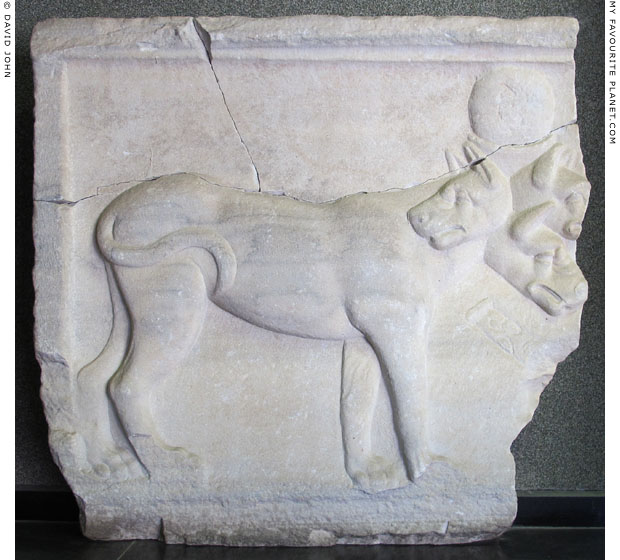
Fragment of a marble parapet with a relief of Cerberus (Κέρβερος,
Kerberos), the monstrous multi-headed guard dog of Hades,
that prevented the dead from leaving the Underworld.
Roman period. Excavated in 1909 at the Roman
South Stoa of the Demeter Terrace, Pergamon.
Bergama Archaeological Museum. Inv. No. 1909, 162. |
| |
| |
Demeter / Ceres in Rome |
 |
|
| |
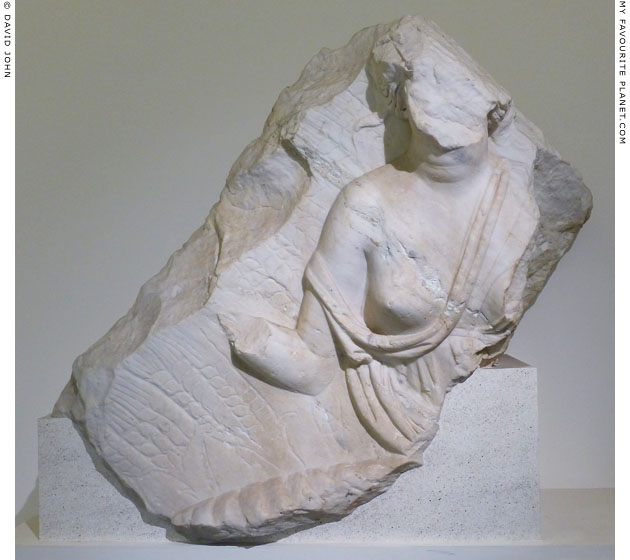
Fragment of a marble pediment with part of a relief of Ceres.
Late 1st century AD. Probably from the temple of the gens Flavia which stood
in the area in which the Baths of Diocletian were later built. Found on the
Via XX Settembre, in the area of the Ministry of Economy and Finance, Rome.
The goddess wears a chiton (tunic) that leaves her right shoulder and breast
exposed. She may have been depicted as enthroned or emerging from a leafy
setting. In the background are large sheaves of wheat in much shallower relief.
Baths of Diocletian, National Museum of Rome. Inv. No. 5122.
|
The cult of Ceres in Rome was probably introduced from Sicily. The temple of Ceres (Ceres, Liber and Libera) stood on the north slope of the Aventine Hill, near the west end of the Circus Maximus, outside the pomerium, the ancient walls which marked the sacred boundary of the city. It was built shortly after the overthrow of the monarchy and the establishment of the Republic around 509 BC, following a vow made to Demeter, Dionysus and Kore by the dictator Aulus Postumius Albus during a famine around 496 BC, and dedicated to Ceres, Liber and Libera by the consul Spurius Cassius Viscellinus around 493 BC.
It was one of the earliest temples dedicated to a Greek deity in the city, built in the Greek style and decorated with sculptures and paintings by the Greek artists Damophilus and Gorgasus (Pliny the Elder, Natural history, Book 35, chapter 45). According to Cicero the rites of the goddess were the same as those of the Greeks.
Lucius Mummius Achaicus later donated to the temple a painting of Father Liber (Dionysus) and Ariadne by Aristeides of Thebes, from the many artworks he looted from Corinth in 146 BC (see above) (Natural history, Book 35, chapter 8 and chapter 36).
The modern term Aventine Triad (also Plebeian Triad and Agricultural Triad) has been given to the joint cult of Ceres, Liber and Libera, who were identified with Demeter, Bacchus (Dionysus) and Proserpine (Persephone), with their Romanized mythologies, rites and mysteries. They were the tutelary deities of the Roman plebeians and became instruments of political proganda during the Roman Imperial period as a symbol of the empire's prosperity.
Vitruvius named the temple of Ceres as an example of araeostyle (from Ancient Greek αραιος, weak or widely spaced, and στυλος, column), low, broad buildings with widely spaced columns supporting timber architraves and pediments decorated with sculptures of terracotta or gilt bronze [30]. It was destroyed by fire around 31 BC, and was replaced by a new temple built by Augustus (reigned 27 BC - 14 AD) and dedicated circa 17 AD by his successor Emperor Tiberius (reigned 14-37 AD).
A number of Roman empresses, deified after their deaths, were associated with Ceres. See, for example, the heads of Livia Drusilla as Ceres Augusta (photos below). In the mid 2nd century AD the wealthy Athenian Herodes Atticus renamed his estate on the Via Appia, just outside Rome, the Triopion, a name associated with the sanctuary of Demeter in Knidos (see Part 2). Atticus' Triopion, dedicated to the gods of the underworld and the funeral cult of his wife Annia Regilla, included a temple dedicated to Demeter and Persephone and the "new Demeter", the deified Faustina Major (Annia Galeria Faustina, circa 100-140 AD), the wife of Emperor Antoninus Pius (see the photos and information on the Herodes Atticus page).
See also:
A coin of Empress Vibia Sabina showing Ceres in Part 2.
A statue of Fortuna-Isis restored as Faustina the Younger dressed as Ceres in Part 2. |
|
| |
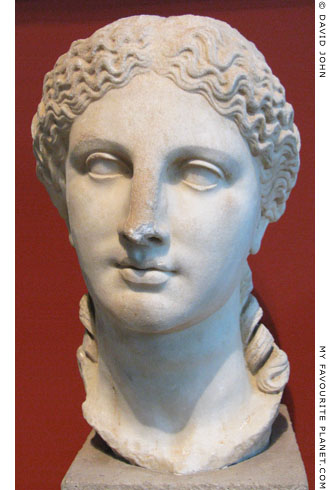
Marble head, late 2nd - early 1st century BC, probably originally depicting Demeter, later
(after 42 AD) altered to portray Livia Drusilla
(58 BC - 29 AD), wife of Emperor Augustus
and mother of Emperor Tiberius.
From Thessaloniki.
Thessaloniki Archaeological Museum. |
|
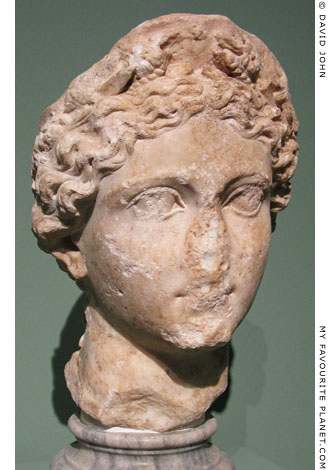
Larger than life-size marble head
of Empress Livia as Ceres.
30-50 AD. Height 50.5 cm.
After her death, Livia was deified, and is
here portrayed as Ceres Augusta, with
the hairstyle of the goddess, and a
corona spicea (a crown of ears of grain)
decorated with poppies and laurel.
Berlin State Museums (SMB). Inv. No. Sk 435.
Purchased by Gustav Friedrich Waagen
in 1841 from the Nani Collection, Venice. |
|
| |
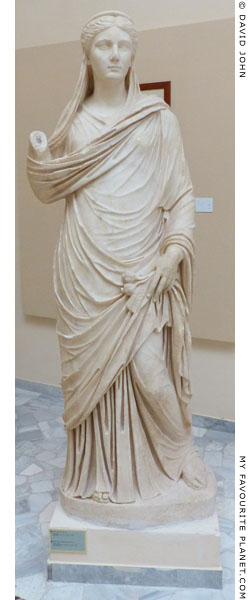 |
|
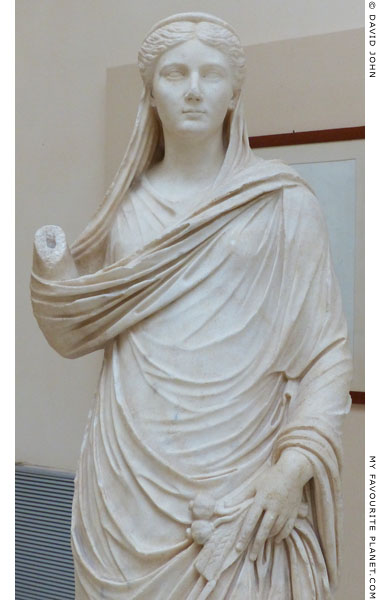 |
Marble statue of Vibia Sabina (83-136/137 AD), wife of Emperor Hadrian
(reigned 117-138 AD), as Ceres, holding poppies and ears of wheat in
her left hand. Sabina was posthumously deified as diva Sabina.
Around 136-140 AD. Parian marble. Found in 1909 in the palaestra of the
Baths of Neptune (Terme di Nettuno, II,IV,2), Ostia, near Rome. Height 186 cm.
Ostia Archaeological Museum. Inv. No. 25.
See also a coin of Vibia Sabina with a depiction of Ceres in Part 2. |
|
| |
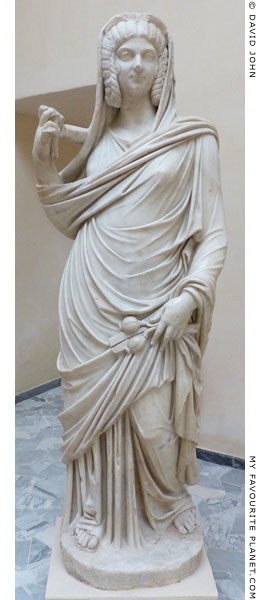 |
|
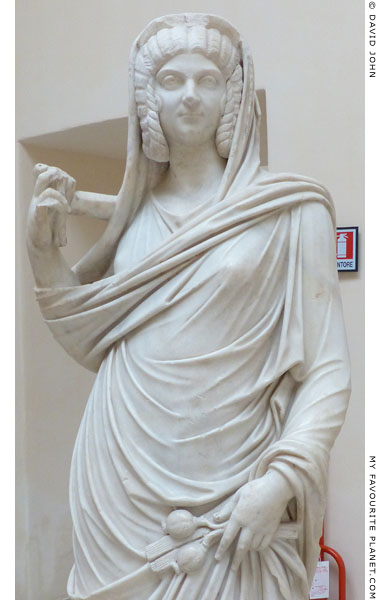 |
Marble statue of Julia Domna (170-217 AD), second wife of Emperor Septimius Severus
(reigned 193-211 AD), as Ceres, holding poppies and ears of wheat in her left hand.
3rd century AD. Proconnesian marble. Found in 1939 at the Portico of the Fountain with
the Oil Lamp (Portico della Fontana con Lucerna, IV,VII,1-2), Ostia. Height 195 cm.
Ostia Archaeological Museum. Inv. No. 21.
A coin with the head of Julia Domna, shows on the reverse side a statue
group of Demeter and Despoina in the temple of Despoina, Lykosoura,
Arcadia in the Peloponnese (see photos and article in part 2). |
|
| |
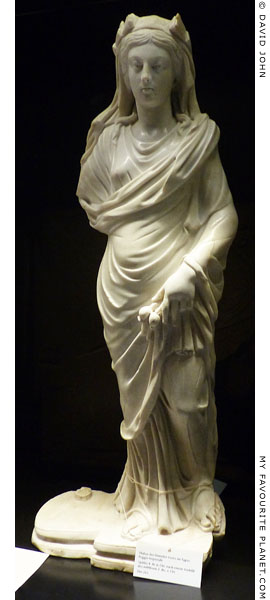 |
|
 |
Marble statuette of Demeter-Ceres of the Poggio Imperiale type.
Late 4th century AD, after a model of the mid 2nd
century BC. Fine-grained, translucent white marble.
Height 87 cm, width 38 cm, depth 22.0 cm.
Skulpturensammlung, Albertinum, Dresden. Inv. No. Hm 265. |
|
| |
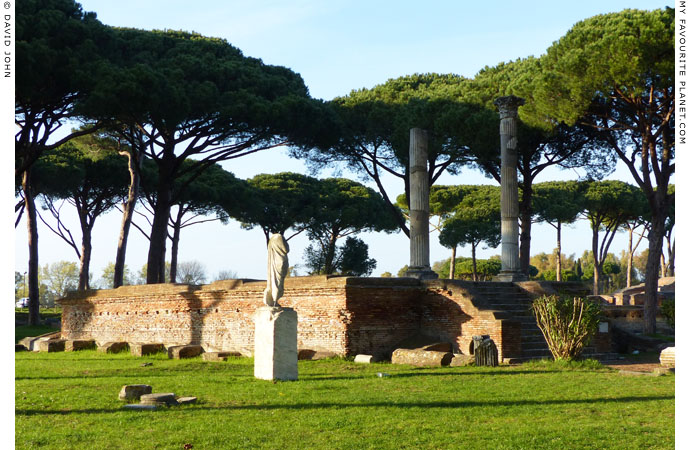
The "Temple of Ceres" in Ostia, Rome's ancient port.
|
Built during the reign of Emperor Domitian (81-96 AD), the temple stands in the centre of the Forum of Corporations (Piazzale delle Corporazioni, Regio II, Insula VII, Tempio II,VII,5), in front of Ostia's theatre (built by Marcus Agrippa around 18 BC). The forum comprised of a garden surrounded by stoas (colonnades), probably for the benefit of theatre-goers (as with the Stoa of Eumenes in Athens). Stairs at the front of the high brick podium led up to a portico, supported by four tall columns with composite capitals (a mix of Corinthian and Ionic), and a single cella.
The temple may have served as a guild temple, traditionally thought to have been dedicated to Ceres, as the guardian of imperial supplies. However, many scholars now believe that a number of deities may have been worshipped there; Annona, Ceres, Serapis and Vulcanus have been suggested. It has also been suggested that Domitian himself built the temple for the Imperial cult of deified emperors. No altar was found at the temple, and no inscriptions or other objects have been discovered which would identify the deities worshipped.
The lack of inscriptions from Domitian's reign may be due to the fact that his authoritarian rule made him very unpopular, and after his assassination the Roman senate officially declared damnatio memoriae (condemnation of memory) on him: his name was erased from public records, inscriptions, buildings and monuments; his coins were melted down and statues of him either destroyed or resculpted to represent the new emperor Nerva. |
|
| |
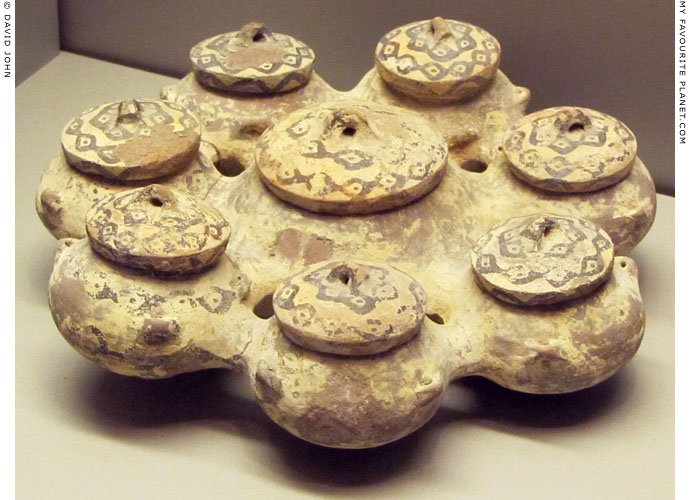
An Early Cycladic ceramic kernos consisting of eight small, lidded pyxides (containers),
with painted linear decoration. A unique, complex vessel, probably made for ritual use.
Early Cycladic II period, Keros-Syros culture, around 2800-2300 BC.
Found among grave offerings at Chalandri, on the Cycladic island Syros.
National Archaeological Museum, Athens. Inv. No. P6185.
See also a ceramic vase in the form of a hedgehog of the
same period from Syros in Potters / vase painters A - D. |
| |
Demeter and
Persephone
Part 1 |
Notes, references and links |
 |
|
1. Persephone, Kore, Despoina
The name Persephone in Ionic Greek, had variants such as Persephatta and Persephassa in other Greek dialects. It is thought that she may have been referred to by various epiphets for fear of mentioning her actual name. In modern Greek the word despoina (δέσποινα) is still used to address young and unmarried women, as in miss or madamoiselle. However, references to Despoina in ancient Greek are often translated as "Mistress".
2. Homeric Hymn to Demeter
Extracts from Hymn 2 to Demeter:
"I begin to sing of rich-haired Demeter, awful goddess — of her and her trim-ankled daughter [Persephone] whom Aidoneus [Hades] rapt away, given to him by all-seeing Zeus the loud-thunderer."
"Hecate, with a torch in her hands, met her, and spoke to her and told her news:
'Queenly Demeter, bringer of seasons and giver of good gifts...'"
Anonymous, The Homeric Hymns and Homerica. English translation by Hugh G. Evelyn-White. Loeb Classical Library edition. Harvard University Press, Cambridge, MA. and William Heinemann Ltd., London, 1914. At Perseus Digital Library.
3. Herodotus on the mystic rites of Demeter
Herodotus, Histories, Book 2, chapter 171.
The History of Herodotus, Volume I, Book II. English translation by G. C. Macaulay. MacMillan and Co., London and New York, 1890. At Project Gutenberg.
4. Pausanias' dream
Pausanias, Description of Greece, Book 1, chapter 38, section 7. At Perseus Digital Library.
He had mentioned this dream earlier in the same book:
"After I had intended to go further into this story, and to describe the contents of the sanctuary at Athens, called the Eleusinium, I was stayed by a vision in a dream. I shall therefore turn to those things it is lawful to write of to all men."
Pausanias, Description of Greece, Book 1, chapter 14, section 3. At Perseus Digital Library. |
|
|
|
5. Sanctuaries of Demeter and Persephone
Sanctuaries of Demeter and Persephone are known to have existed all over the Greek and Roman world, including North Africa, Scythia and Asia, from mentions by ancient authors and archaeological evidence, such as the remains of cult buildings, inscriptions and other artefacts associated with their cult. It appears that most, if not all, Greek cities worshipped them in some form, and, appropriate to agricultural deities, there were a number of sanctuaries at small settlements or in the countryside, some way from cities.
"The temple of Ceres should be in a solitary spot out of the city, to which the public are not necessarily led but for the purpose of sacrificing to her. This spot is to be reverenced with religious awe and solemnity of demeanour, by those whose affairs lead them to visit it."
Vitruvius, On Architecture (de Architectura), Book 1, chapter 7, section 2. At Bill Thayer's LacusCurtius website, University of Chicago.
Some cult centres became important because of a particular association with aspects of the myths concerning Demeter and Persephone. Lerna in the Peloponnese and Syracuse and Enna in Sicily, for example, were among the places which claimed to be the location of Persephone's abduction by Plouton. Other places particularly honoured the goddesses for help given during a famine, war or other crisis. Pausanias mentioned a sanctuary of Demeter near Sikyon in the Peloponnese, said to have been founded by the mythical king Plemnaeis (Πλημναῖος) in thanks to the goddess who, in the guise of a strange woman, reared his son Orthopolis after all his previous children had died at birth (Description of Greece, Book 2, chapter 5, section 8 and chapter 11, section 2). Some cult centres could boast grand sanctuaries due to financial contributions by the community or state, or patrons such as kings, emperors and wealthy individuals.
Locations of known important sanctuaries include:
|
|
|
Central Greece
Athens (Ἀθῆναι), Attica
Eleusis (Ἐλευσίς), Attica
Megara (Μέγαρα), Attica
Munychia (Μουνυχία), Piraeus, Attica
Potniae (Πότνιαι), Boeotia
Pyrasos (Πύρασος), Thessaly
Thoricus (Θορικός), Attica
Southern Greece (Peloponnese)
Aegila (Αἴγλλα), Laconia
Argos (Ἄργος), Argolid
Bathos (Βάθος), Arcadia
Celeae (Κελεαί), Phliasia (Φλιασία)
Corinth (Κόρινθος)
Hermione (Ἑρμιόνη), Argolid
Isthmia (Ισθμία), Corinthia
Lerna (Λερνα), Argolid
Lykosoura (Λυκόσουρα), Arcadia
Megalopolis (Μεγαλόπολις), Arcadia
Messene (Μεσσήνη), Messenia
Olympia (Ολυμπία), Elis
Patras (Πάτραι)
Pheneos (Φενεός, Feneos), Arcadia
Phigalia (Φιγάλια), Arcadia
Sicyon (Σικυών), Sicyonia
Sparta (Σπάρτα)
Tegea (Τεγέα), Arcadia
Macedonia and Thrace
Abdera (Άβδηρα)
Amphipolis (Ἀμφίπολις)
Dion (Δίον)
Galepsos (Γαληψός)
Lete (Λητή)
Mesembria (Μεσημβρία)
Pella (Πέλλα)
Aegean islands
Delos (Δήλος)
Naxos (Νάξος)
Paros (Πάρος)
Samothraki (Σαμοθράκη)
Syros (Σῦρος)
Thasos (Θάσος)
Crete
According to tradition, the cult of Demeter originated in Crete, and a number of sanctuaries have been identified on the island, including at Knossos (Κνωσός), and the remains of a small Roman period temple at Aptera (Ἄπτερα). |
|
East Greece
(Anatolia = Asia Minor, and eastern Aegean islands)
Ephesus (Ἔφεσος), Ionia
Halikarnassos (Ἁλικαρνᾱσσός), Caria
Iasos (Ἴασος), Caria
Knidos (Κνίδος), Caria
Kos (Κως), Dodecanese
Kyzikos (Κύζικος), Mysia
Miletus (Μίλητος), Ionia
Mytilene (Μυτιλήνη; Lesbos)
Pergamon (Πέργαμον), Aeolia
Priene (Πριήνη), Ionia
Rhodes (Ρόδος)
Sanctuaries also at Aigeai, Chios, Clazomenae,
Erythrae, Phocaea, Sardis, Smyrna and the Troad
Cyprus
Kourion (Κούριον)
Northern Italy (Etruscan and Roman)
Ariccia, Latium
Gravisca (Etruscan), Latium
Ostia
Rome
Southern Italy (Magna Graecia)
Metapontion (Μεταπόντιον)
Neapolis (Νεάπολις), Capania (Naples)
Paestum (Παῖστον; earlier Poseidonia, Ποσειδωνία)
Sicily
Akragas (Ἀκράγας)
Catana (Κατάνη)
Enna (Ἔννα)
Francavilla di Sicilia (ancient name unknown)
Gela (Γέλα)
Megara Hyblaia (Μέγαρα Ὑβλαία)
Selinous (Σελινοῦς)
Syracuse (Συράκουσαι)
North Africa
Alexandria (Ἀλεξάνδρεια), Egypt
Carthage
Cyrene (Κυρήνη), Lybia
Black Sea
Apollonia Pontica (Ἀπολλωνία Ποντική; Sozopol, Bulgaria) |
|
|
6. Literature on Eleusis and the Eleusinian Mysteries
Several books and academic articles have been published on Eleusis, the Eleusinian Mysteries and the artefacts connected with them. One of the best and most readable is still Eleusis and the Eleusinian Mysteries by the Greek archaeologist George Emmanuel Mylonas (Γεώργιος Εμμανουήλ Μυλωνάς, 1898-1988).
First published by Princeton University Press in 1961, Mylonas' substantial, illustrated volume provides an excellent introduction to the history, topography, architecture and archaeology of Eleusis, descriptions of the artefacts discovered at the site, as well as those to be seen at the Eleusis Museum and elsewhere. It also includes discussion of the mythology and worship of Demeter, Persephone and related deities, various aspects of the Mysteries and the phases of the festivals.
Much has changed in the worlds of history, archaeology - and indeed politics - since this book was written; more discoveries have been made, and new viewpoints, ideas and theories have developed. Some of the opinions stated by Mylonas (his own and those of others) have been questioned and superseded. There are also what now seem like notable omissions, such as the question of the use of psychotropic drugs during religious festivals. Still, the scholarship providing the core of the work remains sound and dependable. At over 400 pages it will not provide the kind of general guide required by tourists or casual visitors, but is essential reading for anyone seeking a deeper understanding.
The book was out of print for many years, and several attempts by members of the Archaeological Society of Athens and interested residents of Elefsina (the modern name for Eleusis) to republish the work as well as a Greek translation proved unsuccessful. Finally, in 2010 the small local publishers in Elefsina, Cyceon Tales Publications, brought out editions in Greek and English.
English edition: George E. Mylonas, Eleusis and the Eleusinian Mysteries. Cyceon Tales Publications, Harilaou 94, 192 00 Elefsina, Greece, 2010. Paperback, 492 pages, with 88 illustrations, including maps and plans.
Greek edition: Γεώργιος Εμμανουήλ Μυλωνάς, Ελευσίς και ελευσίνια μυστήρια. Κυκεών Tales, Χαριλάου 94, 192 00 Ελευσίνα, 2010. 492 σελ.
The English edition costs 19 Euros, the Greek edition 23 Euros.
Available at the excellent Bar-Café Cyceon Tales, opposite the entrance to the Eleusis Archaeological Site at Eleusis, every day 08:15 - 02:00.
The books can also be ordered from the Cyceon Tales website www.cyceon.gr (in English and Greek):
English edition
Greek edition
Princeton University Press have now reissued the original edition of the book as part of their Princeton Legacy Library series:
George E. Mylonas, Eleusis and the Eleusinian Mysteries, Princeton University Press, 2015. 416 pages.
While Princeton is to be applauded for finally republishing this valuable book, their edition costs 54 Dollars, more than double the price of the Cyceon Tales edition. We recommend you buy from Cyceon Tales, and thereby support the local economy and the work of local people to foster the culture of Eleusis - ancient and modern.
A shorter, more recent illustrated guide to the site and monuments of Eleusis:
Kalliope Preka-Alexandri, Eleusis. Archaeological Receipts Fund (TAP), Ministry of Culture, Athens. First edition 1991, third edition 2003.
Separate editions in Greek, English and German, available at many museum shops in Greece (but not at Eleusis itself!). Well illustrated with photos, drawings, plans and a map of Attica. A bargain at 5 euros.
English edition, translated by William W. Phelps. 48 pages. ISBN 960-214-102-6.
Publisher's website: www.tap.gr (Greek and English) |
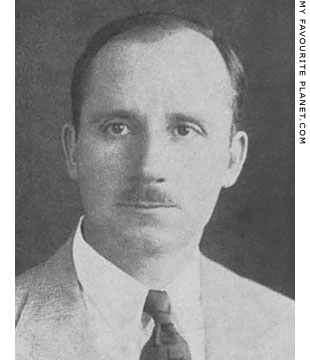
Greek archaeologist George Mylonas. |
| |
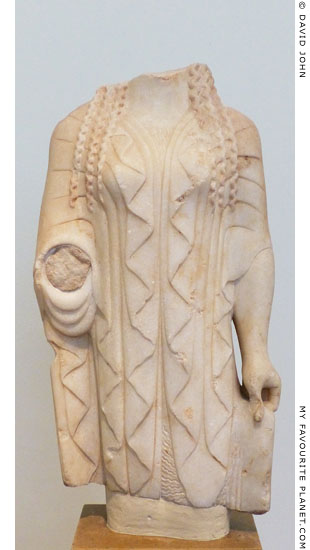
Part of a marble statuette of a kore found
in Eleusis. The figure wears a peplos and
a mantle, and probably held a fruit or
flower in her extended right hand.
Late 6th - early 5th century BC.
Island marble.
National Archaeological Museum,
Athens. Inv. No. 26. |
| |
|
7. Caryatid from Eleusis in Cambridge
Photo and further details at:
data.fitzmuseum.cam.ac.uk/id/object/65755
The sculpture was seen at Eleusis by des Mouceaux in 1668 and by Jacob Spon and George Wheler on 5th February 1676 (see drawing, right). Spon, Wheler, Clarke and other early northern European travellers to Greece (Pococke, Montfaucon) were convinced that the sculpture was the upper part of a colossal statue of Ceres (Demeter).
Edward Daniel Clarke (1769-1822) obtained a firman from the Waiwode (Turkish governor, see Athens Acropolis gallery page 1) of Athens to remove the sculpture, much to the indignation of many of the local people, for whom it remained sacred. Clarke himself remarked on the local tradition, quoting Doctor Richard Chandler, who believed the statue represented Proserpine (Persephone):
"A tradition prevails, that if the broken Statue be removed, the fertility of the land will cease. Achmet Aga [the Turkish military commander] was fully possessed with this superstition, and declined permitting us to dig or measure there, until I had overcome his scruples by a present of a handsome snuff-box, containing several zechins or pieces of gold."
Richard Chandler (1738-1810), Travels in Greece, or an account of a tour made at the expense of the Society of Dilettanti, page 191. Clarendon Press, Oxford, 1776. At the Internet Archive.
Clarke also reported:
"... as often as foreigners came to remove the Statue, some disaster ensued. They believed that the arm of any person who offered to touch it with violence, would drop drop off; and said, that once being taken from her station by the French, she returned back in the night to her former situation."
"But the superstition of the inhabitants of Eleusis, respecting an idol which they all regarded as the protectress of their fields, was not the least obstacle to be overcome. (They maintained that no ship would ever get safe into port with the Statue on board; and the prediction was amply verified in the wreck of the Princessa.)
On the evening preceding the removal of the Statue, an accident happened, which had nearly put an end to the undertaking. While the inhabitants were conversing with the Turkish officer who brought the Firman from the Waiwode of Athens, an ox, loosed from its yoke, came and placed itself before the Statue, and, after butting with its horns for some time against the marble, ran off with considerable speed, bellowing, into the plain of Eleusis. Instantly a general murmur prevailed; and several women joining in the clamour, it was with difficulty any proposal could be made. 'They had been always,' they said, 'famous for their corn; and the fertility of the land would cease when the Statue was removed.' These are exactly the words of Cicero with respect to the Sicilians, when Verres removed the Statue of Ceres [statues of Demeter and Triptolemus from the Temple at Enna]: 'Quod, Cerere violata, omnes cultus fructusque Cereris in his locis interiisse arbitrantur.' (Cicero in Verr. lib. iv. c. 5 I.)
At length, however, these scruples were removed; and on the following morning, November 22nd 1801, the Priest of Eleusis, arrayed in his vestments as for high mass, descended into the hollow in which the Statue was partially buried, to strike the first blow with a pickaxe for the removal of the rubbish, that the people might be convinced no calamity would befall the labourers."
On 23 November 1801 the statue was put on a Casiot ship at the port of Eleusis and taken to Smyrna (Izmir), "where the Statue was again moved into the Princessa merchantman, Captain Lee. In her passage home, this vessel was wrecked and lost near Beachy Head; but the Statue was recovered, and finally reached its destination."
"Herein was completely verified the augury of the Eleusinians; who were so convinced of the disaster which was to befall the vessel, that the news of the wreck has served to confirm them in their superstitions concerning the Statue. It may be amusing to add, that subsequent travellers, having visited the spot since the Statue was removed, have been much entertained with the stories they relate. The first year after the departure of the Goddess, their corn proved very abundant, and they were in constant expectation that Ceres would return. The next year, however, was not so favourable; and they begin to fear she has deserted them. 'It would have been impossible,' they say, 'without witchcraft, to have carried her off.'"
Edward Daniel Clarke, Greek marbles brought from the shores of the Euxine, Archipelago, and Mediterranean and deposited in the vestibule of the public library of the University of Cambridge, pages 13-37. Cambridge University Press, 1809. At the Internet Archive. The drawing, right, is on page 31. |
| |
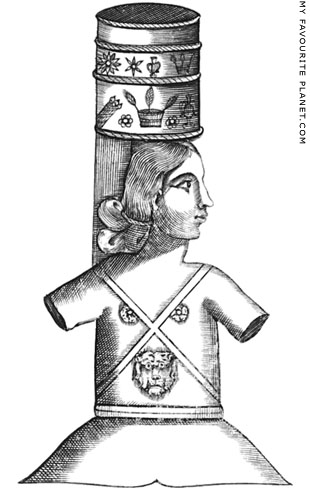
Engraving of a drawing by George Wheler
of the caryatid he and Jacob Spon saw in
Eleusis, believing it to be a fragment of a
statue of Ceres (Demeter).
Source: George Wheler, A journey into
Greece in company of Dr Spon of Lyons,
Book VI, page 428. London, 1682.
At Googlebooks. |
| |
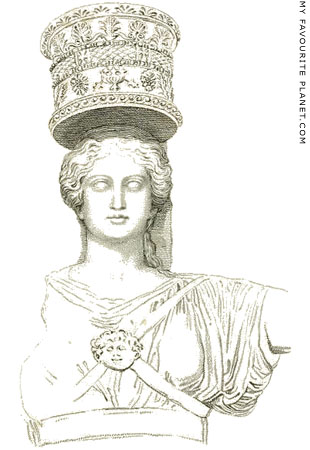
Drawing by John Flaxman (1755-1826)
of the caryatid from Eleusis now in the
Fitzwilliam Museum, Cambridge, with
the face restored.
Engraved by Peltro William Tomkins.
Source: Edward Daniel Clarke, Greek
marbles brought from the shores
of the Euxine..., see citation, left. |
| |
|
8. The discovery of the Great Eleusinian Relief and the Agios Zacharias church
According to one account, the Great Eleusinian Relief was discovered by the archaeologist Demetrios Philios (Δημήτριος Φίλιος, 1844-1907) who was to direct excavations at Eleusis 1882-1907.
The small, post Byzantine church of Agios Zacharias was built on the east side of the middle aisle of a 5th century Christian basilica (named by archaeologists after the later church), remains of which can still be seen. The church was used as a provisional storeroom and museum for finds from the archaeological site.
9. Pinakes
In the ancient Greek world, a pinax (πίναξ, literally board; plural πίνακες, pinakes) was a plaque (or tablet) of painted wood, moulded and/or painted ceramic, inscribed marble or cast bronze, placed as a votive offering in a temple, sanctuary or tomb. Some pinakes were inscribed wax tablets or painted cloth. The subject of the pinakes was usually one or more deities, standing or enthroned (sometimes represented only by their symbols), often shown being approached by worshippers carrying sacrifices. The term eventually came to denote a painting, and a pinakotheke a picture gallery (as in the "Pinakotheke" of the Propylaia of the Athens Acropolis).
See also:
A 7th century BC Penteskouphia Pinax from Corinth
A 1st century AD "Campana plaque" depicting Female dancers around Palladion
10. Decree concerning Eleusinian first fruits
The inscription, written in stoichedon, records a decree of the Athenian assembly (demos), unusually based on a draft prepared by a committee, concerning the collection of portions of the harvest of wheat and barley (ἀπαρχαί, aparchai, first-fruits) to be dedicated to the two goddesses Demeter and Kore (Persephone). It also includes the stipulation that two copies of the decree are to be inscribed, one to be set up at the sanctuary in Eleusis and the other on the Athens Acropolis. Only a fragment of the latter stele has survived (inscription IG I³ 78b).
For the Greek text of the Eleusis inscription (also referred to as IG I³ 78a and I Eleusis 28a), see:
epigraphy.packhum.org/text/79 at The Packard Humanities Institute.
For an English translation and further information, see:
www.atticinscriptions.com/inscription/IGI3/78a at Attic Inscriptions Online (AIO). |
|
|
|
11. The City Eleusinion of Athens
See: Margaret M. Miles, The City Eleusinion, The Athenian Agora, Volume 31. The American School of Classical Studies at Athens, 1998.
Pausanias made two mentions of a temple of Demeter and Persephone at beginning of his description of Athens, the first when describing the entrance to the city at Kerameikos, before the Agora:
"On entering the city there is a building for the preparation of the processions, which are held in some cases every year, in others at longer intervals. Hard by is a temple of Demeter, with images of the goddess herself and of her daughter, and of Iacchus holding a torch. On the wall, in Attic characters, is written that they are works of Praxiteles."
Pausanias, Description of Greece, Book 1, chapter 2, section 4. At Perseus Digital Library.
He again mentions a temple of Demeter and Persephone and a temple of Triptolemus near the Enneakrounos Fountain (thought to be the "Southeast Fountain House" discovered by archaeologists) in the Agora:
"Hard by is a spring called Enneacrunos (Nine Jets), embellished as you see it by Peisistratus. There are cisterns all over the city, but this is the only fountain. Above the spring are two temples, one to Demeter and the Maid, while in that of Triptolemus is a statue of him. The accounts given of Triptolemus I shall write, omitting from the story as much as relates to Deiope.
The Greeks who dispute most the Athenian claim to antiquity and the gifts they say they have received from the gods are the Argives, just as among those who are not Greeks the Egyptians compete with the Phrygians. It is said, then, that when Demeter came to Argos she was received by Pelasgus into his home, and that Chrysanthis, knowing about the rape of the Maid, related the story to her. Afterwards Trochilus, the priest of the mysteries, fled, they say, from Argos because of the enmity of Agenor, came to Attica and married a woman of Eleusis, by whom he had two children, Eubuleus and Triptolemus. That is the account given by the Argives. But the Athenians and those who with them ... know that Triptolemus, son of Celeus, was the first to sow seed for cultivation.
Some extant verses of Musaeus, if indeed they are to be included among his works, say that Triptolemus was the son of Oceanus [Okeanos] and Earth [Gaia]; while those ascribed to Orpheus (though in my opinion the received authorship is again incorrect) say that Eubuleus and Triptolemus were sons of Dysaules, and that because they gave Demeter information about her daughter the sowing of seed was her reward to them. But Choerilus, an Athenian, who wrote a play called Alope, says that Cercyon and Triptolemus were brothers, that their mother was the daughter of Amphictyon, while the father of Triptolemus was Rarus, of Cercyon, Poseidon. After I had intended to go further into this story, and to describe the contents of the sanctuary at Athens, called the Eleusinium, I was stayed by a vision in a dream. I shall therefore turn to those things it is lawful to write of to all men.
In front of this temple, where is also the statue of Triptolemus, is a bronze bull being led as it were to sacrifice, and there is a sitting figure of Epimenides of Cnossus ..."
Pausanias, Description of Greece, Book 1, chapter 14, sections 1-4. At Perseus Digital Library.
Pausanias later relates the Cretan myth in which Eubouleus was the son of Karmanor and the father of Karme, who was the mother of Britomartis (Aphaea) by Zeus.
"In Aegina, as you go towards the mountain of Zeus, God of all the Greeks, you reach a sanctuary of Aphaea, in whose honor Pindar composed an ode for the Aeginetans. The Cretans say (the story of Aphaea is Cretan) that Carmanor, who purified Apollo alter he had killed Pytho, was the father of Eubulus, and that the daughter of Zeus and of Carme, the daughter of Eubulus, was Britomartis."
Pausanias, Description of Greece, Book 2, chapter 30, section 3. At Perseus Digital Library.
This myth was also mentioned by the Greek historian Diodorus Siculus (Διόδωρος Σικελιώτης, Diodoros Sikeliotes) around 60-30 BC:
"Britomartis, who is also called Dictynna, the myths relate, was born at Caeno in Crete of Zeus and Carme, the daughter of Eubulus who was the son of Demeter."
Diodorus Siculus, Library of History, Book 5, chapter 76, section 3. At Bill Thayer's website LacusCurtius: Into the Roman World, University of Chicago.
12. The sanctuary of Demeter Azesia, Athens
Inscribed boundary stone of the sanctuary of Demeter Azesia. Agora Museum, Athens. Inv. No. I 513.
See: Benjamin D. Meritt, Inscriptions from the Athenian Agora, fig. 25. Excavations of the Athenian Agora, Picture Book No. 10. American School of Classical Studies at Athens (ASCSA), Princeton, New Jersey, 1966.
Hesperia, Volume 4 (1935), pages 52-53.
13. Praxiteles's signature on the Agora statue base
See:
T. Leslie Shear, The campaign of 1936. In: Hesperia, Volume 6, No. 3 (May 1937), The American Excavations in the Athenian Agora: Twelfth Report, pages 333-381. PDF at ascsa.edu.gr, website of The American School of Classical Studies at Athens.
Antonio Corso, The art of Praxiteles: The development of Praxiteles' workshop and its cultural tradition until the sculptor's acme (364-1 BC), pages 229-231. L'Erma di Bretschneider, Rome, 2004.
Demosthenes, Oration No. 41 Against Spudias, at anastrophe.uchicago.edu.
Inscription SEG 17:83 at The Packard Humanities Institute. |
|
|
|
14. Ephedrismos
Ephedrismos (ἐφεδρισμός; from ἐφεδρίζω, I sit on) was apparently a popular game in ancient Greece in which players threw a ball or stone at a pointed stone used as a target (δίορος, dioros). The loser had to carry the winner on their back to the target with their eyes covered by the winner's hands. Athough this has been compared with leap frog and the modern Greek game of long donkey (μακριά γαϊδούρα, makria gaithouri), it was a very different type of game.
The game is the subject of several vase paintings from the Classical period and ceramic figurines of the Hellenistic period. The players depicted include girls, boys, Erotes (cupids), Satyrs and Silens (see photos below). Children often played with balls during religious festivals, and it is thought that figurines depicting ephedrismos may have had a religious significance.
The only ancient description of the game appears in the Onomasticon, a thesaurus written in the 2nd century AD by Julius Pollux (Ἰούλιος Πολυδεύκης, Ioulios Polydeukes), a Greek sophist, rhetorician and grammarian from Naukratis, Egypt, who was appointed professor of rhetoric at the Academy in Athens by Emperor Commodus. The thesaurus is not organized alphabetically, but arranged in ten books, each a separate treatise on a particular set of topics. The description of the game is in Book 9, Panhellenios (Πανελλήνιος), a speech delivered before the assembled Greeks, dealing with towns, buildings, coins, games and other subjects.
The text in Greek: Erich Bethe (editor), Pollucis Onomasticon: e codicibus ab ipso collatis denuo edidit et adnotavit Ericus Bethe, Volume 2, Book IX, line 119 (page 180). B. G. Teubner, Leipzig, 1931. At the Internet Archive.
15. Excavations at Isthmia
See: Virginia R. Anderson-Stojanović and David S. Reese, A Well in the Rachi Settlement at Isthmia. Hesperia, Volume 62, No. 3 (July - September 1993), pages 257-302. The American School of Classical Studies at Athens (ASCSA). At jstor.org.
There are several academic articles and reports concerning the archaeological excavations at Isthmia. For more information about the sites and recent discoveries, see:
lucian.uchicago.edu/blogs/isthmia/. Excavations at Isthmia by the University of Chicago.
Information about the Rachi settlement: lucian.uchicago.edu/blogs/isthmia/rachi-settlement/ |
| |
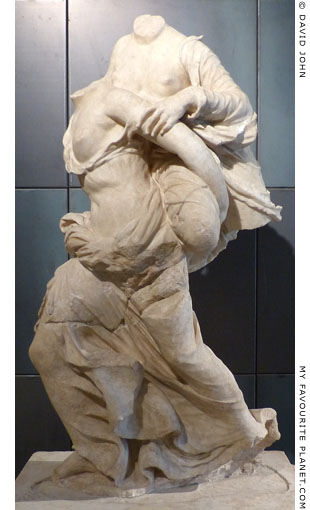
A marble statue group of two young
females playing ephedrismos.
4th century BC. A Greek work from Tegea
in Arcadia, Peloponnese, Greece. Probably
taken to Rome as war booty. Pentelic
marble. From the Horti Lamiani, Rome.
Found 15th April 1907 in the Piazza Dante.
Total height (excluding plinth) 120 cm.
Height of running figure 93 cm. Purchased
in 1921 from the Antiquario Comunale.
Palazzo dei Conservatori, Capitoline
Museums, Rome. Inv. No. MC 1151.
Fragments of a marble statue group of
two girls playing ephedrismos were found
1934-1936 near the Hephaisteion in the
Ancient Agora, Athens. Made of Parian
marble, and dated to around 420 BC, it
may have been a pedimental sculpture
or akroterion of the temple.
Agora Museum, Athens. Inv. No. S 429. |
| |
| |
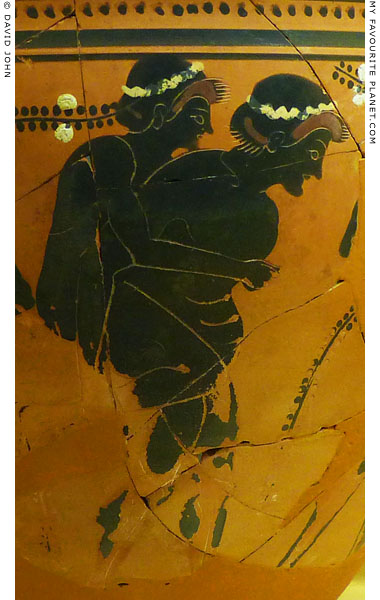
Detail of a fragmentary Attic black-figure skyphos
depicting two youths playing ephedrismos.
Side B. The same scene of youths, including two
sets of boys playing ephedrismos, is painted on
both sides with small variations.
By the Theseus Painter, around 500 BC. Found in
1932 in the Ancient Agora, Athens. Height (with
restored foot) 19.3 cm, diameter at rim 25.3 cm.
Agora Museum, Athens. Inv. No. P 1546. |
|
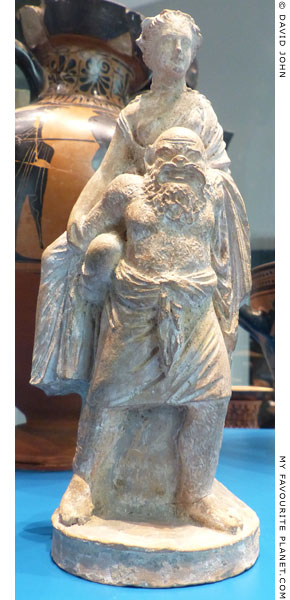
Ceramic figurine of a Silen carrying a
young woman, perhaps a Nymph or
Maenad, in a game of ephedrismos.
From Boeotia or Megara, Greece,
early 3rd century BC. Height 22.3 cm.
Museum für Kunst und Gewerbe
Hamburg. Inv. No. 1927.40.
From the Charles Seltmann Collection. |
|
| |
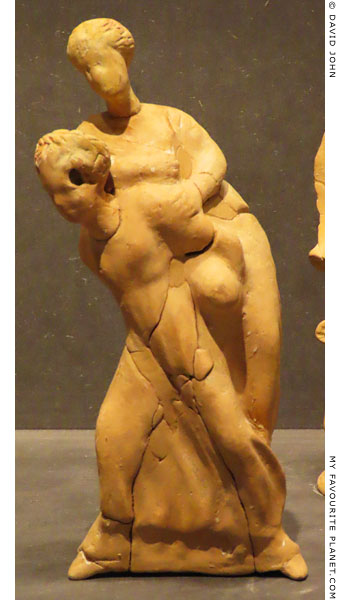
A terracotta figurine of two girls
playing ephedrismos.
Hellenistic period. From a child's grave in Corfu.
Corfu Archaeological Museum. |
|
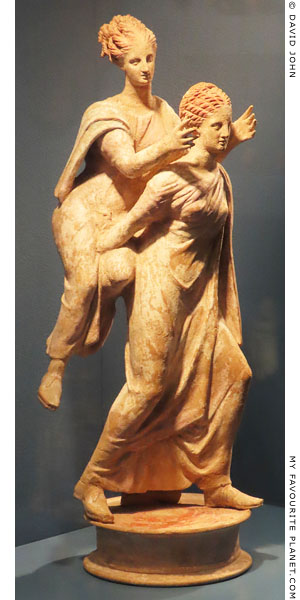
A terracotta figurine of two girls
playing ephedrismos.
Hellenistic period, 1st half 3rd century BC.
From Corinth or Taranto. Height 43 cm.
Allard Pierson Museum, Amsterdam.
Inv. No. APM 1891 (vitr. 263). From the
collection of Constant Willem Lunsingh
Scheurleer (1881-1941), for whom it
was purchased on the Paris art market.
One of two ephedrismos groups in the
museum (the other is not on display), it is
the tallest terracotta ephedrismos group
known and one of the best preserved.
Traces of surviving colour include red in
the hair, and blue and lilac on the himation. |
|
| |
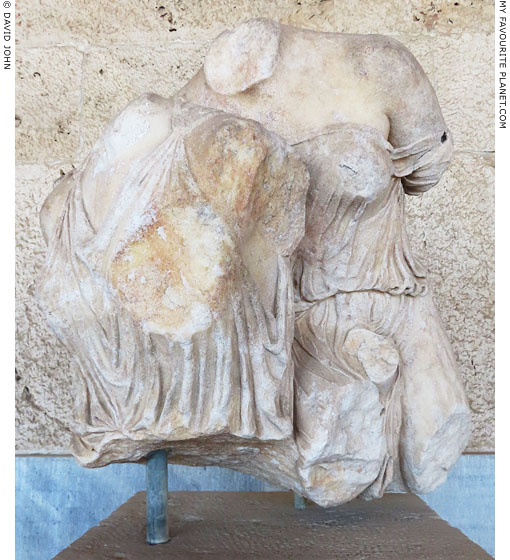
Parts of a marble statue group of two girls playing ephedrismos.
Around 420 BC. Perhaps an akroterion or pedimental sculpture
of the Temple of Hephaistos in the Athenian Agora.
Agora Museum, Athens. Inv. No. S 429. |
|
16. P. Licinius Priscus Iuventianus and the sanctuaries at Isthmia
The inscribed stele was apparently taken to Verona on behalf of the writer, antiquarian and art collector Francesco Scipione, Marchese di Maffei (1675-1755) who founded the Museo Lapidario Maffeiano, one of Europe's oldest archaeological museums.
Apart from this inscription, two fragments of another inscribed stele found at Corinth and Isthmia (see below) and other inscriptions which appear to mention him, nothing is known about P. Licinius Priscus Iuventianus. He is decribed on the Verona stele as "P(ublius) Licinius, P(ublius') s(on), (of the) Aem(ilian tribe), Priscus Juventianus, lifelong high priest". He appears to have been a wealthy Roman citizen, perhaps from an influential local Greek family, who, like other elite figures such as Herodes Atticus and Aulus Claudius Charax of Pergamon, flourished during Roman imperial rule and financed public and religious institutions.
See:
Jacob Spon's account of the inscription at Isthmia:
Jacob Spon (1647-1685), Voyage d'Italie, de Dalmatie, de Grèce et du Levant, Tome II, page 294 (in French). Antoine Cellier et fils, Lyon, 1678. At Heidelberg University Digital Library.
Spon and Wheler's transcription of the inscription:
Jacob Spon, Voyage d'Italie, de Dalmatie, de Grèce et du Levant, Tome III, Contenant les inscriptions de chaque ville & leur explication, avec quelques médailles & autres monumens antiques, pages 225-227. Antoine Cellier et fils, Lyon, 1678. At Heidelberg University Digital Library.
Oscar Broneer (1894-1992), An Official Rescript from Corinth. Hesperia, Volume 8, No. 2 (April - June, 1939), pages 181-190. The American School of Classical Studies at Athens (ASCSA). At jstor.org.
Broneer discusses Priscus and his benefactions at Isthmia in the light of part of another inscribed stele which had recently been discovered at Corinth (Corinth, Inv. No. I 2194, see photo, right). The article includes photos of the new stele fragment and the stele in Verona (IG IV 203).
Daniel J. Geagan, The Isthmian Dossier of P. Licinius Priscus Juventianus. Hesperia, Volume 58, No. 3 (July - September 1989), pages 349-360. The American School of Classical Studies at Athens (ASCSA). At jstor.org.
This article reexamines the inscriptions discussed fifty years earlier by Broneer. In the meantime another fragment of the second stele had been discovered at Isthmia in 1954 (Isthmia, Inv. No. I 261, see photo, right), which includes the information that Priscus was also an agoranomos (ἀγορανόμος, an official who controlled the marketplace) of the Isthmian festival, and that he built a stoa with shops next to the stadium used for the Isthmian games. Geagan discusses evidence which points to Priscus' identity and asks whether the two steles may have been originally set up at the Temple of Poseidon at Isthmia. He includes the original Greek text of the inscriptions and translations as well as a photo of the later fragment from Isthmia.
The Greek text of inscription IG IV 203: epigraphy.packhum.org/text/27699 at The Packard Humanities Institute.
Francesco Camia, IG IV 203: la cronologia di P. Licinius Priscus Iuventianus, archiereus della Lega achea. ASAtene 80 (2002), pages 361-378 (in Italian). Scuola archeologica italiana di Atene. At academia.edu.
Mario Torelli, P. Licinius Priscus Iuventianus e la ricostruzione antonina del Palaimonion di Istmia, in Dialéctica histórica y compromiso social. Homenaje Domingo Plácido, pages 555-582 (in Italian). Madrid, 2010. At academia.edu. |
|
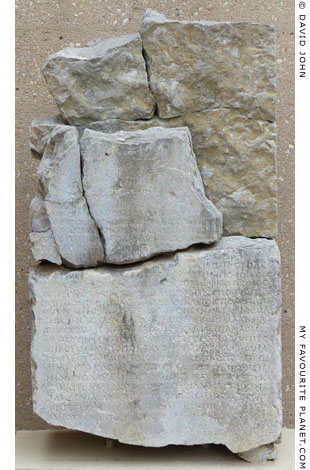
Fragments of a limestone stele
with an inscription referring to
P. Licinius Priscus Iuventianus.
2nd century AD.
Corinth Archaeological Museum.
Bottom fragment, found in 1934 in the
colonnade of the South Stoa, Ancient
Corinth. Inv. No. I 2194 (lines 14-32).
Top fragments, found in 1954 in
the Fortress of Justinian, Isthmia.
Inv. No. I 261 (lines 1-14). |
|
|
17. Pyrgos Archaeological Museum
It may appear surprising that finds from the Sanctuary of Demeter Chamyne are not exhibited in Olympia itself, particularly given the importance of the cult to aspects of the Olympic festival, albeit little documented and so far not fully explored. Olympia, after all, has two large museums, and until very recently three (including the now closed Museum of the Olympic Games). Surely it had room for a handful of objects from the sanctuary? The collections and exhibitions in the two museums have recently been reorganized, and perhaps the finds at the sanctuary were unearthed too late to be included in the new scheme.
The Archaeological Museum of Pyrgos has also recently had a major renovation, and perhaps the Demeter Chamyne discoveries were a happy coincidence which led to the finds being brought there. It functions as a regional museum for the area of Elis in general, supplementing other museums such as those at Olympia and Elis.
The exhibition is organized in chronological sections, from prehistory to the Byzantine era, with display cases containing finds from particular locations or objects illustrating a theme (daily life, death, religion, etc). The fact that most exhibits are in glass-fronted cases, combined with the general and specific lighting in the museum rooms, makes some objects difficult to view, particularly due to reflections. Most labels for individual objects are in Greek and English, while the information boards describing historical, geographical and archaeological contexts (including local maps) are in Greek only. There is no guide book for the museum. There are no spectacular objects or star attractions, but there are some charming and unusual ancient works of art, thoughtfully arranged to provide an overview of the history of the people who lived, worked and worshipped in this fascinating area over thousands of years. The building itself is also attractive, and a visit is definitely worth at least an hour of your time.
The building is in a side street, around five minutes walk from the centre of Pyrgos, but is not easy to find. None of the local people I asked knew where it was, and most were unaware that it even existed. This may be due to the fact that it was closed so long for renovation. There are a few brown cultural signposts around town pointing in the general direction of the museum, but with no indication of the distance. As is often the case, the nearer you get, the fewer signs are to be found. I could find no map of the town, although it is admittedly small, and the Google map marked the museum in the wrong place. Presumably that has since been corrected.
Pyrgos (Πύργος) is a pleasant market town, without any particular sightseeing attractions. It provides a good base for visiting other places in the area, and has inter-city bus connections to Athens (4 - 5 hours), Thessaloniki (9 hours, via Larissa and Lamia), Ioannina, Patras, Kalamata and Tripolis (for Sparta). There are even two buses a day to Lala! At present there are no trains to Pyrgos or Olympia.
If you are travelling to Olympia by public KTEL bus from elsewhere in Greece, you will most likely have to change buses at Pyrgos bus station, which is at the edge of the town. From there it is around 15-20 minutes walk to the museum. We recommend taking a local bus or taxi. If you are staying at Olympia, frequent local buses travel to and from Pyrgos bus station (16 km west of Olympia, around 20 minutes), and you can get on or off in Pyrgos town centre for the museum.
18. Pausanias on Kleoboia
In other translations of this passage, the sentence "Those on board the boat are not altogether distinguished" has been rendered to suggest that the figures in the painting are indistinct: either the scene in the ancient painting was not easy to distinguish, or Pausanias found the significance of the scene difficult to discern. In section 1 of the chapter he wrote "the forms of the fishes [in the river Acheron] appear so dim that you will take them to be shadows rather than fish". This may reveal something of Polygnotos' style or indicate that the figures in the painting, perhaps a fresco, had become less clear over the five centuries between its creation and the writer's visit to Delphi.
Pausanias also described the other paintings in the Knidian Lesche (probably a stoa), the largest of which depicted the Ilioupersis (the sacking of Troy), and another showed Odysseus' visit to Hades (Homer, The Odyssey, Books 10-11). Both these Homeric stories would have been familiar to all Greeks, but the figures of Kleoboia and Tellis may have not been so universally known. The scene is evidently connected to the legendary history of Paros and the founding myths of Thasos and its Thracian colonies, which may have been celebrated in the lost poems of Archilochus, and would have been well known to Polygnotos as a Thasian.
The exact date of the paintings is unknown, but they are thought to have been painted in the mid 5th century BC, when Polygnotos was living in Athens. The Thasians revolted against the Delian League around 465-463 BC, but were defeated by the Athenians who forced them to destroy their walls, surrender their ships and give up their possessions on the mainland.
The paintings are discussed in detail in:
Robert B. Kebric, The paintings in the Cnidian Lesche at Delphi and their historical context. Brill, Leiden, 1983. |
|
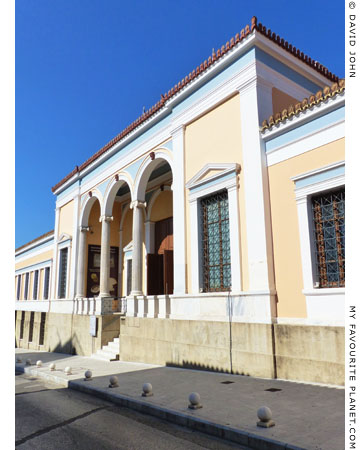
The recently renovated Archaeological Museum
of Pyrgos in the old Neoclassical market hall.
Designed by the German architect Ernst Ziller
(1837-1923), the Old Municipal Market
(Παλαιά Δημοτική Αγορά, Palaia Demotiki Agora)
was built in 1890.
Pyrgos Archaeological Museum
(Αρχαιολογικό Μουσείο Πύργου)
Old Municipal Market
Odos Karaiskaki 10, Pirgos 27100.
Tel: +30 2621 020475
pirgosmuseum.weebly.com
Opening hours:
Tuesday - Sunday 8:00 - 15:00.
Mondays closed. |
|
|
19. Archaeology at the Pella Thesmophorion
Μ. Λιλιμπάκη-Ακαμάτη, Το Θεσμοφόριο της Πέλλας (The Thesmophorion of Pella), Ταμείο Αρχαιολογικών Πόρων (ΤΑΠ, Archaeological Receipts Fund, TAP), Ministry of Culture, Athens, 1996. 112 pages, illustrated. 18 Euros. www.tap.gr.
The veteran archaeologist Dr. Maria Lilimpaki-Akamati, now Honorary Curator of Antiquities, has written and co-authored several books and articles on the history and archaeology of Macedonia, including two excellent guides to Pella (see Further reading about Pella). This book, which was described in one review as "a work of pure archaeology", remains the standard work on the Pella Thesmophorion and one of the few which discusses the site in any depth. Unfortunately, it is only available in Greek and its seems unlikely that it will be translated into other languages in the near future.
More recently archaeologist Liana Gelou (presently at the Ephorate of Antiquities of Florina), wrote a fascinating study and proposal for the conservation, restoration and presentation the Pella Thesmophorion. This broad-ranging illustrated work discusses the history of Pella, including a description of the Pella archaeological site and its sanctuaries, and examines the worship of Demeter, its rituals and the thesmophoria at various sites around the ancient Greek world. The numerous illustrations include maps, plans, and photos of archaeological sites and finds.
Γκέλου Λιάνα Γεωργίου, Το Θεσμοφόριο της Πέλλας: Μελέτη-Πρόταση Συντήρησης, Αποκατάστασης και Ανάδειξης (The Thesmophorion of Pella: Study and proposal for its conservation, restoration and presentation), Aristotle University of Thessaloniki, 2012. In Greek with an abstract in English. 218 pages, illustrated. PDF document at IKEE, Aristotle University of Thessaloniki Library.
While it is vital that archaeologists publish their findings in their own language (Greek, Turkish, Bulgarian, Serbian, Albanian, etc), financial and political considerations often mean that many important works are not translated and their contents remain unknown to reseachers, students and the public in other countries.
20. The Thesmophoria
The annual festival of Thesmophoria (Θεσμοφόρια), held in honour of Demeter Thesmophoros, is thought to have been held in October, at the time of seed-sowing. The best known Thesmophoria is the one held in Athens. The main sources of information on the festival are Aristophanes' comedy Thesmophoriazousai (Θεσμοφοριάζουσαι, Women celebrating the Thesmophoria), first produced in 411 BC, and its scholia (commentaries), and a Byzantine scholion on Dialogues of the Courtesans (Dialogi Meretricii, 2.1) by Lucian of Samosata (circa 125-180 AD, see Aetion), which provides the only description of the secret rites.
See:
Matthew Dillon, Girls and Women in Classical Greek Religion. Routledge, London, 2002.
Allaire Stallsmith, Interpreting the Athenian Thesmophoria. The Classical Bulletin 84 (2009), pages 28-45. Word Document (.docx) at academia.edu.
A discussion of ancient and modern literary sources concerning the Thesmophoria. Includes a translation of the scholion on Lucian's Dialogues of the Courtesans.
Katherine R. L. McLardy, The megara of the Thesmophoria: Reconciling the textual and archaeological records. Chronika, Volume 5, pages 1-6. Institute for European and Mediterranean Archaeology, State University of New York at Buffalo, 2015. PDF at chronikajournal.com.
The article briefly surveys the literary and archaeological evidence (from Eleusis, Mytilene, Priene, Knidos and other sites) for the existence, forms and use of megara in the Thesmophoria.
21. Pausanias on Demeter Malophoros
Pausanias, Description of Greece, Book 1, chapter 44, section 3. At Perseus Digital Library.
22. Jean Hulot and Gustave Fougères on Selinunte
Jean Hulot and Gustave Fougères, Sélinonte: la ville, l'acropole et les temples. Librairie Générale del'Architecture et des Arts Décoratifs, Paris, 1910. At the University of Heidelberg Digital Library.
23. Demeter and Poseidon
See:
George E. Mylonas, Mycenae and the Mycenaean Age. Princeton University Press, 1966.
Demeter Myths: 3 Loves and Areion at theoi.com.
24. Phigalia and Mount Elaion
There are a number of different spellings for Phigalia (e.g. Φιγαλέα, Φιγαλεία, Φιγαλία) by ancient authors, who mentioned several sanctuaries and temples in its territory. One of the best known is Phigalia's Temple of Apollo Epikourios (Apollo the Helper) at nearby Bassai, which was first excavated in 1811 by Charles Robert Cockerell and his companions (see the Niobe page).
Pausanias (Description of Greece, Book 8, chapters 41-42) reported that the city was flanked by two mountains, Kotilion (Κωτίλιον) and Elaion (Ἐλάιον). Bassai stood on Mount Kotilion, "about forty Stades " from the city. Mount Elaion, "some thirty stades away from Phigalia", was identified as the 1389 metre high Mount Tetrazi (or Tetrazio, Τετράζιο Όρος) by William Martin Leake (Travels in the Morea, Volume 2 (of 3), pages 10-12. J. Murray, London, 1830).
25. The "Well of Artemis" in Syracuse
The "Well of Artemis" or "Artemis Well" in the Piazza della Vittoria should not be confused with the Well and Temple of Artemis next to the cathedral in Ortygia.
26. Hyginus on Liber, son of Jove and Proserpine
Fabulae, a collection of brief summaries of Greek and Roman myths and mythological genealogies, has been attributed to Gaius Julius Hyginus (circa 64 BC - 17 AD), but may be the work of a later author, perhaps also named Hyginus, sometimes referred to as Pseudo-Hyginus or Hyginus Mythographus. For further details, see the note in Homer part 2. Liber (Dionysus) is mentioned three times as the son of Jove (Zeus) and Proserpine (Persephone).
155. Sons of Jove
"Liber by Proserpine, whom the Titans dismembered. Hercules, by Alcumena. Liber by Semele, daughter of Cadmus and Harmonia."
167. Liber
"Liber, son of Jove and Proserpine, was dismembered by the Titans, and Jove gave his heart, torn to bits, to Semele in a drink. When she was made pregnant by this, Juno [Hera], changing herself to look like Semele’s nurse, Beroe, said to her: 'Daughter, ask Jove to come to you as he comes to Juno, so you may know what pleasure it is to sleep with a god.' At her suggestion Semele made this request of Jove, and was smitten by a thunderbolt. He took Liber from her womb, and gave him to Nysus to be cared for. For this reason he is called Dionysus, and also 'the one with two mothers'."
179. Semele
"Jove desired to lie with Semele, and when Juno found out, she changed her form to that of the nurse Beroe, came to Semele, and suggested that she ask Jove to come to her as he came to Juno, 'that you may know', she said, 'what pleasure it is to lie with a god'. And so Semele asked Jove to come to her in this way. Her request was granted, and Jove, coming with lightning and thunder, burned Semele to death. From her womb Liber was born. Mercury snatched him from the fire and gave him to Nysus to be reared. In Greek he is called Dionysus."
The Myths of Hyginus, translated and edited by Mary Amelia Grant. University of Kansas Publications in Humanistic Studies, No. 34. University of Kansas Press, Lawrence, 1960.
Fabulae, sections 150-199 at the Theoi Project.
27. Dionysios II tyrant of Syracuse
Dionysios II, or Dionysios the Younger (Διονύσιος ὁ Νεώτερος, circa 397-343 BC), ruled 367-357 BC and again 346-344 BC. He was the son of Dionysios I, or Dionysios the Elder (Διονύσιος ὁ Πρεσβύτερος, circa 432-367 BC), who was tyrant 405-367 BC. When Dionysios the Elder died, his brother-in-law Dion (Δίων ὁ Συρακόσιος, 408–354 BC) tried to guide the inexperienced younger Dionysius, and even invited the Athenian philosopher Plato to Syracuse to be his teacher, in a failed attempt to transform him into a philosopher-king.
28. Timoleon's crossing
See, for example:
P. J. Bicknell, The date of Timoleon's crossing to Italy and the comet of 361 B.C.. In: The Classical Quarterly, Volume 34, No. 1 (1984), pages 130-134. Cambridge University Press. At Jstor.
29. The "Demeter relief" from Pergamon
See: Wilhelm Dörpfeld, Hugo Hepding, Die Arbeiten zu Pergamon 1908-1909. Mitteilungen des Deutschen Archäologischen Instituts, Athenische Abteilung Band 35, Seiten (pages) 509-511, Tafel (plate) XXIX, 2. Eleutherudakis und Barth, Athens, 1910.
30. Vitruvius on the temple of Ceres in Rome
"In araeostyles we cannot employ stone or marble for the architraves, but must have a series of wooden beams laid upon the columns. And moreover, in appearance these temples are clumsy-roofed, low, broad, and their pediments are adorned in the Tuscan fashion with statues of terra-cotta or gilt bronze: for example, near the Circus Maximus, the temple of Ceres and Pompey's temple of Hercules; also the temple on the Capitol."
Vitruvius, On Architecture (de Architectura), Book 3, chapter 3, section 5. At Bill Thayer's LacusCurtius website, University of Chicago. |
|
|
| |
| |
Photos on the Demeter and Persephone pages were
taken during visits to the following museums:
Germany
Berlin, Altes Museum
Berlin, Bode Museum
Berlin, Pergamon Museum
Dresden, Skulpturensammlung, Albertinum
Hamburg, Museum für Kunst und Gewerbe
Potsdam, Neues Palais, Sanssouci
Greece
Abdera Archaeological Museum
Amphipolis Archaeological Museum
Athens, Acropolis Museum
Athens, Agora Museum
Athens, Epigraphical Museum
Athens, National Archaeological Museum
Athens, Olympieion and Ilissos Shrines archaeological site
Corfu Archaeological Museum
Corinth Archaeological Museum
Corfu, Museum of Mon Repos
Delphi Archaeological Museum
Dion Archaeological Museum, Macedonia
Drama Archaeological Museum, Macedonia
Eleusis Archaeological Museum and site, Attica
Isthmia Archaeological Museum
Kavala Archaeological Museum, Macedonia
Kos Archaeological Museum, Dodecanses
Olympia Archaeological Site
Pella Archaeological Museum, Macedonia
Pella, Thesmophorion archaeological site
Pyrgos Archaeological Museum
Rhodes Archaeological Museum
Rhodes, Palace of the Grand Master
Thessaloniki Archaeological Museum, Macedonia
Italy
Milan, Civic Archaeological Museum
Naples, National Archaeological Museum
Ostia Archaeological Museum and site
Paestum, National Archaeological Museum
Rome, Capitoline Museums, Palazzo dei Conservatori
Rome, National Etruscan Museum, Villa Giulia
Rome, National Museum of Rome, Baths of Diocletian
Rome, National Museum of Rome, Palazzo Altemps
Rome, National Museum of Rome, Palazzo Massimo
Rome, Villa Farnesina, Trastevere
Italy - Sicily
Castelvetrano, Museo Civico
Catania, Museo Civico, Castello Ursino
Gela Regional Archaeological Museum
Palermo, Antonino Salinas Regional Archaeological Museum
Selinunte Archaeological Park
Selinunte, Baglio Florio Museum (Antiquarium)
Syracuse, Paolo Orsi Regional Archaeological Museum
Syracuse, Piazza della Vittoria Archaeological Zone
Netherlands
Amsterdam, Allard Pierson Museum
Leiden, Rijksmuseum van Oudheden
Turkey
Bergama Archaeological Museum
Istanbul Archaeological Museum
Izmir Archaeological Museum
Izmir Museum of History and Art
United Kingdom
London, British Museum
Oxford, Ashmolean Museum
Many thanks to the staff of these museums. |
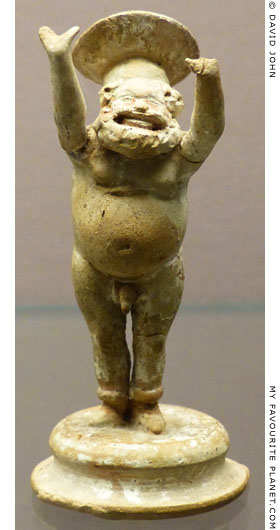
Terracotta comic figure made
at Knidos around 300 BC.
From the sanctuary of Demeter at
Knidos (see part 2), Yazıköy, Turkey.
The figurine depicts either an actor, or
a buffoon of the type believed to have
played a role in the Mysteries of Demeter.
British Museum.
Inv. No. GR 1859.12-26.830
(Terracotta C 473). |
|
| Photos and articles © David John, except where otherwise specified. |
 |
Visit the My Favourite Planet Group on Facebook.
Join the group, write a message or comment,
post photos and videos, start a discussion... |
|
|
| |
| Copyright © 2003-2025 My Favourite Planet | contributors | impressum | contents | sitemap |
| |














































































































































